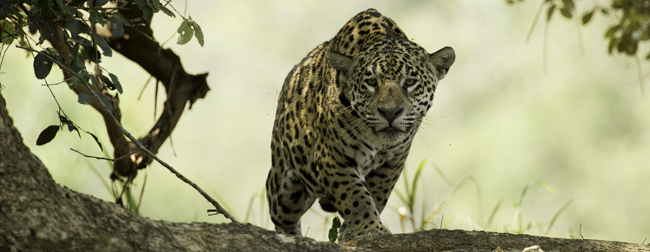
Trip Reports:
Jaguars and the Wildlife of the Pantanal
2014
Trip Two
Read the reports for
The Summary of all three trips
Trip One
and the
Southern Pantanal Extension


Diversity is perhaps the best word to describe our second Photo Tour of 2014 in the Northern Pantanal. As we had in the first Tour, we were lucky to again photograph a Giant Anteater that was incredibly tame and visited one of our lodges regularly. While June and July brought out of season heavy rains that had swelled the Pantanal's rivers and pools, by the time of the second tour water levels were back to normal and the Caimans and Capybaras were back on the river banks and sand bars, offering tempting meals for hunting Jaguars.
Oddly, in contrast to the first Tour when we saw more male Jaguars than females, and a third of these were collared, most of the Jaguars we saw on the second Tour were females, and we saw not a single Jaguar wearing a collar. One of the highlights, and potentially one of the all-time low points, was watching George, one of the most habituated Jaguars of last year, hunting a small family of Capybaras. As you read on, you'll see why it was one, and could have been the other.
The highlight of this Tour for several of us was the Jaguar, Patricia, that my skiff found as she rested on an open bank in the Black Lagoon. Although we eventually shared this sighting with a nightmarish traffic jam of twenty boats, most of our skiffs were positioned securely in a bed of water hyacinths and in a great position. There I got one of my 'dream shots,' one I've envisioned for years, and that was of a Jaguar stalking directly towards me on a sand bank. Although I often wondered how I could accomplish this, since being on a sand bank at the same time could create some obvious problems, the position of Patricia and our boat worked perfectly. In fact my friend Tom, who was behind me as we shot this, wondered whether the Jaguar had had a bead on me and was stalking me. Of course, he just kept shooting and only mentioned this later! We think the jaguar was drawn by a Caiman that must have sunk beneath the aquatic vegetation before the Jaguar could launch an attack.
Check out our Jaguars and the Wildlife of the Pantanal book.
The following is the daily journal of the trip:
Day 1 – Arrival in Sao Paulo to Cuiaba to Curicaca, Pantanal
Tom and I were dropped off at Corakaka where we spent the day, while our 2nd group flew in. I spent 5 hours setting up two camera traps for fish-eating bats, and another on a game trail. The bat setup took up most of my time as I had to secure a Range IR out over open water and position flashes to light up the target area. Although in retrospect I probably would have been better off just wading in the Caiman-filled waters to place my poles, instead I used a moored skiff as my base. Every time I shifted position the boat moved, threatening to knock over my Range IR or flashes. To prevent this, I ended up making a 'dock' out of bamboo poles to secure the boat's lateral movement. Although I was completely unsuccessful in getting a Fishing Bat photo (and saw none over the water that night), I learned some very valuable lessons in improvising which will make future setups in remote locations much easier. There is alwalys a positive side!
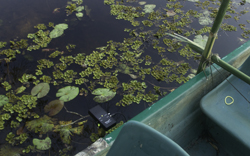
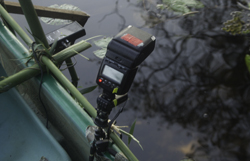
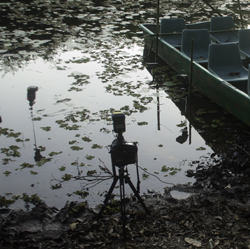
My fishing bat setup, using a RRS TP-243 Ground 'Pod for securely anchoring my camera into the mud. This pod has easily cleaned telescoping legs with spikes at one end, so I felt comfortable and safe leaving the camera unattended while six-foot long Caimans stalked the shoreline. I made sure I had the bottom legs sunk deep into the mud and unless a Caiman tried eating the gear I knew it would be safe.
The group’s flight was an hour late, and the group arrived at 6:30, long after sunset. Fortunately no one lost luggage and except for being tired, we were off to a good, stressfree start.
Day 2 - Curicaca to Pouso Alegre
Everyone was up at 6 to be at the feeders, but activity was fairly slow. Bill B got an excellent sequence of a Great Potoo actually doing something, preening and stretching. Normally they sit immobile, like a broken limb. I checked my cameras, and got nothing, although the game trail camera may have false fired with the sensor picking up backgrounds. It was a good set and would have resulted in a beautiful photograph had a tapir or puma wandered down the trail. I'm anxious to try this again next year!
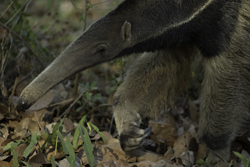
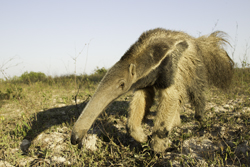
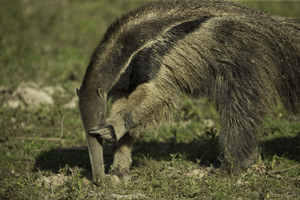
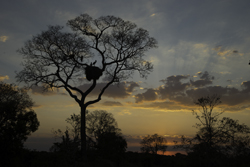 We headed to the main road for more shooting, but aside from acquainting folks with the wildlife the shooting was slow and routine. After lunch we headed to PL and our rooms were not ready. I went around the back of the lodge to try to Skype Mary, and spotted the Giant Anteater in the pasture. We spent the next 1.5+ hours with the anteater, sometimes coming so close it sniffed people.
We headed to the main road for more shooting, but aside from acquainting folks with the wildlife the shooting was slow and routine. After lunch we headed to PL and our rooms were not ready. I went around the back of the lodge to try to Skype Mary, and spotted the Giant Anteater in the pasture. We spent the next 1.5+ hours with the anteater, sometimes coming so close it sniffed people.
At 4:30 we headed on the truck for a sunset shot and night game drive, and had a great sunset which we framed with the Jabiru Stork nest, occupied by the 2 adults and 2 chicks. We waited on tapir without success, and checked two waterholes. A Brocket Deer fed on the edge of a woodline, then darted off in fear. We soon saw why -- a innocuous Crab-eating Fox trotted by.

On the return, a Caiman on the road had a large freshly caught eel, and after everyone finished shooting I used the lights to hide my approach, to photograph the caiman at about 4 feet.
We returned by 7, and after yesterday’s work and a very busy day today, I gave Mary a quick Skype call, and crashed, exhausted.
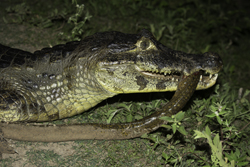
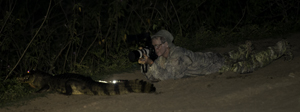 .
.
The Caiman was eating a large eel. Although I was close to the Caiman, because of my flashlight I was in the dark and invisible to the Caiman, despite how it might look.
Right, Judy Johnson photo.
Day 3. Pouso Alegre to South Wild Lodge
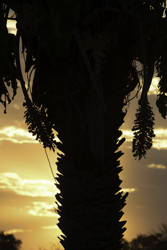 Everyone was out by 6, chasing the Hyacinth Macaws which were perched in a tree close to their nest tree. A Crimson-crested and a Green-barred Woodpecker were nesting in old palms, and were cooperative, as was a few Capuchin Monkeys. The giant anteater, nor the rheas appeared, and the ladies, Judy, Mary, Cathy, and Doris, went to the Jabiru Stork nest with Marcos, and after waiting, leaving, and returning, the adult finally appeared and regurgitated water and fish to the hungry young. I checked out the marsh for Marsh Deer – unsuccessfully, and spent the remainder of my morning trying to find various misplaced items in my luggage, while the others relaxed.
Everyone was out by 6, chasing the Hyacinth Macaws which were perched in a tree close to their nest tree. A Crimson-crested and a Green-barred Woodpecker were nesting in old palms, and were cooperative, as was a few Capuchin Monkeys. The giant anteater, nor the rheas appeared, and the ladies, Judy, Mary, Cathy, and Doris, went to the Jabiru Stork nest with Marcos, and after waiting, leaving, and returning, the adult finally appeared and regurgitated water and fish to the hungry young. I checked out the marsh for Marsh Deer – unsuccessfully, and spent the remainder of my morning trying to find various misplaced items in my luggage, while the others relaxed.
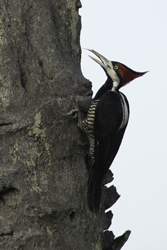
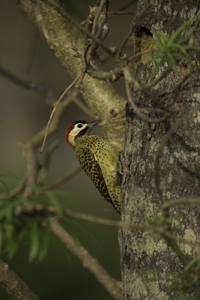
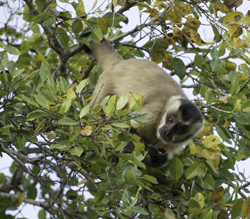
Crimson-crested Woodpecker female; Green-barred Woodpecker, Capuchin Monkey
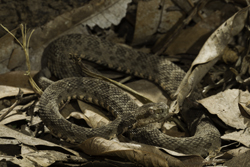 In the late morning I had another chance to photograph a captive Bothrops viper, a venomous species that is often called a Fer-de-lance. The ranch owner, who normally handles or controls the snake had to leave, giving me a chance to patiently work with the snake and pose it. Understandably the rancher is concerned with safety, as am I, but I can see why, too, when the snake practically flipped a 180, reversing directions so fast that had it been aggressive, and had I been closer, a dangerous situation could have developed. As it was, I was out of danger and the snake wasn't aggressive or stressed and we finished the shoot nicely.
In the late morning I had another chance to photograph a captive Bothrops viper, a venomous species that is often called a Fer-de-lance. The ranch owner, who normally handles or controls the snake had to leave, giving me a chance to patiently work with the snake and pose it. Understandably the rancher is concerned with safety, as am I, but I can see why, too, when the snake practically flipped a 180, reversing directions so fast that had it been aggressive, and had I been closer, a dangerous situation could have developed. As it was, I was out of danger and the snake wasn't aggressive or stressed and we finished the shoot nicely.
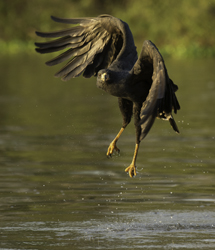 Since we had great luck with the anteater, we headed directly to PWC after lunch, arriving around 3. We had hoped to visit the tower here for Capuchin monkeys, but none had been seen in the last few days. Instead, we traveled upriver and had a few sessions with Greater Black Hawks and Black-collared Hawks, and Ringed Kingfishers. The shooting was pretty successful.
Since we had great luck with the anteater, we headed directly to PWC after lunch, arriving around 3. We had hoped to visit the tower here for Capuchin monkeys, but none had been seen in the last few days. Instead, we traveled upriver and had a few sessions with Greater Black Hawks and Black-collared Hawks, and Ringed Kingfishers. The shooting was pretty successful.
Afterwards we headed to the Cattle Egret roost, and although birds came in in rather large flocks, none massed for striking congregations. Afterwards, I armed a camera trap close to the lodge – not having sufficient time to head into the jungle. At 6:45 we did a star trail/milky way scene that I scouted out before dark. Unfortunately, I took the wrong track and we walked about 100 yards before I realized the error, then backtracked around the little pond where I had the camera trap to reach the location where I had left my camera. At the camera trap, a tiny Yellow Anaconda was eating a fish, which it carried into the water and disappeared from view. On our walk to where I had my camera I found another 18 inch long snake, collared somewhat like a Bothrops but, I believe, a nonvenomous species. Still, we left it alone.
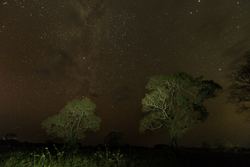

Two images, both with the foreground trees painted with a flashlight as we did a long exposure for the stars. I forgot the '500 Rule' which is this: Divide the number 500 by the focal length of the lens in use to get the number of seconds a star exposure can be before you record star streaks. We were all using wide-angle lenses and shutter speeds below 30 seconds, so it worked anyway. However, for my 16mm shots I could have had my shutter set at 500/16= 31 seconds. A great explanation for Astrophotography is given on page 45 of the latest RRS catalog or at this RRS link. The difference in color in the two images is due to the RAW processing, where I lowered the color temperature for the shot on the right.
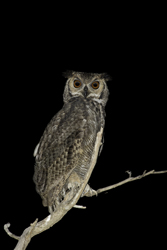 The star shooting went fairly successfully, although some shooters did not know how to set a slow shutter speed, but eventually everything got worked out. At 10PM I heard the Great Horned Owl chick, now looking just like an adult, wheezing for a parent to feed it, and with the help of one of the other guides, who held my focusing light, I managed several good shots.
The star shooting went fairly successfully, although some shooters did not know how to set a slow shutter speed, but eventually everything got worked out. At 10PM I heard the Great Horned Owl chick, now looking just like an adult, wheezing for a parent to feed it, and with the help of one of the other guides, who held my focusing light, I managed several good shots.
Day 4. South Wild to the Flotel, and Jaguar country
I checked my camera trap at dawn, and again had no luck. The Toco Toucans arrived on schedule, and since a Jabiru Stork was attending its deserted nest I went to the tower for some shots. Not much was happening, but after I left the male flew in and they mated – what would have been a worthwhile shot.
We left shortly after breakfast, arriving at Porto Joffre around 10:30, with enough time to state out the Hyacinth Macaw nest that is a short distance from the boat launch. Three macaws 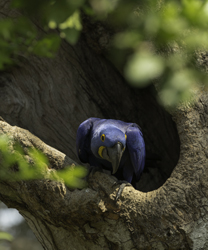 were at the nest tree, but oddly two of them spent most of their time exploring a hole low on the tree trunk, below the rails of the fence guarding the tree. Fortunately an adult eventually popped out of the nest hole, remained a moment, and flew off, and we headed for the boats.
were at the nest tree, but oddly two of them spent most of their time exploring a hole low on the tree trunk, below the rails of the fence guarding the tree. Fortunately an adult eventually popped out of the nest hole, remained a moment, and flew off, and we headed for the boats.
With our power boat, the same used by some of the companies, it took us 20 minutes to reach the Flotel, so for those staying in Joffre, that’s about 1.5 hours a day wasted, going fast upon the river.
We left at 2PM, and headed for the Black Lagoon. Since our last trip, someone had cleared the obstructing tree that blocked much of that channel (right where the jaguars were mating last trip). We headed upriver for another 30 minutes, with our boats being the only ones on this quiet stretch of river. It was beautiful, and had we had luck, it would have been superb.
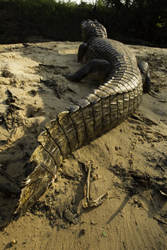 As it was, we photographed hawks, kingfishers, and Caimans, including one I did with a wide-angle where my lens was almost touching the caiman’s tail. When we circled the reptile, it obliged by yawning widely before settling itself into the sand. It was close to sunset when we reached the main river, and we headed upstream on the Three Brothers where, at Caiman Island, our boatman had a brief glimpse of a jaguar but no one in our boat saw it, so we did not count the encounter. No one else had luck, either. In the last light of the day, as the red sun hung just above the trees, we photographed Caiman framed by the streak of red, the reflections of the sun on the quiet bay.
As it was, we photographed hawks, kingfishers, and Caimans, including one I did with a wide-angle where my lens was almost touching the caiman’s tail. When we circled the reptile, it obliged by yawning widely before settling itself into the sand. It was close to sunset when we reached the main river, and we headed upstream on the Three Brothers where, at Caiman Island, our boatman had a brief glimpse of a jaguar but no one in our boat saw it, so we did not count the encounter. No one else had luck, either. In the last light of the day, as the red sun hung just above the trees, we photographed Caiman framed by the streak of red, the reflections of the sun on the quiet bay.
.
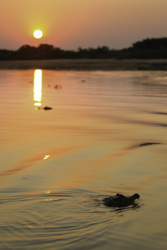
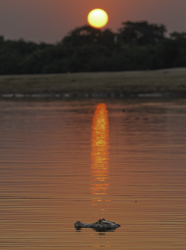
Day 5. Jaguar Country
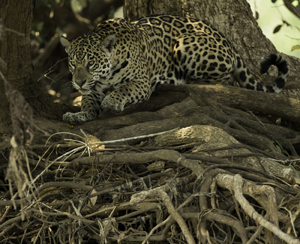 AM. We had five, and perhaps six different jaguars today, including one of the best sequences ever. My skiff headed up the Three Brothers River, and although I like going up the Black Lagoon, I thought this was a good choice, as the Lagoon is often better later in the morning. We explored a few side channels, then received a radio call that a cat was on the main river. We arrived, as one of multiple boats, and got a few shots before the cat wandered off. Another cat was spotted, and we raced to that location, again with a lot of boats. This happened a third time, and by then, nearly 9:15, I was disgusted by the crowds. We had shot each jaguar and I monumentally blew one round when, stupidly, I had my shutter speed at 1/40th and the aperture at f22. The exposures were good, but the motion! Gag!
AM. We had five, and perhaps six different jaguars today, including one of the best sequences ever. My skiff headed up the Three Brothers River, and although I like going up the Black Lagoon, I thought this was a good choice, as the Lagoon is often better later in the morning. We explored a few side channels, then received a radio call that a cat was on the main river. We arrived, as one of multiple boats, and got a few shots before the cat wandered off. Another cat was spotted, and we raced to that location, again with a lot of boats. This happened a third time, and by then, nearly 9:15, I was disgusted by the crowds. We had shot each jaguar and I monumentally blew one round when, stupidly, I had my shutter speed at 1/40th and the aperture at f22. The exposures were good, but the motion! Gag!
Mary and Tom agreed with my decision to head to the Lagoon, and soon after entering, at a point where I normally see a Green Tree Iguana sunbathing on a limb, our boatman spotted a Jaguar. We were the only boat, but of course he radioed the others (the frequency shared by two other large boat flotillas, too) and it wasn’t too long before we heard the drone of bees – the racing speed boats – entering the lagoon. Virtually every boat on the river was squeezed into the narrow 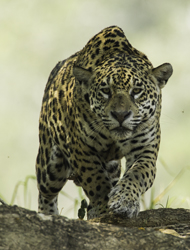 waterway that has been forced between the reed beds. We were in the prime position, and we remained there – all day.
waterway that has been forced between the reed beds. We were in the prime position, and we remained there – all day.
Mid-day the Jaguar got up and started stalking, its direction right, directly, towards our cameras and I made one of my ‘dream shots,’ a jaguar stalking straight at the camera. The hunt failed, and the cat returned to the spot where it was resting, where it appeared in view periodically as it scanned the surroundings for game. The light only got better, and despite the fact that no one had peed all day, we stayed in position. At 4:30 the Jaguar got up again, stalked towards us at an angle, then veered off. Earlier, while we watched this female (Patricia) another female appeared in view.
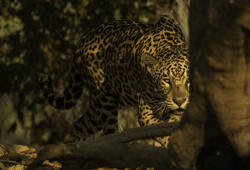
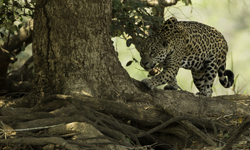
Additionally, one of our skiffs, with, I think, an impatient photographer, left to return for lunch and spotted either that female, or another, on the way back to the boat. When that skiff returned, they had another jaguar (perhaps the same one?) but this time it swam along the shore, and they shot over 100 images – so they were very happy. And lucky. With a great jaguar, the protocol is to not leave something so promising because 999 out of 1,000 times, you’ll get nothing for the effort. They had two jaguar sightings, so they were lucky exceptions to a very standard, and practical, rule.
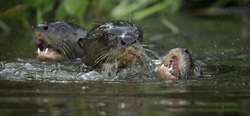
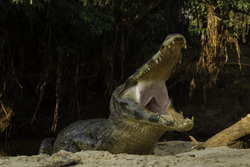
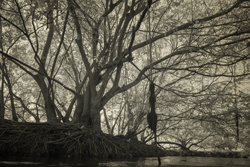
Day 6. Jaguar Country
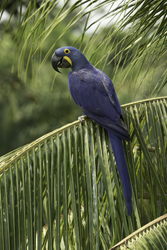 AM. We headed up the Pixiam River to a fishing lodge where I mistakenly understood that a Giant Armadillo, an extremely rare or seldom seen species, was visiting the lodge mid-morning. We’ve been to this fishing camp many times before, and it is usually good for Hyacinth Macaws and other birds. When we arrived, an Armadillo was foraging amongst a food pile with Black Vultures and Crested Caracaras, the latter leaving as we approached, leaving the remaining food for the armadillo, which was feeding on a papaya-like fruit. When it finished it ran off, and we followed it to its burrow, which was beside the sidewalk. Using some cooked rice we enticed the armadillo back out, and I disguised the terrible background, resulting in some beautiful shots of a Yellow or Six-Banded Armadillo. Marcos told us that the lodge owner actually picks them up and puts them on a spot, and sure enough, Marcos did the same, bringing over another armadillo, resembling a fat snapping turtle, and deposited it
AM. We headed up the Pixiam River to a fishing lodge where I mistakenly understood that a Giant Armadillo, an extremely rare or seldom seen species, was visiting the lodge mid-morning. We’ve been to this fishing camp many times before, and it is usually good for Hyacinth Macaws and other birds. When we arrived, an Armadillo was foraging amongst a food pile with Black Vultures and Crested Caracaras, the latter leaving as we approached, leaving the remaining food for the armadillo, which was feeding on a papaya-like fruit. When it finished it ran off, and we followed it to its burrow, which was beside the sidewalk. Using some cooked rice we enticed the armadillo back out, and I disguised the terrible background, resulting in some beautiful shots of a Yellow or Six-Banded Armadillo. Marcos told us that the lodge owner actually picks them up and puts them on a spot, and sure enough, Marcos did the same, bringing over another armadillo, resembling a fat snapping turtle, and deposited it 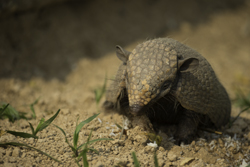 in front of the rice. The armadillo immediately started eating! This one must do this a lot, because when it turned its back it was enormous – truly fat, an obese armadillo. The one we had been shooting, which came out again, was of normal proportions.
in front of the rice. The armadillo immediately started eating! This one must do this a lot, because when it turned its back it was enormous – truly fat, an obese armadillo. The one we had been shooting, which came out again, was of normal proportions.
En route, we had a long, 45 minute session with 4 noisy Giant Otters, that swam up and down river, catching fish, and offering brief snatches of shots. After the fish camp we headed far upriver to a location where Wilson, a jaguar that the Panthera Organization had collared four years ago (and subsequently disappeared from view – a tragedy since this was one of the true stars in the jaguar world), was recently seen, identified by a photo. We didn’t see any jaguars, nor did anyone on the main jaguar routes this morning.

PM. We had three Jaguars this afternoon, and could have had a fourth had we endured the crowds in a narrow channel off the Three Brothers. As we headed upstream, speed boats raced by, all intent on reaching the reported jaguar. When we arrived at the turn-off, Marcos and one of our other boats were at the intersection, and Marcos was pointing out a Jaguar hidden deeply in the thick vegetation lining the riverbank. I craned forward, just to say I saw it, and saw a small patch of jaguar hide. I advised the group to leave it, as many were trying to photograph in an impossible situation, with images that were not even a thousandth as good as anything shot yesterday. We all moved on.
Further up river a young pair of Capybara splashed about playfully, but as we positioned ourselves another speed boat raced by, creating such huge waves that the rodents retreated deep into the grasses. Later, on another side channel, I had 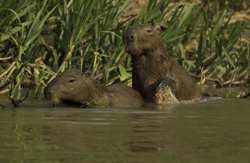 a pair of Capybara mating, the first time I’ve seen this.
a pair of Capybara mating, the first time I’ve seen this.
Capybaras are supposed to mate only in the water, although the naturalist on the boat says he’s seen a land mating. Our pair mated, or attempted to, at least six times in seven minutes, with the female swimming ahead of the male, then slowing in shallow water, allowing him to advance. In many ways it reminded me of Thompson’s Gazelles mating, with the chase involved, but in truth the female was not really avoiding the male. After the sixth or seven mating he seemed done, and spent his time rubbing his scent gland on vegetation lining the river, then coming ashore to roll in the mud. The female joined him there, where she sniffed his muzzle and also his back end, as if still soliciting a mating. He did not respond. A Caiman was lying nearby, with an odd pack of mud balled on his back, and she went up to him, first sniffing the mud, then moving up to the Caiman’s snout. He lunged away, annoyed, and she jerked away as well. Shortly afterwards the female moved on, swimming off, and, to me, appearing to be hunting for a more ardent mate.
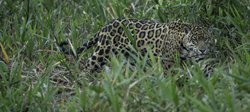 As we cruised home we received a radio call of another jaguar, which we reached just as the female, Patricia, pushed through tall grasses and walked along the sandy beach. I had to go to ISO 8000, but caught her as she charged across the sand, chasing something (but her legs were not visible), then leaping, in a nice sequence. By then the light had failed, and she was moving through tall vegetation where her progress was marked by shaking plants, not by views of her. We left for home.
As we cruised home we received a radio call of another jaguar, which we reached just as the female, Patricia, pushed through tall grasses and walked along the sandy beach. I had to go to ISO 8000, but caught her as she charged across the sand, chasing something (but her legs were not visible), then leaping, in a nice sequence. By then the light had failed, and she was moving through tall vegetation where her progress was marked by shaking plants, not by views of her. We left for home.
Jaguar count: 9, 6 the second day, 3 this evening.
Day 7. Jaguar country
AM. Judy, Don, and I spent a wonderful morning in the Black Lagoon, pushing up river past some shallow spots and ending up having the river entirely to ourselves – with Bill B, Doris, and Marcos in the other boat. Giant Otters were good, and we spent over an hour with them, and we did some fun stuff with Judy’s GoPro, using a telescoping pole to come up close to Caimans. Putting the camera underwater we got some unusual stuff, although the camera had to be within inches for the lens to see anything in the cloudy, brown water.
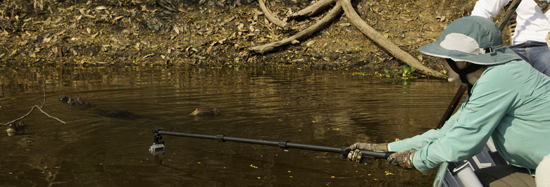
At 11 we returned to the Three Brothers, and shot a female Jaguar that eventually left the bank and hid in brush. Rather than wait her out we returned for lunch. Tom and Jerome had gone up river and found another female, and this one may be a new cat, giving Tom naming rights. Since it was my birthday, Tom called it McDonald Jaguar, but since it is a female, I hope it’ll be named Mrs. McDonald Jaguar! If it turns out to be a new cat! Bill and Cathy had a good jaguar encounter, too, with the same cat we came upon later. All told, a two cat morning and a good day.
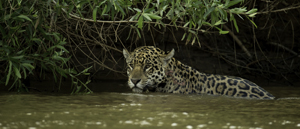
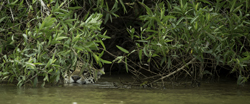
PM. We headed up river and discovered George, one of the normal ‘stars’ of the jaguar world. He was lying beneath a bush almost directly across from a family of Capybara on a sand bank. When he awoke he spotted the Capybaras, and made two attempts to cross the river but, we think, the boats discouraged him from crossing. He eventually crossed further upriver, but still down river from the capybaras. We raced upstream to get across from the rodents, tying ourselves in just seconds before we expected the hunt to occur. Unfortunately, one of the guides from the Flotel, and one of the boatmen we used on the last trip, decided to change their position and moved upriver, passing directly in front of all of our boats at the moment that the jaguar charged on to the beach. The capybaras escaped, but had he caught one, the shots would have been ruined.
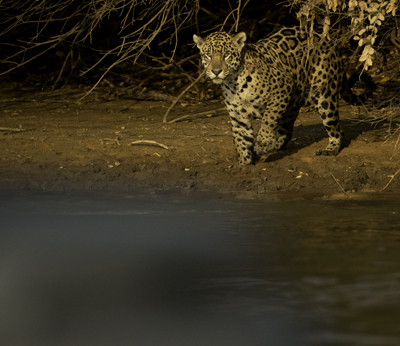
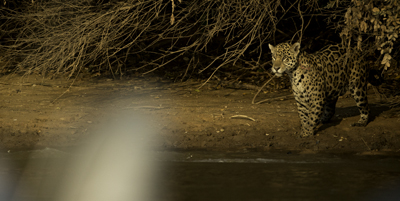
The boat passes, as we look, aghast! Etiquette on the river is important and
responsible companies and guides MUST lead the way. We were furious.
Everyone was livid, and I had our boat move up where I rather vehemently dressed down the guide, telling him he had acted quite selfishly, disregarding all the other photographers in line for the shot. When a boat is moving, those on a boat really can’t shoot, so moving at a critical moment like that does nothing for those photographers, while it certainly ruins it for everyone else who are waiting for the shot.
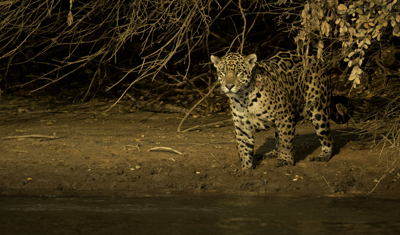 I felt poorly for the photographer with the guide, as that person had no control and no doubt felt embarrassed and guilty at the transgression. I assured that person that it wasn’t their fault, it was the guide’s, who should know better. I was especially annoyed because the boat traffic has gotten worse each year, and the company I use should be a leader in responsible guiding. Instead, behavior as shown tonight seemed to be an example of ‘screw them, I’m out for myself’ and that attitude can be contagious and virulent. We stayed upstream, hoping George would move upstream but I learned
I felt poorly for the photographer with the guide, as that person had no control and no doubt felt embarrassed and guilty at the transgression. I assured that person that it wasn’t their fault, it was the guide’s, who should know better. I was especially annoyed because the boat traffic has gotten worse each year, and the company I use should be a leader in responsible guiding. Instead, behavior as shown tonight seemed to be an example of ‘screw them, I’m out for myself’ and that attitude can be contagious and virulent. We stayed upstream, hoping George would move upstream but I learned 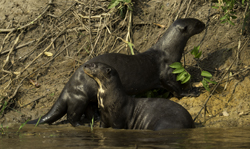 later that he had moved downstream and some tourists were with him for 1.5 hours, although that involved the cat walking through the forest and along the banks. We finished our evening with another session with Giant Otters, this time feeding on an enormous catfish.
later that he had moved downstream and some tourists were with him for 1.5 hours, although that involved the cat walking through the forest and along the banks. We finished our evening with another session with Giant Otters, this time feeding on an enormous catfish.
Day 8. Jaguar Country
We had another Jaguar, around noon, although the entire morning was strangely, and refreshingly, devoid of other tourist boats. My skiff went up the Three Brothers, then the San Lorenzo, and down another stream to rejoin the Brothers, stopping en route for Caiman and Capybara.
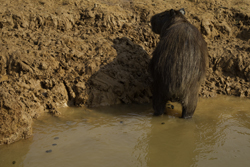
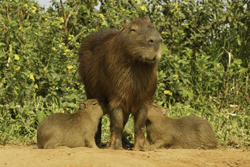
At one Capybara haul out, where about a dozen animals, with three small-ish young, were gathered, we anchored and drifted within frame-filling distance with a 70mm. One Capybara approached our boat, climbed down the shoreline backwards, eased itself into the water, and then proceeded to first urinate, then defecate, in the water. Afterwards it returned to the shore and rejoined the others on the bank. It appeared as if the capybaras do not soil favorite haul outs, although we’ve seen scat scattered about on many trails and banks. Perhaps ‘on territory’ they are more fastidious, just as African Bat-eared Foxes will go some distance from the den to excrete.
Many of the Capybaras were busy chewing, as if they were grinding on a cud much like a cow. I asked Marcos about this and he said that is what they were doing – it certainly looked that way – but I never heard of this with rodents. Two of the three young capybaras nursed at a female who stood upright while they fed.
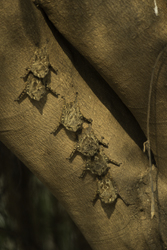 Our boatman pointed out another group of Long-nosed Bats, this time a beautiful cluster of six or seven bats on a tree trunk with a convenient slit for hiding. It made a nice addition to the portraits I’d made earlier.
Our boatman pointed out another group of Long-nosed Bats, this time a beautiful cluster of six or seven bats on a tree trunk with a convenient slit for hiding. It made a nice addition to the portraits I’d made earlier.
At noon, as we headed back we received a call that another cat was seen, and although it was in the steep bank, heavily vegetated main channel, it finally paused and sat/laid in the Sphinx position in a good opening. After 40 minutes or so she got up and disappeared into the jungle, and we headed for lunch.
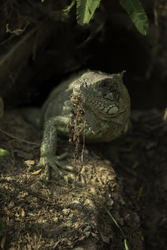 PM. We Judy, Don, and I headed far up the Three Brothers, eventually reaching the side channel where the lone Long-nosed Bat had been roosting. Remarkably, very few boats were on the river and we passed only a few ‘good’ boats, with responsible guides, along the waterways.
PM. We Judy, Don, and I headed far up the Three Brothers, eventually reaching the side channel where the lone Long-nosed Bat had been roosting. Remarkably, very few boats were on the river and we passed only a few ‘good’ boats, with responsible guides, along the waterways.
We stepped out of the skiff where, last trip, I had spotted the Nacunda Nighthawk, and several were perched like dark blobs on the nearly vegetation-free flats. This time, instead of the birds circling as we approached they simply flew off, probably because there was enough dry land now for the birds to land anywhere.
Jaguar tracks were everywhere, including small tracks that I’d have suspected where puma anywhere else. We did some shots, using wide-angles where we could include the habitat in addition to the tracks. I wished that I had plaster for casts.
Heading back towards the main channel, the Three Brothers, Judy spotted a Caiman with a freshly caught Sailfin Catfish, still flopping and quivering in the caiman’s jaws. Like many caimans, it faced away from the river but our efforts to get a clear view amongst the water hyacinths was futile, and we only had limited viewing.
As we headed downriver, I spotted a Jaguar just as it had emerged from the river. 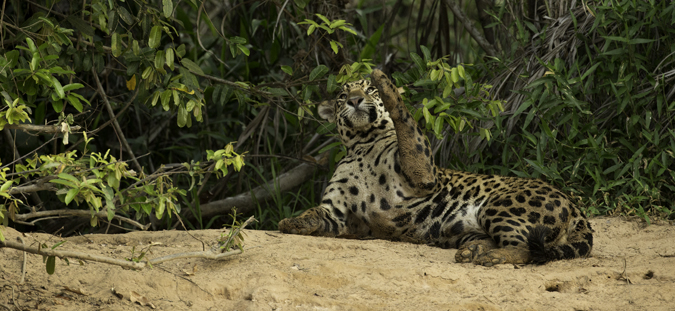
It was George, who went through a rolling routine drying his wet fur on the sandy soil. We had some excellent shots, in relatively still water as we dropped anchor. No other boat was in sight, and unfortunately by the time any arrived George had disappeared back into the jungle.
We continued towards home, and I saw a Crane Hawk, a fairly rare and quite unusual species. Crane Hawks are the ecological equivalent of the African Harrier 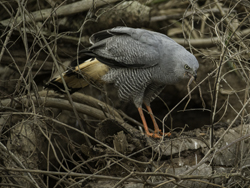 Hawk, or Gymnogene, and the perfect example of parallel evolution. Like Gymnogenes, these hawks have extremely flexible, long legs that they use to reach inside tree knotholes, cracks, or other hiding places. This one was feeding upon a frog, while nearby nesting birds dive-bombed the hawk, as it normally is a real threat to birds as well. While we watched, the bird flew down the tree and grabbed another frog, and still another a short time later. At one point the bird landed on the limbless section of the tree trunk, fanning its wings out in what looked like a bear hug to help grasp the tree, and the hawk extracted another frog!
Hawk, or Gymnogene, and the perfect example of parallel evolution. Like Gymnogenes, these hawks have extremely flexible, long legs that they use to reach inside tree knotholes, cracks, or other hiding places. This one was feeding upon a frog, while nearby nesting birds dive-bombed the hawk, as it normally is a real threat to birds as well. While we watched, the bird flew down the tree and grabbed another frog, and still another a short time later. At one point the bird landed on the limbless section of the tree trunk, fanning its wings out in what looked like a bear hug to help grasp the tree, and the hawk extracted another frog!
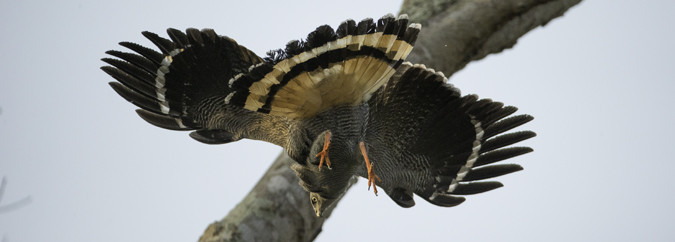
We were about to leave when the bird flew down to the stream bank, where it worked the fallen logs and branches, and reaching in to a crevice where bark had peeled from a limb, the hawk pulled out two more frogs in succession. When the bird flew to a high perch we left.
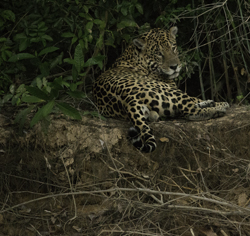 We had another radio call and we raced downriver, almost to the Flotel where we had another Jaguar, a male, lying on the bank. A fishing boat was anchored at a deadfall by a clearing where the cat had appeared, illustrating how these cats originally became habituated. Multiple boats arrived, and the cat remained, although the light was poor. For the first time I shot at ISO 32000, and with the light almost gone we left. Some of our boats stayed behind, and saw the cat leave when, they suspect, people firing flashes may have driven the cat off.
We had another radio call and we raced downriver, almost to the Flotel where we had another Jaguar, a male, lying on the bank. A fishing boat was anchored at a deadfall by a clearing where the cat had appeared, illustrating how these cats originally became habituated. Multiple boats arrived, and the cat remained, although the light was poor. For the first time I shot at ISO 32000, and with the light almost gone we left. Some of our boats stayed behind, and saw the cat leave when, they suspect, people firing flashes may have driven the cat off.
Jaguar count 15
Day 9. Jaguar Country to SWP
Another Jaguar, a male, on the Cuiaba River. Manuel spotted it – merely a patch of hide in brush, and all of our boats arrived in time to watch and wait, and eventually the cat got up and walked the river bank edge, providing good glimpses and shots in the various openings in the jungle.
Judy and Don’s boat had a great session with Yellow-headed Vultures perched and sunning on a sandbar. We quit early, by 11:15 to have an early lunch and an earlier arrival at PWC where we took a boat ride, hoping to have luck with Tapir. We did see two Agami Herons, the most beautiful of all Western Hemisphere herons, and photographed the immature.
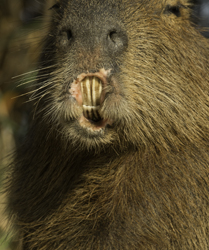
I met the guide I chewed out on the river over the jaguar incident, and I apologized for being harsh. He blamed his boatman, but as a guide he should have control. I let it go and said it was over with, although I felt he harbored some bad feelings. Still, had I to do it over again I’d have done the same, with the same harsh words, because it was an egregious act.
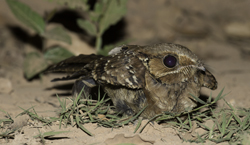 After arriving at PWC I raced to set up one Camera Trap. The boat ride did not produce the hoped for tapir, but we did manage to photograph the most beautiful of all the Herons, and Agami Heron. Unfortunately the one we shot was an immature, and thus was not nearly as striking as the electric-colored adults. After the boat ride, in the dark, Marcos helped me set up another at a larger water hole, and accompanied me into the forest to turn on the flashes for the other set. By then it was minutes from dinner, I grabbed a quick shower, ate, and then most of us did a night game drive, again hoping for Tapir. No luck. However, we had a Nightjar that Judy and I got out of the truck for, to shoot at ground level and close, and that alone made the drive worthwhile. Brocket Deer, Boat-billed Heron, Crab-eating Raccoons, and Caimans were the other sightings.
After arriving at PWC I raced to set up one Camera Trap. The boat ride did not produce the hoped for tapir, but we did manage to photograph the most beautiful of all the Herons, and Agami Heron. Unfortunately the one we shot was an immature, and thus was not nearly as striking as the electric-colored adults. After the boat ride, in the dark, Marcos helped me set up another at a larger water hole, and accompanied me into the forest to turn on the flashes for the other set. By then it was minutes from dinner, I grabbed a quick shower, ate, and then most of us did a night game drive, again hoping for Tapir. No luck. However, we had a Nightjar that Judy and I got out of the truck for, to shoot at ground level and close, and that alone made the drive worthwhile. Brocket Deer, Boat-billed Heron, Crab-eating Raccoons, and Caimans were the other sightings.
Total Jaguar sightings - 16.
Day 10. SWP

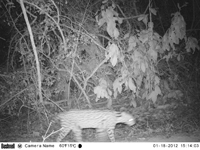
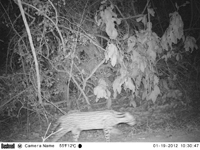
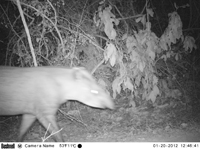
Images from Tom's Bushnell Game Camera of a Tamandua,
Ocelots, and Tapir. Unfortunately I set the camera too high and cut off the legs, but we did record interesting species -- the whole point of the cameras!
Marcos and I checked my two camera traps and retrieved the cards from Tom’s game cameras. I had no luck at either set, and found that I had positioned the game cameras too high, cutting off half of the subjects that I recorded. They included a Less Tamandua – something Marcos has never seen at this lodge, as well as Agoutis, Brocket Deer, several Tapirs, and Ocelots. Everything good was shot at night. We decided to keep the Trail Cameras in Brazil after we left and Marcos will be providing us with images and updates. Next year, using that data, we'll have the option of setting cameras at these locations for camera-trap shooting.
Back at the Toco Toucan feeding station I tied up some photogenic vines that I hoped the toucans would use as perches, to climb down to the food. Instead, although they tolerated me being in the tree, they flew off without visiting the feeders.
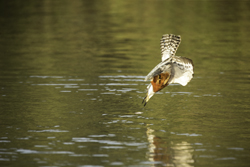
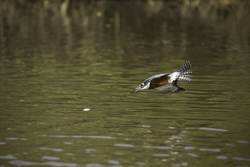
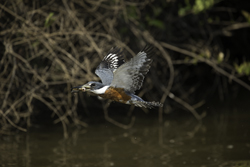
.jpg)
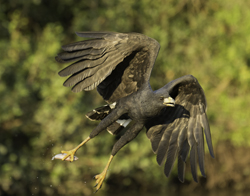
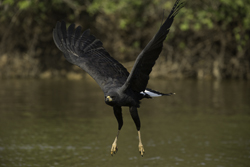
At 8:30 we did another boat ride, this time concentrating on Black-collared Hawks, Greater Black Hawks, Ringed Kingfishers, and one Amazon Kingfisher. We did fairly well, although once again it was a comedy act of ‘herding cats’ as I tried communicating to get the boats quickly in position. Too often, when we do this, the hawks fly on ahead of us by the time we’re set up, and from that position all that we would capture is the tail end, and a poor shot. A lot of time is wasted getting the boats organized, but we finally succeeded with all the subjects.
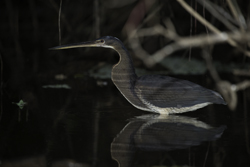 I spent the afternoon setting up one last attempt with a Range IR camera trap, this time using bananas for bait and framing for a Tapir. The previous night I caught a Brocket Deer, and although the next morning would be hectic, I had to try. I used three flashes, and a wider frame, and returned from the jungle in time for a final boat ride where we saw more Agami Herons but had little shooting. In the dark, Marcos and I returned to the jungle to turn on the camera and flashes, arriving in time for a quick shower before dinner.
I spent the afternoon setting up one last attempt with a Range IR camera trap, this time using bananas for bait and framing for a Tapir. The previous night I caught a Brocket Deer, and although the next morning would be hectic, I had to try. I used three flashes, and a wider frame, and returned from the jungle in time for a final boat ride where we saw more Agami Herons but had little shooting. In the dark, Marcos and I returned to the jungle to turn on the camera and flashes, arriving in time for a quick shower before dinner.
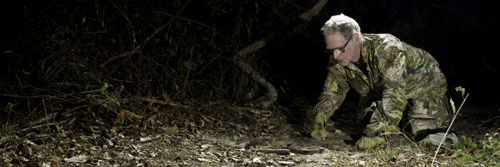
Before I leave a camera trap setup I always do a run through, making sure the lights and exposure are correct and the Range IR aimed correctly. If you are interested in this type of work, take our Advanced Flash Course in 2015.
Day 11. SWP to Cuiaba
I left at 5:50 to check the camera trap and take down the gear, and my initial scroll through 630 images revealed nothing. I suspected that the Range IR either built up a trigger, or small insects (more likely) tripped the camera. I almost deleted the card but decided to run through all just to be sure, and found about 8 Ocelots around frames 341-349. Transporting and setting up, and tearing down and packing, the flashes, cables, ballheads, and Range IRs has always been a problem. This year I was smart, and packaged each camera trap setup (I had three) in separate Gura Gear Et Cetera pouches and cases. These were perfect for this, and I could get a complete flash system with four flashes, little ballheads, and Phottix trippers in the larger case, and a Range IR in the smaller. Two complete systems would fit in my small daypack, and I could set up and tear down, for the first time, without confusion!
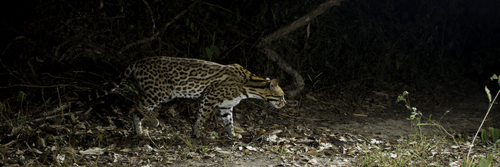
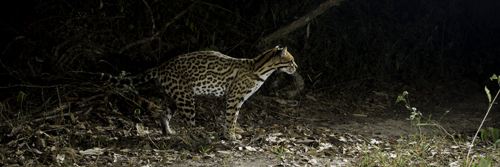
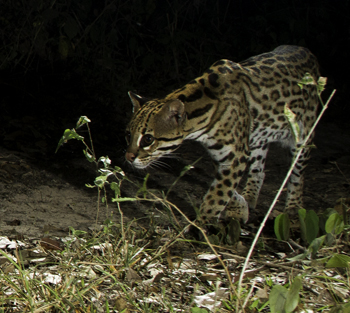 The Ocelot inspected the bananas, disappeared, and returned a while later to check them out again. Nothing else appeared.
The Ocelot inspected the bananas, disappeared, and returned a while later to check them out again. Nothing else appeared.
At the Toucan feeder the birds were quite shy with the unfamiliar addition of the vines, but eventually both came in, and the vines gave the shoot a new look – not the normal, bare branch. Unfortunately no one bothered shooting, except me, although I was then rushed to shower and get ready for breakfast. Marcos showed the 8 minute video he did of our trip – an excellent job, and we presented him with his well deserved tip. Since the guide who crossed our boat was absent, Marcos included his video clip of the boat passing by our boats and we all laughed, however had the cat grabbed a capybara, we agreed our good humor would have been far less.
On the way back to Cuiaba the roadside ponds are beginning to dry and hundreds of waders had gathered at pools where, just over a week ago, they were bare. Three of our group, Bill, Mary, and Cathy, headed for home while the rest of us checked in early for a five hour wait for our flight to Campo Grande for our Southern Pantanal Extension.








Sign up for our Constant Contact Newsletter to receive the latest information on our up coming tours and safaris, immediate opening offerings, and other news. We do not share this list with any other source.
Join us on Facebook at: Follow Hoot Hollow
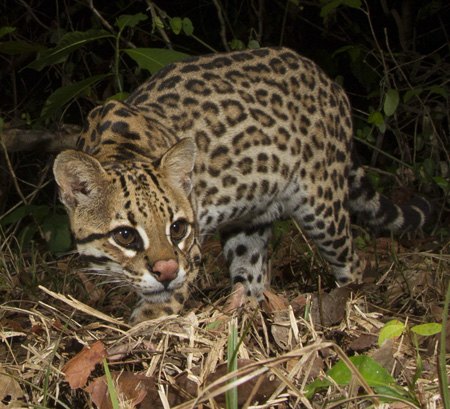
If you'd like to learn how to take images like this, we have the course.
In 2015 we are planning on running our Advanced Nature Photography Course which will be primarily concerned with Mastering Flash, remote or camera triggering devices like the Range IR, and macro photography. Contact our office if you are interested.
We would love if everyone who did our Photo Safaris and Tours did one of our Digital Complete Nature Photo Courses to learn manual exposure, flash, workflow, and basic Photoshop and in-depth RAW conversion. We think everyone would get even more out of our trips if they truly were masters of the craft.
Read about all of our previous Jaguars and the Wildlife of the Pantanal trips.
.
Refer to our BROCHURE to get an idea of next year's trip!
Exact dates and prices may not be updated.
Visit our Trip and Scouting Report Pages for more images and an even better idea of what our trips to the Pantanal are like. There you'll find our archived reports from previous years.

Trip Reports:
Jaguars and the Wildlife of the Pantanal
2014
Trip Two
Read the reports for
The Summary of all three trips
Trip One
and the
Southern Pantanal Extension


Diversity is perhaps the best word to describe our second Photo Tour of 2014 in the Northern Pantanal. As we had in the first Tour, we were lucky to again photograph a Giant Anteater that was incredibly tame and visited one of our lodges regularly. While June and July brought out of season heavy rains that had swelled the Pantanal's rivers and pools, by the time of the second tour water levels were back to normal and the Caimans and Capybaras were back on the river banks and sand bars, offering tempting meals for hunting Jaguars.
Oddly, in contrast to the first Tour when we saw more male Jaguars than females, and a third of these were collared, most of the Jaguars we saw on the second Tour were females, and we saw not a single Jaguar wearing a collar. One of the highlights, and potentially one of the all-time low points, was watching George, one of the most habituated Jaguars of last year, hunting a small family of Capybaras. As you read on, you'll see why it was one, and could have been the other.
The highlight of this Tour for several of us was the Jaguar, Patricia, that my skiff found as she rested on an open bank in the Black Lagoon. Although we eventually shared this sighting with a nightmarish traffic jam of twenty boats, most of our skiffs were positioned securely in a bed of water hyacinths and in a great position. There I got one of my 'dream shots,' one I've envisioned for years, and that was of a Jaguar stalking directly towards me on a sand bank. Although I often wondered how I could accomplish this, since being on a sand bank at the same time could create some obvious problems, the position of Patricia and our boat worked perfectly. In fact my friend Tom, who was behind me as we shot this, wondered whether the Jaguar had had a bead on me and was stalking me. Of course, he just kept shooting and only mentioned this later! We think the jaguar was drawn by a Caiman that must have sunk beneath the aquatic vegetation before the Jaguar could launch an attack.
Check out our Jaguars and the Wildlife of the Pantanal book.
The following is the daily journal of the trip:
Day 1 – Arrival in Sao Paulo to Cuiaba to Curicaca, Pantanal
Tom and I were dropped off at Corakaka where we spent the day, while our 2nd group flew in. I spent 5 hours setting up two camera traps for fish-eating bats, and another on a game trail. The bat setup took up most of my time as I had to secure a Range IR out over open water and position flashes to light up the target area. Although in retrospect I probably would have been better off just wading in the Caiman-filled waters to place my poles, instead I used a moored skiff as my base. Every time I shifted position the boat moved, threatening to knock over my Range IR or flashes. To prevent this, I ended up making a 'dock' out of bamboo poles to secure the boat's lateral movement. Although I was completely unsuccessful in getting a Fishing Bat photo (and saw none over the water that night), I learned some very valuable lessons in improvising which will make future setups in remote locations much easier. There is alwalys a positive side!



My fishing bat setup, using a RRS TP-243 Ground 'Pod for securely anchoring my camera into the mud. This pod has easily cleaned telescoping legs with spikes at one end, so I felt comfortable and safe leaving the camera unattended while six-foot long Caimans stalked the shoreline. I made sure I had the bottom legs sunk deep into the mud and unless a Caiman tried eating the gear I knew it would be safe.
The group’s flight was an hour late, and the group arrived at 6:30, long after sunset. Fortunately no one lost luggage and except for being tired, we were off to a good, stressfree start.
Day 2 - Curicaca to Pouso Alegre
Everyone was up at 6 to be at the feeders, but activity was fairly slow. Bill B got an excellent sequence of a Great Potoo actually doing something, preening and stretching. Normally they sit immobile, like a broken limb. I checked my cameras, and got nothing, although the game trail camera may have false fired with the sensor picking up backgrounds. It was a good set and would have resulted in a beautiful photograph had a tapir or puma wandered down the trail. I'm anxious to try this again next year!



 We headed to the main road for more shooting, but aside from acquainting folks with the wildlife the shooting was slow and routine. After lunch we headed to PL and our rooms were not ready. I went around the back of the lodge to try to Skype Mary, and spotted the Giant Anteater in the pasture. We spent the next 1.5+ hours with the anteater, sometimes coming so close it sniffed people.
We headed to the main road for more shooting, but aside from acquainting folks with the wildlife the shooting was slow and routine. After lunch we headed to PL and our rooms were not ready. I went around the back of the lodge to try to Skype Mary, and spotted the Giant Anteater in the pasture. We spent the next 1.5+ hours with the anteater, sometimes coming so close it sniffed people.
At 4:30 we headed on the truck for a sunset shot and night game drive, and had a great sunset which we framed with the Jabiru Stork nest, occupied by the 2 adults and 2 chicks. We waited on tapir without success, and checked two waterholes. A Brocket Deer fed on the edge of a woodline, then darted off in fear. We soon saw why -- a innocuous Crab-eating Fox trotted by.

On the return, a Caiman on the road had a large freshly caught eel, and after everyone finished shooting I used the lights to hide my approach, to photograph the caiman at about 4 feet.
We returned by 7, and after yesterday’s work and a very busy day today, I gave Mary a quick Skype call, and crashed, exhausted.

 .
.
The Caiman was eating a large eel. Although I was close to the Caiman, because of my flashlight I was in the dark and invisible to the Caiman, despite how it might look.
Right, Judy Johnson photo.
Day 3. Pouso Alegre to South Wild Lodge
 Everyone was out by 6, chasing the Hyacinth Macaws which were perched in a tree close to their nest tree. A Crimson-crested and a Green-barred Woodpecker were nesting in old palms, and were cooperative, as was a few Capuchin Monkeys. The giant anteater, nor the rheas appeared, and the ladies, Judy, Mary, Cathy, and Doris, went to the Jabiru Stork nest with Marcos, and after waiting, leaving, and returning, the adult finally appeared and regurgitated water and fish to the hungry young. I checked out the marsh for Marsh Deer – unsuccessfully, and spent the remainder of my morning trying to find various misplaced items in my luggage, while the others relaxed.
Everyone was out by 6, chasing the Hyacinth Macaws which were perched in a tree close to their nest tree. A Crimson-crested and a Green-barred Woodpecker were nesting in old palms, and were cooperative, as was a few Capuchin Monkeys. The giant anteater, nor the rheas appeared, and the ladies, Judy, Mary, Cathy, and Doris, went to the Jabiru Stork nest with Marcos, and after waiting, leaving, and returning, the adult finally appeared and regurgitated water and fish to the hungry young. I checked out the marsh for Marsh Deer – unsuccessfully, and spent the remainder of my morning trying to find various misplaced items in my luggage, while the others relaxed.



Crimson-crested Woodpecker female; Green-barred Woodpecker, Capuchin Monkey
 In the late morning I had another chance to photograph a captive Bothrops viper, a venomous species that is often called a Fer-de-lance. The ranch owner, who normally handles or controls the snake had to leave, giving me a chance to patiently work with the snake and pose it. Understandably the rancher is concerned with safety, as am I, but I can see why, too, when the snake practically flipped a 180, reversing directions so fast that had it been aggressive, and had I been closer, a dangerous situation could have developed. As it was, I was out of danger and the snake wasn't aggressive or stressed and we finished the shoot nicely.
In the late morning I had another chance to photograph a captive Bothrops viper, a venomous species that is often called a Fer-de-lance. The ranch owner, who normally handles or controls the snake had to leave, giving me a chance to patiently work with the snake and pose it. Understandably the rancher is concerned with safety, as am I, but I can see why, too, when the snake practically flipped a 180, reversing directions so fast that had it been aggressive, and had I been closer, a dangerous situation could have developed. As it was, I was out of danger and the snake wasn't aggressive or stressed and we finished the shoot nicely.
 Since we had great luck with the anteater, we headed directly to PWC after lunch, arriving around 3. We had hoped to visit the tower here for Capuchin monkeys, but none had been seen in the last few days. Instead, we traveled upriver and had a few sessions with Greater Black Hawks and Black-collared Hawks, and Ringed Kingfishers. The shooting was pretty successful.
Since we had great luck with the anteater, we headed directly to PWC after lunch, arriving around 3. We had hoped to visit the tower here for Capuchin monkeys, but none had been seen in the last few days. Instead, we traveled upriver and had a few sessions with Greater Black Hawks and Black-collared Hawks, and Ringed Kingfishers. The shooting was pretty successful.
Afterwards we headed to the Cattle Egret roost, and although birds came in in rather large flocks, none massed for striking congregations. Afterwards, I armed a camera trap close to the lodge – not having sufficient time to head into the jungle. At 6:45 we did a star trail/milky way scene that I scouted out before dark. Unfortunately, I took the wrong track and we walked about 100 yards before I realized the error, then backtracked around the little pond where I had the camera trap to reach the location where I had left my camera. At the camera trap, a tiny Yellow Anaconda was eating a fish, which it carried into the water and disappeared from view. On our walk to where I had my camera I found another 18 inch long snake, collared somewhat like a Bothrops but, I believe, a nonvenomous species. Still, we left it alone.


Two images, both with the foreground trees painted with a flashlight as we did a long exposure for the stars. I forgot the '500 Rule' which is this: Divide the number 500 by the focal length of the lens in use to get the number of seconds a star exposure can be before you record star streaks. We were all using wide-angle lenses and shutter speeds below 30 seconds, so it worked anyway. However, for my 16mm shots I could have had my shutter set at 500/16= 31 seconds. A great explanation for Astrophotography is given on page 45 of the latest RRS catalog or at this RRS link. The difference in color in the two images is due to the RAW processing, where I lowered the color temperature for the shot on the right.
 The star shooting went fairly successfully, although some shooters did not know how to set a slow shutter speed, but eventually everything got worked out. At 10PM I heard the Great Horned Owl chick, now looking just like an adult, wheezing for a parent to feed it, and with the help of one of the other guides, who held my focusing light, I managed several good shots.
The star shooting went fairly successfully, although some shooters did not know how to set a slow shutter speed, but eventually everything got worked out. At 10PM I heard the Great Horned Owl chick, now looking just like an adult, wheezing for a parent to feed it, and with the help of one of the other guides, who held my focusing light, I managed several good shots.
Day 4. South Wild to the Flotel, and Jaguar country
I checked my camera trap at dawn, and again had no luck. The Toco Toucans arrived on schedule, and since a Jabiru Stork was attending its deserted nest I went to the tower for some shots. Not much was happening, but after I left the male flew in and they mated – what would have been a worthwhile shot.
We left shortly after breakfast, arriving at Porto Joffre around 10:30, with enough time to state out the Hyacinth Macaw nest that is a short distance from the boat launch. Three macaws  were at the nest tree, but oddly two of them spent most of their time exploring a hole low on the tree trunk, below the rails of the fence guarding the tree. Fortunately an adult eventually popped out of the nest hole, remained a moment, and flew off, and we headed for the boats.
were at the nest tree, but oddly two of them spent most of their time exploring a hole low on the tree trunk, below the rails of the fence guarding the tree. Fortunately an adult eventually popped out of the nest hole, remained a moment, and flew off, and we headed for the boats.
With our power boat, the same used by some of the companies, it took us 20 minutes to reach the Flotel, so for those staying in Joffre, that’s about 1.5 hours a day wasted, going fast upon the river.
We left at 2PM, and headed for the Black Lagoon. Since our last trip, someone had cleared the obstructing tree that blocked much of that channel (right where the jaguars were mating last trip). We headed upriver for another 30 minutes, with our boats being the only ones on this quiet stretch of river. It was beautiful, and had we had luck, it would have been superb.
 As it was, we photographed hawks, kingfishers, and Caimans, including one I did with a wide-angle where my lens was almost touching the caiman’s tail. When we circled the reptile, it obliged by yawning widely before settling itself into the sand. It was close to sunset when we reached the main river, and we headed upstream on the Three Brothers where, at Caiman Island, our boatman had a brief glimpse of a jaguar but no one in our boat saw it, so we did not count the encounter. No one else had luck, either. In the last light of the day, as the red sun hung just above the trees, we photographed Caiman framed by the streak of red, the reflections of the sun on the quiet bay.
As it was, we photographed hawks, kingfishers, and Caimans, including one I did with a wide-angle where my lens was almost touching the caiman’s tail. When we circled the reptile, it obliged by yawning widely before settling itself into the sand. It was close to sunset when we reached the main river, and we headed upstream on the Three Brothers where, at Caiman Island, our boatman had a brief glimpse of a jaguar but no one in our boat saw it, so we did not count the encounter. No one else had luck, either. In the last light of the day, as the red sun hung just above the trees, we photographed Caiman framed by the streak of red, the reflections of the sun on the quiet bay.
.


Day 5. Jaguar Country
 AM. We had five, and perhaps six different jaguars today, including one of the best sequences ever. My skiff headed up the Three Brothers River, and although I like going up the Black Lagoon, I thought this was a good choice, as the Lagoon is often better later in the morning. We explored a few side channels, then received a radio call that a cat was on the main river. We arrived, as one of multiple boats, and got a few shots before the cat wandered off. Another cat was spotted, and we raced to that location, again with a lot of boats. This happened a third time, and by then, nearly 9:15, I was disgusted by the crowds. We had shot each jaguar and I monumentally blew one round when, stupidly, I had my shutter speed at 1/40th and the aperture at f22. The exposures were good, but the motion! Gag!
AM. We had five, and perhaps six different jaguars today, including one of the best sequences ever. My skiff headed up the Three Brothers River, and although I like going up the Black Lagoon, I thought this was a good choice, as the Lagoon is often better later in the morning. We explored a few side channels, then received a radio call that a cat was on the main river. We arrived, as one of multiple boats, and got a few shots before the cat wandered off. Another cat was spotted, and we raced to that location, again with a lot of boats. This happened a third time, and by then, nearly 9:15, I was disgusted by the crowds. We had shot each jaguar and I monumentally blew one round when, stupidly, I had my shutter speed at 1/40th and the aperture at f22. The exposures were good, but the motion! Gag!
Mary and Tom agreed with my decision to head to the Lagoon, and soon after entering, at a point where I normally see a Green Tree Iguana sunbathing on a limb, our boatman spotted a Jaguar. We were the only boat, but of course he radioed the others (the frequency shared by two other large boat flotillas, too) and it wasn’t too long before we heard the drone of bees – the racing speed boats – entering the lagoon. Virtually every boat on the river was squeezed into the narrow  waterway that has been forced between the reed beds. We were in the prime position, and we remained there – all day.
waterway that has been forced between the reed beds. We were in the prime position, and we remained there – all day.
Mid-day the Jaguar got up and started stalking, its direction right, directly, towards our cameras and I made one of my ‘dream shots,’ a jaguar stalking straight at the camera. The hunt failed, and the cat returned to the spot where it was resting, where it appeared in view periodically as it scanned the surroundings for game. The light only got better, and despite the fact that no one had peed all day, we stayed in position. At 4:30 the Jaguar got up again, stalked towards us at an angle, then veered off. Earlier, while we watched this female (Patricia) another female appeared in view.


Additionally, one of our skiffs, with, I think, an impatient photographer, left to return for lunch and spotted either that female, or another, on the way back to the boat. When that skiff returned, they had another jaguar (perhaps the same one?) but this time it swam along the shore, and they shot over 100 images – so they were very happy. And lucky. With a great jaguar, the protocol is to not leave something so promising because 999 out of 1,000 times, you’ll get nothing for the effort. They had two jaguar sightings, so they were lucky exceptions to a very standard, and practical, rule.



Day 6. Jaguar Country
 AM. We headed up the Pixiam River to a fishing lodge where I mistakenly understood that a Giant Armadillo, an extremely rare or seldom seen species, was visiting the lodge mid-morning. We’ve been to this fishing camp many times before, and it is usually good for Hyacinth Macaws and other birds. When we arrived, an Armadillo was foraging amongst a food pile with Black Vultures and Crested Caracaras, the latter leaving as we approached, leaving the remaining food for the armadillo, which was feeding on a papaya-like fruit. When it finished it ran off, and we followed it to its burrow, which was beside the sidewalk. Using some cooked rice we enticed the armadillo back out, and I disguised the terrible background, resulting in some beautiful shots of a Yellow or Six-Banded Armadillo. Marcos told us that the lodge owner actually picks them up and puts them on a spot, and sure enough, Marcos did the same, bringing over another armadillo, resembling a fat snapping turtle, and deposited it
AM. We headed up the Pixiam River to a fishing lodge where I mistakenly understood that a Giant Armadillo, an extremely rare or seldom seen species, was visiting the lodge mid-morning. We’ve been to this fishing camp many times before, and it is usually good for Hyacinth Macaws and other birds. When we arrived, an Armadillo was foraging amongst a food pile with Black Vultures and Crested Caracaras, the latter leaving as we approached, leaving the remaining food for the armadillo, which was feeding on a papaya-like fruit. When it finished it ran off, and we followed it to its burrow, which was beside the sidewalk. Using some cooked rice we enticed the armadillo back out, and I disguised the terrible background, resulting in some beautiful shots of a Yellow or Six-Banded Armadillo. Marcos told us that the lodge owner actually picks them up and puts them on a spot, and sure enough, Marcos did the same, bringing over another armadillo, resembling a fat snapping turtle, and deposited it  in front of the rice. The armadillo immediately started eating! This one must do this a lot, because when it turned its back it was enormous – truly fat, an obese armadillo. The one we had been shooting, which came out again, was of normal proportions.
in front of the rice. The armadillo immediately started eating! This one must do this a lot, because when it turned its back it was enormous – truly fat, an obese armadillo. The one we had been shooting, which came out again, was of normal proportions.
En route, we had a long, 45 minute session with 4 noisy Giant Otters, that swam up and down river, catching fish, and offering brief snatches of shots. After the fish camp we headed far upriver to a location where Wilson, a jaguar that the Panthera Organization had collared four years ago (and subsequently disappeared from view – a tragedy since this was one of the true stars in the jaguar world), was recently seen, identified by a photo. We didn’t see any jaguars, nor did anyone on the main jaguar routes this morning.

PM. We had three Jaguars this afternoon, and could have had a fourth had we endured the crowds in a narrow channel off the Three Brothers. As we headed upstream, speed boats raced by, all intent on reaching the reported jaguar. When we arrived at the turn-off, Marcos and one of our other boats were at the intersection, and Marcos was pointing out a Jaguar hidden deeply in the thick vegetation lining the riverbank. I craned forward, just to say I saw it, and saw a small patch of jaguar hide. I advised the group to leave it, as many were trying to photograph in an impossible situation, with images that were not even a thousandth as good as anything shot yesterday. We all moved on.
Further up river a young pair of Capybara splashed about playfully, but as we positioned ourselves another speed boat raced by, creating such huge waves that the rodents retreated deep into the grasses. Later, on another side channel, I had  a pair of Capybara mating, the first time I’ve seen this.
a pair of Capybara mating, the first time I’ve seen this.
Capybaras are supposed to mate only in the water, although the naturalist on the boat says he’s seen a land mating. Our pair mated, or attempted to, at least six times in seven minutes, with the female swimming ahead of the male, then slowing in shallow water, allowing him to advance. In many ways it reminded me of Thompson’s Gazelles mating, with the chase involved, but in truth the female was not really avoiding the male. After the sixth or seven mating he seemed done, and spent his time rubbing his scent gland on vegetation lining the river, then coming ashore to roll in the mud. The female joined him there, where she sniffed his muzzle and also his back end, as if still soliciting a mating. He did not respond. A Caiman was lying nearby, with an odd pack of mud balled on his back, and she went up to him, first sniffing the mud, then moving up to the Caiman’s snout. He lunged away, annoyed, and she jerked away as well. Shortly afterwards the female moved on, swimming off, and, to me, appearing to be hunting for a more ardent mate.
 As we cruised home we received a radio call of another jaguar, which we reached just as the female, Patricia, pushed through tall grasses and walked along the sandy beach. I had to go to ISO 8000, but caught her as she charged across the sand, chasing something (but her legs were not visible), then leaping, in a nice sequence. By then the light had failed, and she was moving through tall vegetation where her progress was marked by shaking plants, not by views of her. We left for home.
As we cruised home we received a radio call of another jaguar, which we reached just as the female, Patricia, pushed through tall grasses and walked along the sandy beach. I had to go to ISO 8000, but caught her as she charged across the sand, chasing something (but her legs were not visible), then leaping, in a nice sequence. By then the light had failed, and she was moving through tall vegetation where her progress was marked by shaking plants, not by views of her. We left for home.
Jaguar count: 9, 6 the second day, 3 this evening.
Day 7. Jaguar country
AM. Judy, Don, and I spent a wonderful morning in the Black Lagoon, pushing up river past some shallow spots and ending up having the river entirely to ourselves – with Bill B, Doris, and Marcos in the other boat. Giant Otters were good, and we spent over an hour with them, and we did some fun stuff with Judy’s GoPro, using a telescoping pole to come up close to Caimans. Putting the camera underwater we got some unusual stuff, although the camera had to be within inches for the lens to see anything in the cloudy, brown water.

At 11 we returned to the Three Brothers, and shot a female Jaguar that eventually left the bank and hid in brush. Rather than wait her out we returned for lunch. Tom and Jerome had gone up river and found another female, and this one may be a new cat, giving Tom naming rights. Since it was my birthday, Tom called it McDonald Jaguar, but since it is a female, I hope it’ll be named Mrs. McDonald Jaguar! If it turns out to be a new cat! Bill and Cathy had a good jaguar encounter, too, with the same cat we came upon later. All told, a two cat morning and a good day.


PM. We headed up river and discovered George, one of the normal ‘stars’ of the jaguar world. He was lying beneath a bush almost directly across from a family of Capybara on a sand bank. When he awoke he spotted the Capybaras, and made two attempts to cross the river but, we think, the boats discouraged him from crossing. He eventually crossed further upriver, but still down river from the capybaras. We raced upstream to get across from the rodents, tying ourselves in just seconds before we expected the hunt to occur. Unfortunately, one of the guides from the Flotel, and one of the boatmen we used on the last trip, decided to change their position and moved upriver, passing directly in front of all of our boats at the moment that the jaguar charged on to the beach. The capybaras escaped, but had he caught one, the shots would have been ruined.


The boat passes, as we look, aghast! Etiquette on the river is important and
responsible companies and guides MUST lead the way. We were furious.
Everyone was livid, and I had our boat move up where I rather vehemently dressed down the guide, telling him he had acted quite selfishly, disregarding all the other photographers in line for the shot. When a boat is moving, those on a boat really can’t shoot, so moving at a critical moment like that does nothing for those photographers, while it certainly ruins it for everyone else who are waiting for the shot.
 I felt poorly for the photographer with the guide, as that person had no control and no doubt felt embarrassed and guilty at the transgression. I assured that person that it wasn’t their fault, it was the guide’s, who should know better. I was especially annoyed because the boat traffic has gotten worse each year, and the company I use should be a leader in responsible guiding. Instead, behavior as shown tonight seemed to be an example of ‘screw them, I’m out for myself’ and that attitude can be contagious and virulent. We stayed upstream, hoping George would move upstream but I learned
I felt poorly for the photographer with the guide, as that person had no control and no doubt felt embarrassed and guilty at the transgression. I assured that person that it wasn’t their fault, it was the guide’s, who should know better. I was especially annoyed because the boat traffic has gotten worse each year, and the company I use should be a leader in responsible guiding. Instead, behavior as shown tonight seemed to be an example of ‘screw them, I’m out for myself’ and that attitude can be contagious and virulent. We stayed upstream, hoping George would move upstream but I learned  later that he had moved downstream and some tourists were with him for 1.5 hours, although that involved the cat walking through the forest and along the banks. We finished our evening with another session with Giant Otters, this time feeding on an enormous catfish.
later that he had moved downstream and some tourists were with him for 1.5 hours, although that involved the cat walking through the forest and along the banks. We finished our evening with another session with Giant Otters, this time feeding on an enormous catfish.
Day 8. Jaguar Country
We had another Jaguar, around noon, although the entire morning was strangely, and refreshingly, devoid of other tourist boats. My skiff went up the Three Brothers, then the San Lorenzo, and down another stream to rejoin the Brothers, stopping en route for Caiman and Capybara.


At one Capybara haul out, where about a dozen animals, with three small-ish young, were gathered, we anchored and drifted within frame-filling distance with a 70mm. One Capybara approached our boat, climbed down the shoreline backwards, eased itself into the water, and then proceeded to first urinate, then defecate, in the water. Afterwards it returned to the shore and rejoined the others on the bank. It appeared as if the capybaras do not soil favorite haul outs, although we’ve seen scat scattered about on many trails and banks. Perhaps ‘on territory’ they are more fastidious, just as African Bat-eared Foxes will go some distance from the den to excrete.
Many of the Capybaras were busy chewing, as if they were grinding on a cud much like a cow. I asked Marcos about this and he said that is what they were doing – it certainly looked that way – but I never heard of this with rodents. Two of the three young capybaras nursed at a female who stood upright while they fed.
 Our boatman pointed out another group of Long-nosed Bats, this time a beautiful cluster of six or seven bats on a tree trunk with a convenient slit for hiding. It made a nice addition to the portraits I’d made earlier.
Our boatman pointed out another group of Long-nosed Bats, this time a beautiful cluster of six or seven bats on a tree trunk with a convenient slit for hiding. It made a nice addition to the portraits I’d made earlier.
At noon, as we headed back we received a call that another cat was seen, and although it was in the steep bank, heavily vegetated main channel, it finally paused and sat/laid in the Sphinx position in a good opening. After 40 minutes or so she got up and disappeared into the jungle, and we headed for lunch.
 PM. We Judy, Don, and I headed far up the Three Brothers, eventually reaching the side channel where the lone Long-nosed Bat had been roosting. Remarkably, very few boats were on the river and we passed only a few ‘good’ boats, with responsible guides, along the waterways.
PM. We Judy, Don, and I headed far up the Three Brothers, eventually reaching the side channel where the lone Long-nosed Bat had been roosting. Remarkably, very few boats were on the river and we passed only a few ‘good’ boats, with responsible guides, along the waterways.
We stepped out of the skiff where, last trip, I had spotted the Nacunda Nighthawk, and several were perched like dark blobs on the nearly vegetation-free flats. This time, instead of the birds circling as we approached they simply flew off, probably because there was enough dry land now for the birds to land anywhere.
Jaguar tracks were everywhere, including small tracks that I’d have suspected where puma anywhere else. We did some shots, using wide-angles where we could include the habitat in addition to the tracks. I wished that I had plaster for casts.
Heading back towards the main channel, the Three Brothers, Judy spotted a Caiman with a freshly caught Sailfin Catfish, still flopping and quivering in the caiman’s jaws. Like many caimans, it faced away from the river but our efforts to get a clear view amongst the water hyacinths was futile, and we only had limited viewing.
As we headed downriver, I spotted a Jaguar just as it had emerged from the river. 
It was George, who went through a rolling routine drying his wet fur on the sandy soil. We had some excellent shots, in relatively still water as we dropped anchor. No other boat was in sight, and unfortunately by the time any arrived George had disappeared back into the jungle.
We continued towards home, and I saw a Crane Hawk, a fairly rare and quite unusual species. Crane Hawks are the ecological equivalent of the African Harrier  Hawk, or Gymnogene, and the perfect example of parallel evolution. Like Gymnogenes, these hawks have extremely flexible, long legs that they use to reach inside tree knotholes, cracks, or other hiding places. This one was feeding upon a frog, while nearby nesting birds dive-bombed the hawk, as it normally is a real threat to birds as well. While we watched, the bird flew down the tree and grabbed another frog, and still another a short time later. At one point the bird landed on the limbless section of the tree trunk, fanning its wings out in what looked like a bear hug to help grasp the tree, and the hawk extracted another frog!
Hawk, or Gymnogene, and the perfect example of parallel evolution. Like Gymnogenes, these hawks have extremely flexible, long legs that they use to reach inside tree knotholes, cracks, or other hiding places. This one was feeding upon a frog, while nearby nesting birds dive-bombed the hawk, as it normally is a real threat to birds as well. While we watched, the bird flew down the tree and grabbed another frog, and still another a short time later. At one point the bird landed on the limbless section of the tree trunk, fanning its wings out in what looked like a bear hug to help grasp the tree, and the hawk extracted another frog!

We were about to leave when the bird flew down to the stream bank, where it worked the fallen logs and branches, and reaching in to a crevice where bark had peeled from a limb, the hawk pulled out two more frogs in succession. When the bird flew to a high perch we left.
 We had another radio call and we raced downriver, almost to the Flotel where we had another Jaguar, a male, lying on the bank. A fishing boat was anchored at a deadfall by a clearing where the cat had appeared, illustrating how these cats originally became habituated. Multiple boats arrived, and the cat remained, although the light was poor. For the first time I shot at ISO 32000, and with the light almost gone we left. Some of our boats stayed behind, and saw the cat leave when, they suspect, people firing flashes may have driven the cat off.
We had another radio call and we raced downriver, almost to the Flotel where we had another Jaguar, a male, lying on the bank. A fishing boat was anchored at a deadfall by a clearing where the cat had appeared, illustrating how these cats originally became habituated. Multiple boats arrived, and the cat remained, although the light was poor. For the first time I shot at ISO 32000, and with the light almost gone we left. Some of our boats stayed behind, and saw the cat leave when, they suspect, people firing flashes may have driven the cat off.
Jaguar count 15
Day 9. Jaguar Country to SWP
Another Jaguar, a male, on the Cuiaba River. Manuel spotted it – merely a patch of hide in brush, and all of our boats arrived in time to watch and wait, and eventually the cat got up and walked the river bank edge, providing good glimpses and shots in the various openings in the jungle.
Judy and Don’s boat had a great session with Yellow-headed Vultures perched and sunning on a sandbar. We quit early, by 11:15 to have an early lunch and an earlier arrival at PWC where we took a boat ride, hoping to have luck with Tapir. We did see two Agami Herons, the most beautiful of all Western Hemisphere herons, and photographed the immature.

I met the guide I chewed out on the river over the jaguar incident, and I apologized for being harsh. He blamed his boatman, but as a guide he should have control. I let it go and said it was over with, although I felt he harbored some bad feelings. Still, had I to do it over again I’d have done the same, with the same harsh words, because it was an egregious act.
 After arriving at PWC I raced to set up one Camera Trap. The boat ride did not produce the hoped for tapir, but we did manage to photograph the most beautiful of all the Herons, and Agami Heron. Unfortunately the one we shot was an immature, and thus was not nearly as striking as the electric-colored adults. After the boat ride, in the dark, Marcos helped me set up another at a larger water hole, and accompanied me into the forest to turn on the flashes for the other set. By then it was minutes from dinner, I grabbed a quick shower, ate, and then most of us did a night game drive, again hoping for Tapir. No luck. However, we had a Nightjar that Judy and I got out of the truck for, to shoot at ground level and close, and that alone made the drive worthwhile. Brocket Deer, Boat-billed Heron, Crab-eating Raccoons, and Caimans were the other sightings.
After arriving at PWC I raced to set up one Camera Trap. The boat ride did not produce the hoped for tapir, but we did manage to photograph the most beautiful of all the Herons, and Agami Heron. Unfortunately the one we shot was an immature, and thus was not nearly as striking as the electric-colored adults. After the boat ride, in the dark, Marcos helped me set up another at a larger water hole, and accompanied me into the forest to turn on the flashes for the other set. By then it was minutes from dinner, I grabbed a quick shower, ate, and then most of us did a night game drive, again hoping for Tapir. No luck. However, we had a Nightjar that Judy and I got out of the truck for, to shoot at ground level and close, and that alone made the drive worthwhile. Brocket Deer, Boat-billed Heron, Crab-eating Raccoons, and Caimans were the other sightings.
Total Jaguar sightings - 16.
Day 10. SWP




Images from Tom's Bushnell Game Camera of a Tamandua,
Ocelots, and Tapir. Unfortunately I set the camera too high and cut off the legs, but we did record interesting species -- the whole point of the cameras!
Marcos and I checked my two camera traps and retrieved the cards from Tom’s game cameras. I had no luck at either set, and found that I had positioned the game cameras too high, cutting off half of the subjects that I recorded. They included a Less Tamandua – something Marcos has never seen at this lodge, as well as Agoutis, Brocket Deer, several Tapirs, and Ocelots. Everything good was shot at night. We decided to keep the Trail Cameras in Brazil after we left and Marcos will be providing us with images and updates. Next year, using that data, we'll have the option of setting cameras at these locations for camera-trap shooting.
Back at the Toco Toucan feeding station I tied up some photogenic vines that I hoped the toucans would use as perches, to climb down to the food. Instead, although they tolerated me being in the tree, they flew off without visiting the feeders.



.jpg)


At 8:30 we did another boat ride, this time concentrating on Black-collared Hawks, Greater Black Hawks, Ringed Kingfishers, and one Amazon Kingfisher. We did fairly well, although once again it was a comedy act of ‘herding cats’ as I tried communicating to get the boats quickly in position. Too often, when we do this, the hawks fly on ahead of us by the time we’re set up, and from that position all that we would capture is the tail end, and a poor shot. A lot of time is wasted getting the boats organized, but we finally succeeded with all the subjects.
 I spent the afternoon setting up one last attempt with a Range IR camera trap, this time using bananas for bait and framing for a Tapir. The previous night I caught a Brocket Deer, and although the next morning would be hectic, I had to try. I used three flashes, and a wider frame, and returned from the jungle in time for a final boat ride where we saw more Agami Herons but had little shooting. In the dark, Marcos and I returned to the jungle to turn on the camera and flashes, arriving in time for a quick shower before dinner.
I spent the afternoon setting up one last attempt with a Range IR camera trap, this time using bananas for bait and framing for a Tapir. The previous night I caught a Brocket Deer, and although the next morning would be hectic, I had to try. I used three flashes, and a wider frame, and returned from the jungle in time for a final boat ride where we saw more Agami Herons but had little shooting. In the dark, Marcos and I returned to the jungle to turn on the camera and flashes, arriving in time for a quick shower before dinner.

Before I leave a camera trap setup I always do a run through, making sure the lights and exposure are correct and the Range IR aimed correctly. If you are interested in this type of work, take our Advanced Flash Course in 2015.
Day 11. SWP to Cuiaba
I left at 5:50 to check the camera trap and take down the gear, and my initial scroll through 630 images revealed nothing. I suspected that the Range IR either built up a trigger, or small insects (more likely) tripped the camera. I almost deleted the card but decided to run through all just to be sure, and found about 8 Ocelots around frames 341-349. Transporting and setting up, and tearing down and packing, the flashes, cables, ballheads, and Range IRs has always been a problem. This year I was smart, and packaged each camera trap setup (I had three) in separate Gura Gear Et Cetera pouches and cases. These were perfect for this, and I could get a complete flash system with four flashes, little ballheads, and Phottix trippers in the larger case, and a Range IR in the smaller. Two complete systems would fit in my small daypack, and I could set up and tear down, for the first time, without confusion!


 The Ocelot inspected the bananas, disappeared, and returned a while later to check them out again. Nothing else appeared.
The Ocelot inspected the bananas, disappeared, and returned a while later to check them out again. Nothing else appeared.
At the Toucan feeder the birds were quite shy with the unfamiliar addition of the vines, but eventually both came in, and the vines gave the shoot a new look – not the normal, bare branch. Unfortunately no one bothered shooting, except me, although I was then rushed to shower and get ready for breakfast. Marcos showed the 8 minute video he did of our trip – an excellent job, and we presented him with his well deserved tip. Since the guide who crossed our boat was absent, Marcos included his video clip of the boat passing by our boats and we all laughed, however had the cat grabbed a capybara, we agreed our good humor would have been far less.
On the way back to Cuiaba the roadside ponds are beginning to dry and hundreds of waders had gathered at pools where, just over a week ago, they were bare. Three of our group, Bill, Mary, and Cathy, headed for home while the rest of us checked in early for a five hour wait for our flight to Campo Grande for our Southern Pantanal Extension.








Sign up for our Constant Contact Newsletter to receive the latest information on our up coming tours and safaris, immediate opening offerings, and other news. We do not share this list with any other source.
Join us on Facebook at: Follow Hoot Hollow

If you'd like to learn how to take images like this, we have the course.
In 2015 we are planning on running our Advanced Nature Photography Course which will be primarily concerned with Mastering Flash, remote or camera triggering devices like the Range IR, and macro photography. Contact our office if you are interested.
We would love if everyone who did our Photo Safaris and Tours did one of our Digital Complete Nature Photo Courses to learn manual exposure, flash, workflow, and basic Photoshop and in-depth RAW conversion. We think everyone would get even more out of our trips if they truly were masters of the craft.
Read about all of our previous Jaguars and the Wildlife of the Pantanal trips.
.
Refer to our BROCHURE to get an idea of next year's trip!
Exact dates and prices may not be updated.
Visit our Trip and Scouting Report Pages for more images and an even better idea of what our trips to the Pantanal are like. There you'll find our archived reports from previous years.

Trip Reports:
Jaguars and the Wildlife of the Pantanal
2014
Trip Two
Read the reports for
The Summary of all three trips
Trip One
and the
Southern Pantanal Extension


Diversity is perhaps the best word to describe our second Photo Tour of 2014 in the Northern Pantanal. As we had in the first Tour, we were lucky to again photograph a Giant Anteater that was incredibly tame and visited one of our lodges regularly. While June and July brought out of season heavy rains that had swelled the Pantanal's rivers and pools, by the time of the second tour water levels were back to normal and the Caimans and Capybaras were back on the river banks and sand bars, offering tempting meals for hunting Jaguars.
Oddly, in contrast to the first Tour when we saw more male Jaguars than females, and a third of these were collared, most of the Jaguars we saw on the second Tour were females, and we saw not a single Jaguar wearing a collar. One of the highlights, and potentially one of the all-time low points, was watching George, one of the most habituated Jaguars of last year, hunting a small family of Capybaras. As you read on, you'll see why it was one, and could have been the other.
The highlight of this Tour for several of us was the Jaguar, Patricia, that my skiff found as she rested on an open bank in the Black Lagoon. Although we eventually shared this sighting with a nightmarish traffic jam of twenty boats, most of our skiffs were positioned securely in a bed of water hyacinths and in a great position. There I got one of my 'dream shots,' one I've envisioned for years, and that was of a Jaguar stalking directly towards me on a sand bank. Although I often wondered how I could accomplish this, since being on a sand bank at the same time could create some obvious problems, the position of Patricia and our boat worked perfectly. In fact my friend Tom, who was behind me as we shot this, wondered whether the Jaguar had had a bead on me and was stalking me. Of course, he just kept shooting and only mentioned this later! We think the jaguar was drawn by a Caiman that must have sunk beneath the aquatic vegetation before the Jaguar could launch an attack.
Check out our Jaguars and the Wildlife of the Pantanal book.
The following is the daily journal of the trip:
Day 1 – Arrival in Sao Paulo to Cuiaba to Curicaca, Pantanal
Tom and I were dropped off at Corakaka where we spent the day, while our 2nd group flew in. I spent 5 hours setting up two camera traps for fish-eating bats, and another on a game trail. The bat setup took up most of my time as I had to secure a Range IR out over open water and position flashes to light up the target area. Although in retrospect I probably would have been better off just wading in the Caiman-filled waters to place my poles, instead I used a moored skiff as my base. Every time I shifted position the boat moved, threatening to knock over my Range IR or flashes. To prevent this, I ended up making a 'dock' out of bamboo poles to secure the boat's lateral movement. Although I was completely unsuccessful in getting a Fishing Bat photo (and saw none over the water that night), I learned some very valuable lessons in improvising which will make future setups in remote locations much easier. There is alwalys a positive side!



My fishing bat setup, using a RRS TP-243 Ground 'Pod for securely anchoring my camera into the mud. This pod has easily cleaned telescoping legs with spikes at one end, so I felt comfortable and safe leaving the camera unattended while six-foot long Caimans stalked the shoreline. I made sure I had the bottom legs sunk deep into the mud and unless a Caiman tried eating the gear I knew it would be safe.
The group’s flight was an hour late, and the group arrived at 6:30, long after sunset. Fortunately no one lost luggage and except for being tired, we were off to a good, stressfree start.
Day 2 - Curicaca to Pouso Alegre
Everyone was up at 6 to be at the feeders, but activity was fairly slow. Bill B got an excellent sequence of a Great Potoo actually doing something, preening and stretching. Normally they sit immobile, like a broken limb. I checked my cameras, and got nothing, although the game trail camera may have false fired with the sensor picking up backgrounds. It was a good set and would have resulted in a beautiful photograph had a tapir or puma wandered down the trail. I'm anxious to try this again next year!



 We headed to the main road for more shooting, but aside from acquainting folks with the wildlife the shooting was slow and routine. After lunch we headed to PL and our rooms were not ready. I went around the back of the lodge to try to Skype Mary, and spotted the Giant Anteater in the pasture. We spent the next 1.5+ hours with the anteater, sometimes coming so close it sniffed people.
We headed to the main road for more shooting, but aside from acquainting folks with the wildlife the shooting was slow and routine. After lunch we headed to PL and our rooms were not ready. I went around the back of the lodge to try to Skype Mary, and spotted the Giant Anteater in the pasture. We spent the next 1.5+ hours with the anteater, sometimes coming so close it sniffed people.
At 4:30 we headed on the truck for a sunset shot and night game drive, and had a great sunset which we framed with the Jabiru Stork nest, occupied by the 2 adults and 2 chicks. We waited on tapir without success, and checked two waterholes. A Brocket Deer fed on the edge of a woodline, then darted off in fear. We soon saw why -- a innocuous Crab-eating Fox trotted by.

On the return, a Caiman on the road had a large freshly caught eel, and after everyone finished shooting I used the lights to hide my approach, to photograph the caiman at about 4 feet.
We returned by 7, and after yesterday’s work and a very busy day today, I gave Mary a quick Skype call, and crashed, exhausted.

 .
.
The Caiman was eating a large eel. Although I was close to the Caiman, because of my flashlight I was in the dark and invisible to the Caiman, despite how it might look.
Right, Judy Johnson photo.
Day 3. Pouso Alegre to South Wild Lodge
 Everyone was out by 6, chasing the Hyacinth Macaws which were perched in a tree close to their nest tree. A Crimson-crested and a Green-barred Woodpecker were nesting in old palms, and were cooperative, as was a few Capuchin Monkeys. The giant anteater, nor the rheas appeared, and the ladies, Judy, Mary, Cathy, and Doris, went to the Jabiru Stork nest with Marcos, and after waiting, leaving, and returning, the adult finally appeared and regurgitated water and fish to the hungry young. I checked out the marsh for Marsh Deer – unsuccessfully, and spent the remainder of my morning trying to find various misplaced items in my luggage, while the others relaxed.
Everyone was out by 6, chasing the Hyacinth Macaws which were perched in a tree close to their nest tree. A Crimson-crested and a Green-barred Woodpecker were nesting in old palms, and were cooperative, as was a few Capuchin Monkeys. The giant anteater, nor the rheas appeared, and the ladies, Judy, Mary, Cathy, and Doris, went to the Jabiru Stork nest with Marcos, and after waiting, leaving, and returning, the adult finally appeared and regurgitated water and fish to the hungry young. I checked out the marsh for Marsh Deer – unsuccessfully, and spent the remainder of my morning trying to find various misplaced items in my luggage, while the others relaxed.



Crimson-crested Woodpecker female; Green-barred Woodpecker, Capuchin Monkey
 In the late morning I had another chance to photograph a captive Bothrops viper, a venomous species that is often called a Fer-de-lance. The ranch owner, who normally handles or controls the snake had to leave, giving me a chance to patiently work with the snake and pose it. Understandably the rancher is concerned with safety, as am I, but I can see why, too, when the snake practically flipped a 180, reversing directions so fast that had it been aggressive, and had I been closer, a dangerous situation could have developed. As it was, I was out of danger and the snake wasn't aggressive or stressed and we finished the shoot nicely.
In the late morning I had another chance to photograph a captive Bothrops viper, a venomous species that is often called a Fer-de-lance. The ranch owner, who normally handles or controls the snake had to leave, giving me a chance to patiently work with the snake and pose it. Understandably the rancher is concerned with safety, as am I, but I can see why, too, when the snake practically flipped a 180, reversing directions so fast that had it been aggressive, and had I been closer, a dangerous situation could have developed. As it was, I was out of danger and the snake wasn't aggressive or stressed and we finished the shoot nicely.
 Since we had great luck with the anteater, we headed directly to PWC after lunch, arriving around 3. We had hoped to visit the tower here for Capuchin monkeys, but none had been seen in the last few days. Instead, we traveled upriver and had a few sessions with Greater Black Hawks and Black-collared Hawks, and Ringed Kingfishers. The shooting was pretty successful.
Since we had great luck with the anteater, we headed directly to PWC after lunch, arriving around 3. We had hoped to visit the tower here for Capuchin monkeys, but none had been seen in the last few days. Instead, we traveled upriver and had a few sessions with Greater Black Hawks and Black-collared Hawks, and Ringed Kingfishers. The shooting was pretty successful.
Afterwards we headed to the Cattle Egret roost, and although birds came in in rather large flocks, none massed for striking congregations. Afterwards, I armed a camera trap close to the lodge – not having sufficient time to head into the jungle. At 6:45 we did a star trail/milky way scene that I scouted out before dark. Unfortunately, I took the wrong track and we walked about 100 yards before I realized the error, then backtracked around the little pond where I had the camera trap to reach the location where I had left my camera. At the camera trap, a tiny Yellow Anaconda was eating a fish, which it carried into the water and disappeared from view. On our walk to where I had my camera I found another 18 inch long snake, collared somewhat like a Bothrops but, I believe, a nonvenomous species. Still, we left it alone.


Two images, both with the foreground trees painted with a flashlight as we did a long exposure for the stars. I forgot the '500 Rule' which is this: Divide the number 500 by the focal length of the lens in use to get the number of seconds a star exposure can be before you record star streaks. We were all using wide-angle lenses and shutter speeds below 30 seconds, so it worked anyway. However, for my 16mm shots I could have had my shutter set at 500/16= 31 seconds. A great explanation for Astrophotography is given on page 45 of the latest RRS catalog or at this RRS link. The difference in color in the two images is due to the RAW processing, where I lowered the color temperature for the shot on the right.
 The star shooting went fairly successfully, although some shooters did not know how to set a slow shutter speed, but eventually everything got worked out. At 10PM I heard the Great Horned Owl chick, now looking just like an adult, wheezing for a parent to feed it, and with the help of one of the other guides, who held my focusing light, I managed several good shots.
The star shooting went fairly successfully, although some shooters did not know how to set a slow shutter speed, but eventually everything got worked out. At 10PM I heard the Great Horned Owl chick, now looking just like an adult, wheezing for a parent to feed it, and with the help of one of the other guides, who held my focusing light, I managed several good shots.
Day 4. South Wild to the Flotel, and Jaguar country
I checked my camera trap at dawn, and again had no luck. The Toco Toucans arrived on schedule, and since a Jabiru Stork was attending its deserted nest I went to the tower for some shots. Not much was happening, but after I left the male flew in and they mated – what would have been a worthwhile shot.
We left shortly after breakfast, arriving at Porto Joffre around 10:30, with enough time to state out the Hyacinth Macaw nest that is a short distance from the boat launch. Three macaws  were at the nest tree, but oddly two of them spent most of their time exploring a hole low on the tree trunk, below the rails of the fence guarding the tree. Fortunately an adult eventually popped out of the nest hole, remained a moment, and flew off, and we headed for the boats.
were at the nest tree, but oddly two of them spent most of their time exploring a hole low on the tree trunk, below the rails of the fence guarding the tree. Fortunately an adult eventually popped out of the nest hole, remained a moment, and flew off, and we headed for the boats.
With our power boat, the same used by some of the companies, it took us 20 minutes to reach the Flotel, so for those staying in Joffre, that’s about 1.5 hours a day wasted, going fast upon the river.
We left at 2PM, and headed for the Black Lagoon. Since our last trip, someone had cleared the obstructing tree that blocked much of that channel (right where the jaguars were mating last trip). We headed upriver for another 30 minutes, with our boats being the only ones on this quiet stretch of river. It was beautiful, and had we had luck, it would have been superb.
 As it was, we photographed hawks, kingfishers, and Caimans, including one I did with a wide-angle where my lens was almost touching the caiman’s tail. When we circled the reptile, it obliged by yawning widely before settling itself into the sand. It was close to sunset when we reached the main river, and we headed upstream on the Three Brothers where, at Caiman Island, our boatman had a brief glimpse of a jaguar but no one in our boat saw it, so we did not count the encounter. No one else had luck, either. In the last light of the day, as the red sun hung just above the trees, we photographed Caiman framed by the streak of red, the reflections of the sun on the quiet bay.
As it was, we photographed hawks, kingfishers, and Caimans, including one I did with a wide-angle where my lens was almost touching the caiman’s tail. When we circled the reptile, it obliged by yawning widely before settling itself into the sand. It was close to sunset when we reached the main river, and we headed upstream on the Three Brothers where, at Caiman Island, our boatman had a brief glimpse of a jaguar but no one in our boat saw it, so we did not count the encounter. No one else had luck, either. In the last light of the day, as the red sun hung just above the trees, we photographed Caiman framed by the streak of red, the reflections of the sun on the quiet bay.
.


Day 5. Jaguar Country
 AM. We had five, and perhaps six different jaguars today, including one of the best sequences ever. My skiff headed up the Three Brothers River, and although I like going up the Black Lagoon, I thought this was a good choice, as the Lagoon is often better later in the morning. We explored a few side channels, then received a radio call that a cat was on the main river. We arrived, as one of multiple boats, and got a few shots before the cat wandered off. Another cat was spotted, and we raced to that location, again with a lot of boats. This happened a third time, and by then, nearly 9:15, I was disgusted by the crowds. We had shot each jaguar and I monumentally blew one round when, stupidly, I had my shutter speed at 1/40th and the aperture at f22. The exposures were good, but the motion! Gag!
AM. We had five, and perhaps six different jaguars today, including one of the best sequences ever. My skiff headed up the Three Brothers River, and although I like going up the Black Lagoon, I thought this was a good choice, as the Lagoon is often better later in the morning. We explored a few side channels, then received a radio call that a cat was on the main river. We arrived, as one of multiple boats, and got a few shots before the cat wandered off. Another cat was spotted, and we raced to that location, again with a lot of boats. This happened a third time, and by then, nearly 9:15, I was disgusted by the crowds. We had shot each jaguar and I monumentally blew one round when, stupidly, I had my shutter speed at 1/40th and the aperture at f22. The exposures were good, but the motion! Gag!
Mary and Tom agreed with my decision to head to the Lagoon, and soon after entering, at a point where I normally see a Green Tree Iguana sunbathing on a limb, our boatman spotted a Jaguar. We were the only boat, but of course he radioed the others (the frequency shared by two other large boat flotillas, too) and it wasn’t too long before we heard the drone of bees – the racing speed boats – entering the lagoon. Virtually every boat on the river was squeezed into the narrow  waterway that has been forced between the reed beds. We were in the prime position, and we remained there – all day.
waterway that has been forced between the reed beds. We were in the prime position, and we remained there – all day.
Mid-day the Jaguar got up and started stalking, its direction right, directly, towards our cameras and I made one of my ‘dream shots,’ a jaguar stalking straight at the camera. The hunt failed, and the cat returned to the spot where it was resting, where it appeared in view periodically as it scanned the surroundings for game. The light only got better, and despite the fact that no one had peed all day, we stayed in position. At 4:30 the Jaguar got up again, stalked towards us at an angle, then veered off. Earlier, while we watched this female (Patricia) another female appeared in view.


Additionally, one of our skiffs, with, I think, an impatient photographer, left to return for lunch and spotted either that female, or another, on the way back to the boat. When that skiff returned, they had another jaguar (perhaps the same one?) but this time it swam along the shore, and they shot over 100 images – so they were very happy. And lucky. With a great jaguar, the protocol is to not leave something so promising because 999 out of 1,000 times, you’ll get nothing for the effort. They had two jaguar sightings, so they were lucky exceptions to a very standard, and practical, rule.



Day 6. Jaguar Country
 AM. We headed up the Pixiam River to a fishing lodge where I mistakenly understood that a Giant Armadillo, an extremely rare or seldom seen species, was visiting the lodge mid-morning. We’ve been to this fishing camp many times before, and it is usually good for Hyacinth Macaws and other birds. When we arrived, an Armadillo was foraging amongst a food pile with Black Vultures and Crested Caracaras, the latter leaving as we approached, leaving the remaining food for the armadillo, which was feeding on a papaya-like fruit. When it finished it ran off, and we followed it to its burrow, which was beside the sidewalk. Using some cooked rice we enticed the armadillo back out, and I disguised the terrible background, resulting in some beautiful shots of a Yellow or Six-Banded Armadillo. Marcos told us that the lodge owner actually picks them up and puts them on a spot, and sure enough, Marcos did the same, bringing over another armadillo, resembling a fat snapping turtle, and deposited it
AM. We headed up the Pixiam River to a fishing lodge where I mistakenly understood that a Giant Armadillo, an extremely rare or seldom seen species, was visiting the lodge mid-morning. We’ve been to this fishing camp many times before, and it is usually good for Hyacinth Macaws and other birds. When we arrived, an Armadillo was foraging amongst a food pile with Black Vultures and Crested Caracaras, the latter leaving as we approached, leaving the remaining food for the armadillo, which was feeding on a papaya-like fruit. When it finished it ran off, and we followed it to its burrow, which was beside the sidewalk. Using some cooked rice we enticed the armadillo back out, and I disguised the terrible background, resulting in some beautiful shots of a Yellow or Six-Banded Armadillo. Marcos told us that the lodge owner actually picks them up and puts them on a spot, and sure enough, Marcos did the same, bringing over another armadillo, resembling a fat snapping turtle, and deposited it  in front of the rice. The armadillo immediately started eating! This one must do this a lot, because when it turned its back it was enormous – truly fat, an obese armadillo. The one we had been shooting, which came out again, was of normal proportions.
in front of the rice. The armadillo immediately started eating! This one must do this a lot, because when it turned its back it was enormous – truly fat, an obese armadillo. The one we had been shooting, which came out again, was of normal proportions.
En route, we had a long, 45 minute session with 4 noisy Giant Otters, that swam up and down river, catching fish, and offering brief snatches of shots. After the fish camp we headed far upriver to a location where Wilson, a jaguar that the Panthera Organization had collared four years ago (and subsequently disappeared from view – a tragedy since this was one of the true stars in the jaguar world), was recently seen, identified by a photo. We didn’t see any jaguars, nor did anyone on the main jaguar routes this morning.

PM. We had three Jaguars this afternoon, and could have had a fourth had we endured the crowds in a narrow channel off the Three Brothers. As we headed upstream, speed boats raced by, all intent on reaching the reported jaguar. When we arrived at the turn-off, Marcos and one of our other boats were at the intersection, and Marcos was pointing out a Jaguar hidden deeply in the thick vegetation lining the riverbank. I craned forward, just to say I saw it, and saw a small patch of jaguar hide. I advised the group to leave it, as many were trying to photograph in an impossible situation, with images that were not even a thousandth as good as anything shot yesterday. We all moved on.
Further up river a young pair of Capybara splashed about playfully, but as we positioned ourselves another speed boat raced by, creating such huge waves that the rodents retreated deep into the grasses. Later, on another side channel, I had  a pair of Capybara mating, the first time I’ve seen this.
a pair of Capybara mating, the first time I’ve seen this.
Capybaras are supposed to mate only in the water, although the naturalist on the boat says he’s seen a land mating. Our pair mated, or attempted to, at least six times in seven minutes, with the female swimming ahead of the male, then slowing in shallow water, allowing him to advance. In many ways it reminded me of Thompson’s Gazelles mating, with the chase involved, but in truth the female was not really avoiding the male. After the sixth or seven mating he seemed done, and spent his time rubbing his scent gland on vegetation lining the river, then coming ashore to roll in the mud. The female joined him there, where she sniffed his muzzle and also his back end, as if still soliciting a mating. He did not respond. A Caiman was lying nearby, with an odd pack of mud balled on his back, and she went up to him, first sniffing the mud, then moving up to the Caiman’s snout. He lunged away, annoyed, and she jerked away as well. Shortly afterwards the female moved on, swimming off, and, to me, appearing to be hunting for a more ardent mate.
 As we cruised home we received a radio call of another jaguar, which we reached just as the female, Patricia, pushed through tall grasses and walked along the sandy beach. I had to go to ISO 8000, but caught her as she charged across the sand, chasing something (but her legs were not visible), then leaping, in a nice sequence. By then the light had failed, and she was moving through tall vegetation where her progress was marked by shaking plants, not by views of her. We left for home.
As we cruised home we received a radio call of another jaguar, which we reached just as the female, Patricia, pushed through tall grasses and walked along the sandy beach. I had to go to ISO 8000, but caught her as she charged across the sand, chasing something (but her legs were not visible), then leaping, in a nice sequence. By then the light had failed, and she was moving through tall vegetation where her progress was marked by shaking plants, not by views of her. We left for home.
Jaguar count: 9, 6 the second day, 3 this evening.
Day 7. Jaguar country
AM. Judy, Don, and I spent a wonderful morning in the Black Lagoon, pushing up river past some shallow spots and ending up having the river entirely to ourselves – with Bill B, Doris, and Marcos in the other boat. Giant Otters were good, and we spent over an hour with them, and we did some fun stuff with Judy’s GoPro, using a telescoping pole to come up close to Caimans. Putting the camera underwater we got some unusual stuff, although the camera had to be within inches for the lens to see anything in the cloudy, brown water.

At 11 we returned to the Three Brothers, and shot a female Jaguar that eventually left the bank and hid in brush. Rather than wait her out we returned for lunch. Tom and Jerome had gone up river and found another female, and this one may be a new cat, giving Tom naming rights. Since it was my birthday, Tom called it McDonald Jaguar, but since it is a female, I hope it’ll be named Mrs. McDonald Jaguar! If it turns out to be a new cat! Bill and Cathy had a good jaguar encounter, too, with the same cat we came upon later. All told, a two cat morning and a good day.


PM. We headed up river and discovered George, one of the normal ‘stars’ of the jaguar world. He was lying beneath a bush almost directly across from a family of Capybara on a sand bank. When he awoke he spotted the Capybaras, and made two attempts to cross the river but, we think, the boats discouraged him from crossing. He eventually crossed further upriver, but still down river from the capybaras. We raced upstream to get across from the rodents, tying ourselves in just seconds before we expected the hunt to occur. Unfortunately, one of the guides from the Flotel, and one of the boatmen we used on the last trip, decided to change their position and moved upriver, passing directly in front of all of our boats at the moment that the jaguar charged on to the beach. The capybaras escaped, but had he caught one, the shots would have been ruined.


The boat passes, as we look, aghast! Etiquette on the river is important and
responsible companies and guides MUST lead the way. We were furious.
Everyone was livid, and I had our boat move up where I rather vehemently dressed down the guide, telling him he had acted quite selfishly, disregarding all the other photographers in line for the shot. When a boat is moving, those on a boat really can’t shoot, so moving at a critical moment like that does nothing for those photographers, while it certainly ruins it for everyone else who are waiting for the shot.
 I felt poorly for the photographer with the guide, as that person had no control and no doubt felt embarrassed and guilty at the transgression. I assured that person that it wasn’t their fault, it was the guide’s, who should know better. I was especially annoyed because the boat traffic has gotten worse each year, and the company I use should be a leader in responsible guiding. Instead, behavior as shown tonight seemed to be an example of ‘screw them, I’m out for myself’ and that attitude can be contagious and virulent. We stayed upstream, hoping George would move upstream but I learned
I felt poorly for the photographer with the guide, as that person had no control and no doubt felt embarrassed and guilty at the transgression. I assured that person that it wasn’t their fault, it was the guide’s, who should know better. I was especially annoyed because the boat traffic has gotten worse each year, and the company I use should be a leader in responsible guiding. Instead, behavior as shown tonight seemed to be an example of ‘screw them, I’m out for myself’ and that attitude can be contagious and virulent. We stayed upstream, hoping George would move upstream but I learned  later that he had moved downstream and some tourists were with him for 1.5 hours, although that involved the cat walking through the forest and along the banks. We finished our evening with another session with Giant Otters, this time feeding on an enormous catfish.
later that he had moved downstream and some tourists were with him for 1.5 hours, although that involved the cat walking through the forest and along the banks. We finished our evening with another session with Giant Otters, this time feeding on an enormous catfish.
Day 8. Jaguar Country
We had another Jaguar, around noon, although the entire morning was strangely, and refreshingly, devoid of other tourist boats. My skiff went up the Three Brothers, then the San Lorenzo, and down another stream to rejoin the Brothers, stopping en route for Caiman and Capybara.


At one Capybara haul out, where about a dozen animals, with three small-ish young, were gathered, we anchored and drifted within frame-filling distance with a 70mm. One Capybara approached our boat, climbed down the shoreline backwards, eased itself into the water, and then proceeded to first urinate, then defecate, in the water. Afterwards it returned to the shore and rejoined the others on the bank. It appeared as if the capybaras do not soil favorite haul outs, although we’ve seen scat scattered about on many trails and banks. Perhaps ‘on territory’ they are more fastidious, just as African Bat-eared Foxes will go some distance from the den to excrete.
Many of the Capybaras were busy chewing, as if they were grinding on a cud much like a cow. I asked Marcos about this and he said that is what they were doing – it certainly looked that way – but I never heard of this with rodents. Two of the three young capybaras nursed at a female who stood upright while they fed.
 Our boatman pointed out another group of Long-nosed Bats, this time a beautiful cluster of six or seven bats on a tree trunk with a convenient slit for hiding. It made a nice addition to the portraits I’d made earlier.
Our boatman pointed out another group of Long-nosed Bats, this time a beautiful cluster of six or seven bats on a tree trunk with a convenient slit for hiding. It made a nice addition to the portraits I’d made earlier.
At noon, as we headed back we received a call that another cat was seen, and although it was in the steep bank, heavily vegetated main channel, it finally paused and sat/laid in the Sphinx position in a good opening. After 40 minutes or so she got up and disappeared into the jungle, and we headed for lunch.
 PM. We Judy, Don, and I headed far up the Three Brothers, eventually reaching the side channel where the lone Long-nosed Bat had been roosting. Remarkably, very few boats were on the river and we passed only a few ‘good’ boats, with responsible guides, along the waterways.
PM. We Judy, Don, and I headed far up the Three Brothers, eventually reaching the side channel where the lone Long-nosed Bat had been roosting. Remarkably, very few boats were on the river and we passed only a few ‘good’ boats, with responsible guides, along the waterways.
We stepped out of the skiff where, last trip, I had spotted the Nacunda Nighthawk, and several were perched like dark blobs on the nearly vegetation-free flats. This time, instead of the birds circling as we approached they simply flew off, probably because there was enough dry land now for the birds to land anywhere.
Jaguar tracks were everywhere, including small tracks that I’d have suspected where puma anywhere else. We did some shots, using wide-angles where we could include the habitat in addition to the tracks. I wished that I had plaster for casts.
Heading back towards the main channel, the Three Brothers, Judy spotted a Caiman with a freshly caught Sailfin Catfish, still flopping and quivering in the caiman’s jaws. Like many caimans, it faced away from the river but our efforts to get a clear view amongst the water hyacinths was futile, and we only had limited viewing.
As we headed downriver, I spotted a Jaguar just as it had emerged from the river. 
It was George, who went through a rolling routine drying his wet fur on the sandy soil. We had some excellent shots, in relatively still water as we dropped anchor. No other boat was in sight, and unfortunately by the time any arrived George had disappeared back into the jungle.
We continued towards home, and I saw a Crane Hawk, a fairly rare and quite unusual species. Crane Hawks are the ecological equivalent of the African Harrier  Hawk, or Gymnogene, and the perfect example of parallel evolution. Like Gymnogenes, these hawks have extremely flexible, long legs that they use to reach inside tree knotholes, cracks, or other hiding places. This one was feeding upon a frog, while nearby nesting birds dive-bombed the hawk, as it normally is a real threat to birds as well. While we watched, the bird flew down the tree and grabbed another frog, and still another a short time later. At one point the bird landed on the limbless section of the tree trunk, fanning its wings out in what looked like a bear hug to help grasp the tree, and the hawk extracted another frog!
Hawk, or Gymnogene, and the perfect example of parallel evolution. Like Gymnogenes, these hawks have extremely flexible, long legs that they use to reach inside tree knotholes, cracks, or other hiding places. This one was feeding upon a frog, while nearby nesting birds dive-bombed the hawk, as it normally is a real threat to birds as well. While we watched, the bird flew down the tree and grabbed another frog, and still another a short time later. At one point the bird landed on the limbless section of the tree trunk, fanning its wings out in what looked like a bear hug to help grasp the tree, and the hawk extracted another frog!

We were about to leave when the bird flew down to the stream bank, where it worked the fallen logs and branches, and reaching in to a crevice where bark had peeled from a limb, the hawk pulled out two more frogs in succession. When the bird flew to a high perch we left.
 We had another radio call and we raced downriver, almost to the Flotel where we had another Jaguar, a male, lying on the bank. A fishing boat was anchored at a deadfall by a clearing where the cat had appeared, illustrating how these cats originally became habituated. Multiple boats arrived, and the cat remained, although the light was poor. For the first time I shot at ISO 32000, and with the light almost gone we left. Some of our boats stayed behind, and saw the cat leave when, they suspect, people firing flashes may have driven the cat off.
We had another radio call and we raced downriver, almost to the Flotel where we had another Jaguar, a male, lying on the bank. A fishing boat was anchored at a deadfall by a clearing where the cat had appeared, illustrating how these cats originally became habituated. Multiple boats arrived, and the cat remained, although the light was poor. For the first time I shot at ISO 32000, and with the light almost gone we left. Some of our boats stayed behind, and saw the cat leave when, they suspect, people firing flashes may have driven the cat off.
Jaguar count 15
Day 9. Jaguar Country to SWP
Another Jaguar, a male, on the Cuiaba River. Manuel spotted it – merely a patch of hide in brush, and all of our boats arrived in time to watch and wait, and eventually the cat got up and walked the river bank edge, providing good glimpses and shots in the various openings in the jungle.
Judy and Don’s boat had a great session with Yellow-headed Vultures perched and sunning on a sandbar. We quit early, by 11:15 to have an early lunch and an earlier arrival at PWC where we took a boat ride, hoping to have luck with Tapir. We did see two Agami Herons, the most beautiful of all Western Hemisphere herons, and photographed the immature.

I met the guide I chewed out on the river over the jaguar incident, and I apologized for being harsh. He blamed his boatman, but as a guide he should have control. I let it go and said it was over with, although I felt he harbored some bad feelings. Still, had I to do it over again I’d have done the same, with the same harsh words, because it was an egregious act.
 After arriving at PWC I raced to set up one Camera Trap. The boat ride did not produce the hoped for tapir, but we did manage to photograph the most beautiful of all the Herons, and Agami Heron. Unfortunately the one we shot was an immature, and thus was not nearly as striking as the electric-colored adults. After the boat ride, in the dark, Marcos helped me set up another at a larger water hole, and accompanied me into the forest to turn on the flashes for the other set. By then it was minutes from dinner, I grabbed a quick shower, ate, and then most of us did a night game drive, again hoping for Tapir. No luck. However, we had a Nightjar that Judy and I got out of the truck for, to shoot at ground level and close, and that alone made the drive worthwhile. Brocket Deer, Boat-billed Heron, Crab-eating Raccoons, and Caimans were the other sightings.
After arriving at PWC I raced to set up one Camera Trap. The boat ride did not produce the hoped for tapir, but we did manage to photograph the most beautiful of all the Herons, and Agami Heron. Unfortunately the one we shot was an immature, and thus was not nearly as striking as the electric-colored adults. After the boat ride, in the dark, Marcos helped me set up another at a larger water hole, and accompanied me into the forest to turn on the flashes for the other set. By then it was minutes from dinner, I grabbed a quick shower, ate, and then most of us did a night game drive, again hoping for Tapir. No luck. However, we had a Nightjar that Judy and I got out of the truck for, to shoot at ground level and close, and that alone made the drive worthwhile. Brocket Deer, Boat-billed Heron, Crab-eating Raccoons, and Caimans were the other sightings.
Total Jaguar sightings - 16.
Day 10. SWP




Images from Tom's Bushnell Game Camera of a Tamandua,
Ocelots, and Tapir. Unfortunately I set the camera too high and cut off the legs, but we did record interesting species -- the whole point of the cameras!
Marcos and I checked my two camera traps and retrieved the cards from Tom’s game cameras. I had no luck at either set, and found that I had positioned the game cameras too high, cutting off half of the subjects that I recorded. They included a Less Tamandua – something Marcos has never seen at this lodge, as well as Agoutis, Brocket Deer, several Tapirs, and Ocelots. Everything good was shot at night. We decided to keep the Trail Cameras in Brazil after we left and Marcos will be providing us with images and updates. Next year, using that data, we'll have the option of setting cameras at these locations for camera-trap shooting.
Back at the Toco Toucan feeding station I tied up some photogenic vines that I hoped the toucans would use as perches, to climb down to the food. Instead, although they tolerated me being in the tree, they flew off without visiting the feeders.



.jpg)


At 8:30 we did another boat ride, this time concentrating on Black-collared Hawks, Greater Black Hawks, Ringed Kingfishers, and one Amazon Kingfisher. We did fairly well, although once again it was a comedy act of ‘herding cats’ as I tried communicating to get the boats quickly in position. Too often, when we do this, the hawks fly on ahead of us by the time we’re set up, and from that position all that we would capture is the tail end, and a poor shot. A lot of time is wasted getting the boats organized, but we finally succeeded with all the subjects.
 I spent the afternoon setting up one last attempt with a Range IR camera trap, this time using bananas for bait and framing for a Tapir. The previous night I caught a Brocket Deer, and although the next morning would be hectic, I had to try. I used three flashes, and a wider frame, and returned from the jungle in time for a final boat ride where we saw more Agami Herons but had little shooting. In the dark, Marcos and I returned to the jungle to turn on the camera and flashes, arriving in time for a quick shower before dinner.
I spent the afternoon setting up one last attempt with a Range IR camera trap, this time using bananas for bait and framing for a Tapir. The previous night I caught a Brocket Deer, and although the next morning would be hectic, I had to try. I used three flashes, and a wider frame, and returned from the jungle in time for a final boat ride where we saw more Agami Herons but had little shooting. In the dark, Marcos and I returned to the jungle to turn on the camera and flashes, arriving in time for a quick shower before dinner.

Before I leave a camera trap setup I always do a run through, making sure the lights and exposure are correct and the Range IR aimed correctly. If you are interested in this type of work, take our Advanced Flash Course in 2015.
Day 11. SWP to Cuiaba
I left at 5:50 to check the camera trap and take down the gear, and my initial scroll through 630 images revealed nothing. I suspected that the Range IR either built up a trigger, or small insects (more likely) tripped the camera. I almost deleted the card but decided to run through all just to be sure, and found about 8 Ocelots around frames 341-349. Transporting and setting up, and tearing down and packing, the flashes, cables, ballheads, and Range IRs has always been a problem. This year I was smart, and packaged each camera trap setup (I had three) in separate Gura Gear Et Cetera pouches and cases. These were perfect for this, and I could get a complete flash system with four flashes, little ballheads, and Phottix trippers in the larger case, and a Range IR in the smaller. Two complete systems would fit in my small daypack, and I could set up and tear down, for the first time, without confusion!


 The Ocelot inspected the bananas, disappeared, and returned a while later to check them out again. Nothing else appeared.
The Ocelot inspected the bananas, disappeared, and returned a while later to check them out again. Nothing else appeared.
At the Toucan feeder the birds were quite shy with the unfamiliar addition of the vines, but eventually both came in, and the vines gave the shoot a new look – not the normal, bare branch. Unfortunately no one bothered shooting, except me, although I was then rushed to shower and get ready for breakfast. Marcos showed the 8 minute video he did of our trip – an excellent job, and we presented him with his well deserved tip. Since the guide who crossed our boat was absent, Marcos included his video clip of the boat passing by our boats and we all laughed, however had the cat grabbed a capybara, we agreed our good humor would have been far less.
On the way back to Cuiaba the roadside ponds are beginning to dry and hundreds of waders had gathered at pools where, just over a week ago, they were bare. Three of our group, Bill, Mary, and Cathy, headed for home while the rest of us checked in early for a five hour wait for our flight to Campo Grande for our Southern Pantanal Extension.








Sign up for our Constant Contact Newsletter to receive the latest information on our up coming tours and safaris, immediate opening offerings, and other news. We do not share this list with any other source.
Join us on Facebook at: Follow Hoot Hollow

If you'd like to learn how to take images like this, we have the course.
In 2015 we are planning on running our Advanced Nature Photography Course which will be primarily concerned with Mastering Flash, remote or camera triggering devices like the Range IR, and macro photography. Contact our office if you are interested.
We would love if everyone who did our Photo Safaris and Tours did one of our Digital Complete Nature Photo Courses to learn manual exposure, flash, workflow, and basic Photoshop and in-depth RAW conversion. We think everyone would get even more out of our trips if they truly were masters of the craft.
Read about all of our previous Jaguars and the Wildlife of the Pantanal trips.
.
Refer to our BROCHURE to get an idea of next year's trip!
Exact dates and prices may not be updated.
Visit our Trip and Scouting Report Pages for more images and an even better idea of what our trips to the Pantanal are like. There you'll find our archived reports from previous years.

Trip Reports:
Jaguars and the Wildlife of the Pantanal
2014
Trip Two
Read the reports for
The Summary of all three trips
Trip One
and the
Southern Pantanal Extension


Diversity is perhaps the best word to describe our second Photo Tour of 2014 in the Northern Pantanal. As we had in the first Tour, we were lucky to again photograph a Giant Anteater that was incredibly tame and visited one of our lodges regularly. While June and July brought out of season heavy rains that had swelled the Pantanal's rivers and pools, by the time of the second tour water levels were back to normal and the Caimans and Capybaras were back on the river banks and sand bars, offering tempting meals for hunting Jaguars.
Oddly, in contrast to the first Tour when we saw more male Jaguars than females, and a third of these were collared, most of the Jaguars we saw on the second Tour were females, and we saw not a single Jaguar wearing a collar. One of the highlights, and potentially one of the all-time low points, was watching George, one of the most habituated Jaguars of last year, hunting a small family of Capybaras. As you read on, you'll see why it was one, and could have been the other.
The highlight of this Tour for several of us was the Jaguar, Patricia, that my skiff found as she rested on an open bank in the Black Lagoon. Although we eventually shared this sighting with a nightmarish traffic jam of twenty boats, most of our skiffs were positioned securely in a bed of water hyacinths and in a great position. There I got one of my 'dream shots,' one I've envisioned for years, and that was of a Jaguar stalking directly towards me on a sand bank. Although I often wondered how I could accomplish this, since being on a sand bank at the same time could create some obvious problems, the position of Patricia and our boat worked perfectly. In fact my friend Tom, who was behind me as we shot this, wondered whether the Jaguar had had a bead on me and was stalking me. Of course, he just kept shooting and only mentioned this later! We think the jaguar was drawn by a Caiman that must have sunk beneath the aquatic vegetation before the Jaguar could launch an attack.
Check out our Jaguars and the Wildlife of the Pantanal book.
The following is the daily journal of the trip:
Day 1 – Arrival in Sao Paulo to Cuiaba to Curicaca, Pantanal
Tom and I were dropped off at Corakaka where we spent the day, while our 2nd group flew in. I spent 5 hours setting up two camera traps for fish-eating bats, and another on a game trail. The bat setup took up most of my time as I had to secure a Range IR out over open water and position flashes to light up the target area. Although in retrospect I probably would have been better off just wading in the Caiman-filled waters to place my poles, instead I used a moored skiff as my base. Every time I shifted position the boat moved, threatening to knock over my Range IR or flashes. To prevent this, I ended up making a 'dock' out of bamboo poles to secure the boat's lateral movement. Although I was completely unsuccessful in getting a Fishing Bat photo (and saw none over the water that night), I learned some very valuable lessons in improvising which will make future setups in remote locations much easier. There is alwalys a positive side!



My fishing bat setup, using a RRS TP-243 Ground 'Pod for securely anchoring my camera into the mud. This pod has easily cleaned telescoping legs with spikes at one end, so I felt comfortable and safe leaving the camera unattended while six-foot long Caimans stalked the shoreline. I made sure I had the bottom legs sunk deep into the mud and unless a Caiman tried eating the gear I knew it would be safe.
The group’s flight was an hour late, and the group arrived at 6:30, long after sunset. Fortunately no one lost luggage and except for being tired, we were off to a good, stressfree start.
Day 2 - Curicaca to Pouso Alegre
Everyone was up at 6 to be at the feeders, but activity was fairly slow. Bill B got an excellent sequence of a Great Potoo actually doing something, preening and stretching. Normally they sit immobile, like a broken limb. I checked my cameras, and got nothing, although the game trail camera may have false fired with the sensor picking up backgrounds. It was a good set and would have resulted in a beautiful photograph had a tapir or puma wandered down the trail. I'm anxious to try this again next year!



 We headed to the main road for more shooting, but aside from acquainting folks with the wildlife the shooting was slow and routine. After lunch we headed to PL and our rooms were not ready. I went around the back of the lodge to try to Skype Mary, and spotted the Giant Anteater in the pasture. We spent the next 1.5+ hours with the anteater, sometimes coming so close it sniffed people.
We headed to the main road for more shooting, but aside from acquainting folks with the wildlife the shooting was slow and routine. After lunch we headed to PL and our rooms were not ready. I went around the back of the lodge to try to Skype Mary, and spotted the Giant Anteater in the pasture. We spent the next 1.5+ hours with the anteater, sometimes coming so close it sniffed people.
At 4:30 we headed on the truck for a sunset shot and night game drive, and had a great sunset which we framed with the Jabiru Stork nest, occupied by the 2 adults and 2 chicks. We waited on tapir without success, and checked two waterholes. A Brocket Deer fed on the edge of a woodline, then darted off in fear. We soon saw why -- a innocuous Crab-eating Fox trotted by.

On the return, a Caiman on the road had a large freshly caught eel, and after everyone finished shooting I used the lights to hide my approach, to photograph the caiman at about 4 feet.
We returned by 7, and after yesterday’s work and a very busy day today, I gave Mary a quick Skype call, and crashed, exhausted.

 .
.
The Caiman was eating a large eel. Although I was close to the Caiman, because of my flashlight I was in the dark and invisible to the Caiman, despite how it might look.
Right, Judy Johnson photo.
Day 3. Pouso Alegre to South Wild Lodge
 Everyone was out by 6, chasing the Hyacinth Macaws which were perched in a tree close to their nest tree. A Crimson-crested and a Green-barred Woodpecker were nesting in old palms, and were cooperative, as was a few Capuchin Monkeys. The giant anteater, nor the rheas appeared, and the ladies, Judy, Mary, Cathy, and Doris, went to the Jabiru Stork nest with Marcos, and after waiting, leaving, and returning, the adult finally appeared and regurgitated water and fish to the hungry young. I checked out the marsh for Marsh Deer – unsuccessfully, and spent the remainder of my morning trying to find various misplaced items in my luggage, while the others relaxed.
Everyone was out by 6, chasing the Hyacinth Macaws which were perched in a tree close to their nest tree. A Crimson-crested and a Green-barred Woodpecker were nesting in old palms, and were cooperative, as was a few Capuchin Monkeys. The giant anteater, nor the rheas appeared, and the ladies, Judy, Mary, Cathy, and Doris, went to the Jabiru Stork nest with Marcos, and after waiting, leaving, and returning, the adult finally appeared and regurgitated water and fish to the hungry young. I checked out the marsh for Marsh Deer – unsuccessfully, and spent the remainder of my morning trying to find various misplaced items in my luggage, while the others relaxed.



Crimson-crested Woodpecker female; Green-barred Woodpecker, Capuchin Monkey
 In the late morning I had another chance to photograph a captive Bothrops viper, a venomous species that is often called a Fer-de-lance. The ranch owner, who normally handles or controls the snake had to leave, giving me a chance to patiently work with the snake and pose it. Understandably the rancher is concerned with safety, as am I, but I can see why, too, when the snake practically flipped a 180, reversing directions so fast that had it been aggressive, and had I been closer, a dangerous situation could have developed. As it was, I was out of danger and the snake wasn't aggressive or stressed and we finished the shoot nicely.
In the late morning I had another chance to photograph a captive Bothrops viper, a venomous species that is often called a Fer-de-lance. The ranch owner, who normally handles or controls the snake had to leave, giving me a chance to patiently work with the snake and pose it. Understandably the rancher is concerned with safety, as am I, but I can see why, too, when the snake practically flipped a 180, reversing directions so fast that had it been aggressive, and had I been closer, a dangerous situation could have developed. As it was, I was out of danger and the snake wasn't aggressive or stressed and we finished the shoot nicely.
 Since we had great luck with the anteater, we headed directly to PWC after lunch, arriving around 3. We had hoped to visit the tower here for Capuchin monkeys, but none had been seen in the last few days. Instead, we traveled upriver and had a few sessions with Greater Black Hawks and Black-collared Hawks, and Ringed Kingfishers. The shooting was pretty successful.
Since we had great luck with the anteater, we headed directly to PWC after lunch, arriving around 3. We had hoped to visit the tower here for Capuchin monkeys, but none had been seen in the last few days. Instead, we traveled upriver and had a few sessions with Greater Black Hawks and Black-collared Hawks, and Ringed Kingfishers. The shooting was pretty successful.
Afterwards we headed to the Cattle Egret roost, and although birds came in in rather large flocks, none massed for striking congregations. Afterwards, I armed a camera trap close to the lodge – not having sufficient time to head into the jungle. At 6:45 we did a star trail/milky way scene that I scouted out before dark. Unfortunately, I took the wrong track and we walked about 100 yards before I realized the error, then backtracked around the little pond where I had the camera trap to reach the location where I had left my camera. At the camera trap, a tiny Yellow Anaconda was eating a fish, which it carried into the water and disappeared from view. On our walk to where I had my camera I found another 18 inch long snake, collared somewhat like a Bothrops but, I believe, a nonvenomous species. Still, we left it alone.


Two images, both with the foreground trees painted with a flashlight as we did a long exposure for the stars. I forgot the '500 Rule' which is this: Divide the number 500 by the focal length of the lens in use to get the number of seconds a star exposure can be before you record star streaks. We were all using wide-angle lenses and shutter speeds below 30 seconds, so it worked anyway. However, for my 16mm shots I could have had my shutter set at 500/16= 31 seconds. A great explanation for Astrophotography is given on page 45 of the latest RRS catalog or at this RRS link. The difference in color in the two images is due to the RAW processing, where I lowered the color temperature for the shot on the right.
 The star shooting went fairly successfully, although some shooters did not know how to set a slow shutter speed, but eventually everything got worked out. At 10PM I heard the Great Horned Owl chick, now looking just like an adult, wheezing for a parent to feed it, and with the help of one of the other guides, who held my focusing light, I managed several good shots.
The star shooting went fairly successfully, although some shooters did not know how to set a slow shutter speed, but eventually everything got worked out. At 10PM I heard the Great Horned Owl chick, now looking just like an adult, wheezing for a parent to feed it, and with the help of one of the other guides, who held my focusing light, I managed several good shots.
Day 4. South Wild to the Flotel, and Jaguar country
I checked my camera trap at dawn, and again had no luck. The Toco Toucans arrived on schedule, and since a Jabiru Stork was attending its deserted nest I went to the tower for some shots. Not much was happening, but after I left the male flew in and they mated – what would have been a worthwhile shot.
We left shortly after breakfast, arriving at Porto Joffre around 10:30, with enough time to state out the Hyacinth Macaw nest that is a short distance from the boat launch. Three macaws  were at the nest tree, but oddly two of them spent most of their time exploring a hole low on the tree trunk, below the rails of the fence guarding the tree. Fortunately an adult eventually popped out of the nest hole, remained a moment, and flew off, and we headed for the boats.
were at the nest tree, but oddly two of them spent most of their time exploring a hole low on the tree trunk, below the rails of the fence guarding the tree. Fortunately an adult eventually popped out of the nest hole, remained a moment, and flew off, and we headed for the boats.
With our power boat, the same used by some of the companies, it took us 20 minutes to reach the Flotel, so for those staying in Joffre, that’s about 1.5 hours a day wasted, going fast upon the river.
We left at 2PM, and headed for the Black Lagoon. Since our last trip, someone had cleared the obstructing tree that blocked much of that channel (right where the jaguars were mating last trip). We headed upriver for another 30 minutes, with our boats being the only ones on this quiet stretch of river. It was beautiful, and had we had luck, it would have been superb.
 As it was, we photographed hawks, kingfishers, and Caimans, including one I did with a wide-angle where my lens was almost touching the caiman’s tail. When we circled the reptile, it obliged by yawning widely before settling itself into the sand. It was close to sunset when we reached the main river, and we headed upstream on the Three Brothers where, at Caiman Island, our boatman had a brief glimpse of a jaguar but no one in our boat saw it, so we did not count the encounter. No one else had luck, either. In the last light of the day, as the red sun hung just above the trees, we photographed Caiman framed by the streak of red, the reflections of the sun on the quiet bay.
As it was, we photographed hawks, kingfishers, and Caimans, including one I did with a wide-angle where my lens was almost touching the caiman’s tail. When we circled the reptile, it obliged by yawning widely before settling itself into the sand. It was close to sunset when we reached the main river, and we headed upstream on the Three Brothers where, at Caiman Island, our boatman had a brief glimpse of a jaguar but no one in our boat saw it, so we did not count the encounter. No one else had luck, either. In the last light of the day, as the red sun hung just above the trees, we photographed Caiman framed by the streak of red, the reflections of the sun on the quiet bay.
.


Day 5. Jaguar Country
 AM. We had five, and perhaps six different jaguars today, including one of the best sequences ever. My skiff headed up the Three Brothers River, and although I like going up the Black Lagoon, I thought this was a good choice, as the Lagoon is often better later in the morning. We explored a few side channels, then received a radio call that a cat was on the main river. We arrived, as one of multiple boats, and got a few shots before the cat wandered off. Another cat was spotted, and we raced to that location, again with a lot of boats. This happened a third time, and by then, nearly 9:15, I was disgusted by the crowds. We had shot each jaguar and I monumentally blew one round when, stupidly, I had my shutter speed at 1/40th and the aperture at f22. The exposures were good, but the motion! Gag!
AM. We had five, and perhaps six different jaguars today, including one of the best sequences ever. My skiff headed up the Three Brothers River, and although I like going up the Black Lagoon, I thought this was a good choice, as the Lagoon is often better later in the morning. We explored a few side channels, then received a radio call that a cat was on the main river. We arrived, as one of multiple boats, and got a few shots before the cat wandered off. Another cat was spotted, and we raced to that location, again with a lot of boats. This happened a third time, and by then, nearly 9:15, I was disgusted by the crowds. We had shot each jaguar and I monumentally blew one round when, stupidly, I had my shutter speed at 1/40th and the aperture at f22. The exposures were good, but the motion! Gag!
Mary and Tom agreed with my decision to head to the Lagoon, and soon after entering, at a point where I normally see a Green Tree Iguana sunbathing on a limb, our boatman spotted a Jaguar. We were the only boat, but of course he radioed the others (the frequency shared by two other large boat flotillas, too) and it wasn’t too long before we heard the drone of bees – the racing speed boats – entering the lagoon. Virtually every boat on the river was squeezed into the narrow  waterway that has been forced between the reed beds. We were in the prime position, and we remained there – all day.
waterway that has been forced between the reed beds. We were in the prime position, and we remained there – all day.
Mid-day the Jaguar got up and started stalking, its direction right, directly, towards our cameras and I made one of my ‘dream shots,’ a jaguar stalking straight at the camera. The hunt failed, and the cat returned to the spot where it was resting, where it appeared in view periodically as it scanned the surroundings for game. The light only got better, and despite the fact that no one had peed all day, we stayed in position. At 4:30 the Jaguar got up again, stalked towards us at an angle, then veered off. Earlier, while we watched this female (Patricia) another female appeared in view.


Additionally, one of our skiffs, with, I think, an impatient photographer, left to return for lunch and spotted either that female, or another, on the way back to the boat. When that skiff returned, they had another jaguar (perhaps the same one?) but this time it swam along the shore, and they shot over 100 images – so they were very happy. And lucky. With a great jaguar, the protocol is to not leave something so promising because 999 out of 1,000 times, you’ll get nothing for the effort. They had two jaguar sightings, so they were lucky exceptions to a very standard, and practical, rule.



Day 6. Jaguar Country
 AM. We headed up the Pixiam River to a fishing lodge where I mistakenly understood that a Giant Armadillo, an extremely rare or seldom seen species, was visiting the lodge mid-morning. We’ve been to this fishing camp many times before, and it is usually good for Hyacinth Macaws and other birds. When we arrived, an Armadillo was foraging amongst a food pile with Black Vultures and Crested Caracaras, the latter leaving as we approached, leaving the remaining food for the armadillo, which was feeding on a papaya-like fruit. When it finished it ran off, and we followed it to its burrow, which was beside the sidewalk. Using some cooked rice we enticed the armadillo back out, and I disguised the terrible background, resulting in some beautiful shots of a Yellow or Six-Banded Armadillo. Marcos told us that the lodge owner actually picks them up and puts them on a spot, and sure enough, Marcos did the same, bringing over another armadillo, resembling a fat snapping turtle, and deposited it
AM. We headed up the Pixiam River to a fishing lodge where I mistakenly understood that a Giant Armadillo, an extremely rare or seldom seen species, was visiting the lodge mid-morning. We’ve been to this fishing camp many times before, and it is usually good for Hyacinth Macaws and other birds. When we arrived, an Armadillo was foraging amongst a food pile with Black Vultures and Crested Caracaras, the latter leaving as we approached, leaving the remaining food for the armadillo, which was feeding on a papaya-like fruit. When it finished it ran off, and we followed it to its burrow, which was beside the sidewalk. Using some cooked rice we enticed the armadillo back out, and I disguised the terrible background, resulting in some beautiful shots of a Yellow or Six-Banded Armadillo. Marcos told us that the lodge owner actually picks them up and puts them on a spot, and sure enough, Marcos did the same, bringing over another armadillo, resembling a fat snapping turtle, and deposited it  in front of the rice. The armadillo immediately started eating! This one must do this a lot, because when it turned its back it was enormous – truly fat, an obese armadillo. The one we had been shooting, which came out again, was of normal proportions.
in front of the rice. The armadillo immediately started eating! This one must do this a lot, because when it turned its back it was enormous – truly fat, an obese armadillo. The one we had been shooting, which came out again, was of normal proportions.
En route, we had a long, 45 minute session with 4 noisy Giant Otters, that swam up and down river, catching fish, and offering brief snatches of shots. After the fish camp we headed far upriver to a location where Wilson, a jaguar that the Panthera Organization had collared four years ago (and subsequently disappeared from view – a tragedy since this was one of the true stars in the jaguar world), was recently seen, identified by a photo. We didn’t see any jaguars, nor did anyone on the main jaguar routes this morning.

PM. We had three Jaguars this afternoon, and could have had a fourth had we endured the crowds in a narrow channel off the Three Brothers. As we headed upstream, speed boats raced by, all intent on reaching the reported jaguar. When we arrived at the turn-off, Marcos and one of our other boats were at the intersection, and Marcos was pointing out a Jaguar hidden deeply in the thick vegetation lining the riverbank. I craned forward, just to say I saw it, and saw a small patch of jaguar hide. I advised the group to leave it, as many were trying to photograph in an impossible situation, with images that were not even a thousandth as good as anything shot yesterday. We all moved on.
Further up river a young pair of Capybara splashed about playfully, but as we positioned ourselves another speed boat raced by, creating such huge waves that the rodents retreated deep into the grasses. Later, on another side channel, I had  a pair of Capybara mating, the first time I’ve seen this.
a pair of Capybara mating, the first time I’ve seen this.
Capybaras are supposed to mate only in the water, although the naturalist on the boat says he’s seen a land mating. Our pair mated, or attempted to, at least six times in seven minutes, with the female swimming ahead of the male, then slowing in shallow water, allowing him to advance. In many ways it reminded me of Thompson’s Gazelles mating, with the chase involved, but in truth the female was not really avoiding the male. After the sixth or seven mating he seemed done, and spent his time rubbing his scent gland on vegetation lining the river, then coming ashore to roll in the mud. The female joined him there, where she sniffed his muzzle and also his back end, as if still soliciting a mating. He did not respond. A Caiman was lying nearby, with an odd pack of mud balled on his back, and she went up to him, first sniffing the mud, then moving up to the Caiman’s snout. He lunged away, annoyed, and she jerked away as well. Shortly afterwards the female moved on, swimming off, and, to me, appearing to be hunting for a more ardent mate.
 As we cruised home we received a radio call of another jaguar, which we reached just as the female, Patricia, pushed through tall grasses and walked along the sandy beach. I had to go to ISO 8000, but caught her as she charged across the sand, chasing something (but her legs were not visible), then leaping, in a nice sequence. By then the light had failed, and she was moving through tall vegetation where her progress was marked by shaking plants, not by views of her. We left for home.
As we cruised home we received a radio call of another jaguar, which we reached just as the female, Patricia, pushed through tall grasses and walked along the sandy beach. I had to go to ISO 8000, but caught her as she charged across the sand, chasing something (but her legs were not visible), then leaping, in a nice sequence. By then the light had failed, and she was moving through tall vegetation where her progress was marked by shaking plants, not by views of her. We left for home.
Jaguar count: 9, 6 the second day, 3 this evening.
Day 7. Jaguar country
AM. Judy, Don, and I spent a wonderful morning in the Black Lagoon, pushing up river past some shallow spots and ending up having the river entirely to ourselves – with Bill B, Doris, and Marcos in the other boat. Giant Otters were good, and we spent over an hour with them, and we did some fun stuff with Judy’s GoPro, using a telescoping pole to come up close to Caimans. Putting the camera underwater we got some unusual stuff, although the camera had to be within inches for the lens to see anything in the cloudy, brown water.

At 11 we returned to the Three Brothers, and shot a female Jaguar that eventually left the bank and hid in brush. Rather than wait her out we returned for lunch. Tom and Jerome had gone up river and found another female, and this one may be a new cat, giving Tom naming rights. Since it was my birthday, Tom called it McDonald Jaguar, but since it is a female, I hope it’ll be named Mrs. McDonald Jaguar! If it turns out to be a new cat! Bill and Cathy had a good jaguar encounter, too, with the same cat we came upon later. All told, a two cat morning and a good day.


PM. We headed up river and discovered George, one of the normal ‘stars’ of the jaguar world. He was lying beneath a bush almost directly across from a family of Capybara on a sand bank. When he awoke he spotted the Capybaras, and made two attempts to cross the river but, we think, the boats discouraged him from crossing. He eventually crossed further upriver, but still down river from the capybaras. We raced upstream to get across from the rodents, tying ourselves in just seconds before we expected the hunt to occur. Unfortunately, one of the guides from the Flotel, and one of the boatmen we used on the last trip, decided to change their position and moved upriver, passing directly in front of all of our boats at the moment that the jaguar charged on to the beach. The capybaras escaped, but had he caught one, the shots would have been ruined.


The boat passes, as we look, aghast! Etiquette on the river is important and
responsible companies and guides MUST lead the way. We were furious.
Everyone was livid, and I had our boat move up where I rather vehemently dressed down the guide, telling him he had acted quite selfishly, disregarding all the other photographers in line for the shot. When a boat is moving, those on a boat really can’t shoot, so moving at a critical moment like that does nothing for those photographers, while it certainly ruins it for everyone else who are waiting for the shot.
 I felt poorly for the photographer with the guide, as that person had no control and no doubt felt embarrassed and guilty at the transgression. I assured that person that it wasn’t their fault, it was the guide’s, who should know better. I was especially annoyed because the boat traffic has gotten worse each year, and the company I use should be a leader in responsible guiding. Instead, behavior as shown tonight seemed to be an example of ‘screw them, I’m out for myself’ and that attitude can be contagious and virulent. We stayed upstream, hoping George would move upstream but I learned
I felt poorly for the photographer with the guide, as that person had no control and no doubt felt embarrassed and guilty at the transgression. I assured that person that it wasn’t their fault, it was the guide’s, who should know better. I was especially annoyed because the boat traffic has gotten worse each year, and the company I use should be a leader in responsible guiding. Instead, behavior as shown tonight seemed to be an example of ‘screw them, I’m out for myself’ and that attitude can be contagious and virulent. We stayed upstream, hoping George would move upstream but I learned  later that he had moved downstream and some tourists were with him for 1.5 hours, although that involved the cat walking through the forest and along the banks. We finished our evening with another session with Giant Otters, this time feeding on an enormous catfish.
later that he had moved downstream and some tourists were with him for 1.5 hours, although that involved the cat walking through the forest and along the banks. We finished our evening with another session with Giant Otters, this time feeding on an enormous catfish.
Day 8. Jaguar Country
We had another Jaguar, around noon, although the entire morning was strangely, and refreshingly, devoid of other tourist boats. My skiff went up the Three Brothers, then the San Lorenzo, and down another stream to rejoin the Brothers, stopping en route for Caiman and Capybara.


At one Capybara haul out, where about a dozen animals, with three small-ish young, were gathered, we anchored and drifted within frame-filling distance with a 70mm. One Capybara approached our boat, climbed down the shoreline backwards, eased itself into the water, and then proceeded to first urinate, then defecate, in the water. Afterwards it returned to the shore and rejoined the others on the bank. It appeared as if the capybaras do not soil favorite haul outs, although we’ve seen scat scattered about on many trails and banks. Perhaps ‘on territory’ they are more fastidious, just as African Bat-eared Foxes will go some distance from the den to excrete.
Many of the Capybaras were busy chewing, as if they were grinding on a cud much like a cow. I asked Marcos about this and he said that is what they were doing – it certainly looked that way – but I never heard of this with rodents. Two of the three young capybaras nursed at a female who stood upright while they fed.
 Our boatman pointed out another group of Long-nosed Bats, this time a beautiful cluster of six or seven bats on a tree trunk with a convenient slit for hiding. It made a nice addition to the portraits I’d made earlier.
Our boatman pointed out another group of Long-nosed Bats, this time a beautiful cluster of six or seven bats on a tree trunk with a convenient slit for hiding. It made a nice addition to the portraits I’d made earlier.
At noon, as we headed back we received a call that another cat was seen, and although it was in the steep bank, heavily vegetated main channel, it finally paused and sat/laid in the Sphinx position in a good opening. After 40 minutes or so she got up and disappeared into the jungle, and we headed for lunch.
 PM. We Judy, Don, and I headed far up the Three Brothers, eventually reaching the side channel where the lone Long-nosed Bat had been roosting. Remarkably, very few boats were on the river and we passed only a few ‘good’ boats, with responsible guides, along the waterways.
PM. We Judy, Don, and I headed far up the Three Brothers, eventually reaching the side channel where the lone Long-nosed Bat had been roosting. Remarkably, very few boats were on the river and we passed only a few ‘good’ boats, with responsible guides, along the waterways.
We stepped out of the skiff where, last trip, I had spotted the Nacunda Nighthawk, and several were perched like dark blobs on the nearly vegetation-free flats. This time, instead of the birds circling as we approached they simply flew off, probably because there was enough dry land now for the birds to land anywhere.
Jaguar tracks were everywhere, including small tracks that I’d have suspected where puma anywhere else. We did some shots, using wide-angles where we could include the habitat in addition to the tracks. I wished that I had plaster for casts.
Heading back towards the main channel, the Three Brothers, Judy spotted a Caiman with a freshly caught Sailfin Catfish, still flopping and quivering in the caiman’s jaws. Like many caimans, it faced away from the river but our efforts to get a clear view amongst the water hyacinths was futile, and we only had limited viewing.
As we headed downriver, I spotted a Jaguar just as it had emerged from the river. 
It was George, who went through a rolling routine drying his wet fur on the sandy soil. We had some excellent shots, in relatively still water as we dropped anchor. No other boat was in sight, and unfortunately by the time any arrived George had disappeared back into the jungle.
We continued towards home, and I saw a Crane Hawk, a fairly rare and quite unusual species. Crane Hawks are the ecological equivalent of the African Harrier  Hawk, or Gymnogene, and the perfect example of parallel evolution. Like Gymnogenes, these hawks have extremely flexible, long legs that they use to reach inside tree knotholes, cracks, or other hiding places. This one was feeding upon a frog, while nearby nesting birds dive-bombed the hawk, as it normally is a real threat to birds as well. While we watched, the bird flew down the tree and grabbed another frog, and still another a short time later. At one point the bird landed on the limbless section of the tree trunk, fanning its wings out in what looked like a bear hug to help grasp the tree, and the hawk extracted another frog!
Hawk, or Gymnogene, and the perfect example of parallel evolution. Like Gymnogenes, these hawks have extremely flexible, long legs that they use to reach inside tree knotholes, cracks, or other hiding places. This one was feeding upon a frog, while nearby nesting birds dive-bombed the hawk, as it normally is a real threat to birds as well. While we watched, the bird flew down the tree and grabbed another frog, and still another a short time later. At one point the bird landed on the limbless section of the tree trunk, fanning its wings out in what looked like a bear hug to help grasp the tree, and the hawk extracted another frog!

We were about to leave when the bird flew down to the stream bank, where it worked the fallen logs and branches, and reaching in to a crevice where bark had peeled from a limb, the hawk pulled out two more frogs in succession. When the bird flew to a high perch we left.
 We had another radio call and we raced downriver, almost to the Flotel where we had another Jaguar, a male, lying on the bank. A fishing boat was anchored at a deadfall by a clearing where the cat had appeared, illustrating how these cats originally became habituated. Multiple boats arrived, and the cat remained, although the light was poor. For the first time I shot at ISO 32000, and with the light almost gone we left. Some of our boats stayed behind, and saw the cat leave when, they suspect, people firing flashes may have driven the cat off.
We had another radio call and we raced downriver, almost to the Flotel where we had another Jaguar, a male, lying on the bank. A fishing boat was anchored at a deadfall by a clearing where the cat had appeared, illustrating how these cats originally became habituated. Multiple boats arrived, and the cat remained, although the light was poor. For the first time I shot at ISO 32000, and with the light almost gone we left. Some of our boats stayed behind, and saw the cat leave when, they suspect, people firing flashes may have driven the cat off.
Jaguar count 15
Day 9. Jaguar Country to SWP
Another Jaguar, a male, on the Cuiaba River. Manuel spotted it – merely a patch of hide in brush, and all of our boats arrived in time to watch and wait, and eventually the cat got up and walked the river bank edge, providing good glimpses and shots in the various openings in the jungle.
Judy and Don’s boat had a great session with Yellow-headed Vultures perched and sunning on a sandbar. We quit early, by 11:15 to have an early lunch and an earlier arrival at PWC where we took a boat ride, hoping to have luck with Tapir. We did see two Agami Herons, the most beautiful of all Western Hemisphere herons, and photographed the immature.

I met the guide I chewed out on the river over the jaguar incident, and I apologized for being harsh. He blamed his boatman, but as a guide he should have control. I let it go and said it was over with, although I felt he harbored some bad feelings. Still, had I to do it over again I’d have done the same, with the same harsh words, because it was an egregious act.
 After arriving at PWC I raced to set up one Camera Trap. The boat ride did not produce the hoped for tapir, but we did manage to photograph the most beautiful of all the Herons, and Agami Heron. Unfortunately the one we shot was an immature, and thus was not nearly as striking as the electric-colored adults. After the boat ride, in the dark, Marcos helped me set up another at a larger water hole, and accompanied me into the forest to turn on the flashes for the other set. By then it was minutes from dinner, I grabbed a quick shower, ate, and then most of us did a night game drive, again hoping for Tapir. No luck. However, we had a Nightjar that Judy and I got out of the truck for, to shoot at ground level and close, and that alone made the drive worthwhile. Brocket Deer, Boat-billed Heron, Crab-eating Raccoons, and Caimans were the other sightings.
After arriving at PWC I raced to set up one Camera Trap. The boat ride did not produce the hoped for tapir, but we did manage to photograph the most beautiful of all the Herons, and Agami Heron. Unfortunately the one we shot was an immature, and thus was not nearly as striking as the electric-colored adults. After the boat ride, in the dark, Marcos helped me set up another at a larger water hole, and accompanied me into the forest to turn on the flashes for the other set. By then it was minutes from dinner, I grabbed a quick shower, ate, and then most of us did a night game drive, again hoping for Tapir. No luck. However, we had a Nightjar that Judy and I got out of the truck for, to shoot at ground level and close, and that alone made the drive worthwhile. Brocket Deer, Boat-billed Heron, Crab-eating Raccoons, and Caimans were the other sightings.
Total Jaguar sightings - 16.
Day 10. SWP




Images from Tom's Bushnell Game Camera of a Tamandua,
Ocelots, and Tapir. Unfortunately I set the camera too high and cut off the legs, but we did record interesting species -- the whole point of the cameras!
Marcos and I checked my two camera traps and retrieved the cards from Tom’s game cameras. I had no luck at either set, and found that I had positioned the game cameras too high, cutting off half of the subjects that I recorded. They included a Less Tamandua – something Marcos has never seen at this lodge, as well as Agoutis, Brocket Deer, several Tapirs, and Ocelots. Everything good was shot at night. We decided to keep the Trail Cameras in Brazil after we left and Marcos will be providing us with images and updates. Next year, using that data, we'll have the option of setting cameras at these locations for camera-trap shooting.
Back at the Toco Toucan feeding station I tied up some photogenic vines that I hoped the toucans would use as perches, to climb down to the food. Instead, although they tolerated me being in the tree, they flew off without visiting the feeders.



.jpg)


At 8:30 we did another boat ride, this time concentrating on Black-collared Hawks, Greater Black Hawks, Ringed Kingfishers, and one Amazon Kingfisher. We did fairly well, although once again it was a comedy act of ‘herding cats’ as I tried communicating to get the boats quickly in position. Too often, when we do this, the hawks fly on ahead of us by the time we’re set up, and from that position all that we would capture is the tail end, and a poor shot. A lot of time is wasted getting the boats organized, but we finally succeeded with all the subjects.
 I spent the afternoon setting up one last attempt with a Range IR camera trap, this time using bananas for bait and framing for a Tapir. The previous night I caught a Brocket Deer, and although the next morning would be hectic, I had to try. I used three flashes, and a wider frame, and returned from the jungle in time for a final boat ride where we saw more Agami Herons but had little shooting. In the dark, Marcos and I returned to the jungle to turn on the camera and flashes, arriving in time for a quick shower before dinner.
I spent the afternoon setting up one last attempt with a Range IR camera trap, this time using bananas for bait and framing for a Tapir. The previous night I caught a Brocket Deer, and although the next morning would be hectic, I had to try. I used three flashes, and a wider frame, and returned from the jungle in time for a final boat ride where we saw more Agami Herons but had little shooting. In the dark, Marcos and I returned to the jungle to turn on the camera and flashes, arriving in time for a quick shower before dinner.

Before I leave a camera trap setup I always do a run through, making sure the lights and exposure are correct and the Range IR aimed correctly. If you are interested in this type of work, take our Advanced Flash Course in 2015.
Day 11. SWP to Cuiaba
I left at 5:50 to check the camera trap and take down the gear, and my initial scroll through 630 images revealed nothing. I suspected that the Range IR either built up a trigger, or small insects (more likely) tripped the camera. I almost deleted the card but decided to run through all just to be sure, and found about 8 Ocelots around frames 341-349. Transporting and setting up, and tearing down and packing, the flashes, cables, ballheads, and Range IRs has always been a problem. This year I was smart, and packaged each camera trap setup (I had three) in separate Gura Gear Et Cetera pouches and cases. These were perfect for this, and I could get a complete flash system with four flashes, little ballheads, and Phottix trippers in the larger case, and a Range IR in the smaller. Two complete systems would fit in my small daypack, and I could set up and tear down, for the first time, without confusion!


 The Ocelot inspected the bananas, disappeared, and returned a while later to check them out again. Nothing else appeared.
The Ocelot inspected the bananas, disappeared, and returned a while later to check them out again. Nothing else appeared.
At the Toucan feeder the birds were quite shy with the unfamiliar addition of the vines, but eventually both came in, and the vines gave the shoot a new look – not the normal, bare branch. Unfortunately no one bothered shooting, except me, although I was then rushed to shower and get ready for breakfast. Marcos showed the 8 minute video he did of our trip – an excellent job, and we presented him with his well deserved tip. Since the guide who crossed our boat was absent, Marcos included his video clip of the boat passing by our boats and we all laughed, however had the cat grabbed a capybara, we agreed our good humor would have been far less.
On the way back to Cuiaba the roadside ponds are beginning to dry and hundreds of waders had gathered at pools where, just over a week ago, they were bare. Three of our group, Bill, Mary, and Cathy, headed for home while the rest of us checked in early for a five hour wait for our flight to Campo Grande for our Southern Pantanal Extension.








Sign up for our Constant Contact Newsletter to receive the latest information on our up coming tours and safaris, immediate opening offerings, and other news. We do not share this list with any other source.
Join us on Facebook at: Follow Hoot Hollow

If you'd like to learn how to take images like this, we have the course.
In 2015 we are planning on running our Advanced Nature Photography Course which will be primarily concerned with Mastering Flash, remote or camera triggering devices like the Range IR, and macro photography. Contact our office if you are interested.
We would love if everyone who did our Photo Safaris and Tours did one of our Digital Complete Nature Photo Courses to learn manual exposure, flash, workflow, and basic Photoshop and in-depth RAW conversion. We think everyone would get even more out of our trips if they truly were masters of the craft.
Read about all of our previous Jaguars and the Wildlife of the Pantanal trips.
.
Refer to our BROCHURE to get an idea of next year's trip!
Exact dates and prices may not be updated.
Visit our Trip and Scouting Report Pages for more images and an even better idea of what our trips to the Pantanal are like. There you'll find our archived reports from previous years.

Trip Reports:
Jaguars and the Wildlife of the Pantanal
2014
Trip Two
Read the reports for
The Summary of all three trips
Trip One
and the
Southern Pantanal Extension


Diversity is perhaps the best word to describe our second Photo Tour of 2014 in the Northern Pantanal. As we had in the first Tour, we were lucky to again photograph a Giant Anteater that was incredibly tame and visited one of our lodges regularly. While June and July brought out of season heavy rains that had swelled the Pantanal's rivers and pools, by the time of the second tour water levels were back to normal and the Caimans and Capybaras were back on the river banks and sand bars, offering tempting meals for hunting Jaguars.
Oddly, in contrast to the first Tour when we saw more male Jaguars than females, and a third of these were collared, most of the Jaguars we saw on the second Tour were females, and we saw not a single Jaguar wearing a collar. One of the highlights, and potentially one of the all-time low points, was watching George, one of the most habituated Jaguars of last year, hunting a small family of Capybaras. As you read on, you'll see why it was one, and could have been the other.
The highlight of this Tour for several of us was the Jaguar, Patricia, that my skiff found as she rested on an open bank in the Black Lagoon. Although we eventually shared this sighting with a nightmarish traffic jam of twenty boats, most of our skiffs were positioned securely in a bed of water hyacinths and in a great position. There I got one of my 'dream shots,' one I've envisioned for years, and that was of a Jaguar stalking directly towards me on a sand bank. Although I often wondered how I could accomplish this, since being on a sand bank at the same time could create some obvious problems, the position of Patricia and our boat worked perfectly. In fact my friend Tom, who was behind me as we shot this, wondered whether the Jaguar had had a bead on me and was stalking me. Of course, he just kept shooting and only mentioned this later! We think the jaguar was drawn by a Caiman that must have sunk beneath the aquatic vegetation before the Jaguar could launch an attack.
Check out our Jaguars and the Wildlife of the Pantanal book.
The following is the daily journal of the trip:
Day 1 – Arrival in Sao Paulo to Cuiaba to Curicaca, Pantanal
Tom and I were dropped off at Corakaka where we spent the day, while our 2nd group flew in. I spent 5 hours setting up two camera traps for fish-eating bats, and another on a game trail. The bat setup took up most of my time as I had to secure a Range IR out over open water and position flashes to light up the target area. Although in retrospect I probably would have been better off just wading in the Caiman-filled waters to place my poles, instead I used a moored skiff as my base. Every time I shifted position the boat moved, threatening to knock over my Range IR or flashes. To prevent this, I ended up making a 'dock' out of bamboo poles to secure the boat's lateral movement. Although I was completely unsuccessful in getting a Fishing Bat photo (and saw none over the water that night), I learned some very valuable lessons in improvising which will make future setups in remote locations much easier. There is alwalys a positive side!



My fishing bat setup, using a RRS TP-243 Ground 'Pod for securely anchoring my camera into the mud. This pod has easily cleaned telescoping legs with spikes at one end, so I felt comfortable and safe leaving the camera unattended while six-foot long Caimans stalked the shoreline. I made sure I had the bottom legs sunk deep into the mud and unless a Caiman tried eating the gear I knew it would be safe.
The group’s flight was an hour late, and the group arrived at 6:30, long after sunset. Fortunately no one lost luggage and except for being tired, we were off to a good, stressfree start.
Day 2 - Curicaca to Pouso Alegre
Everyone was up at 6 to be at the feeders, but activity was fairly slow. Bill B got an excellent sequence of a Great Potoo actually doing something, preening and stretching. Normally they sit immobile, like a broken limb. I checked my cameras, and got nothing, although the game trail camera may have false fired with the sensor picking up backgrounds. It was a good set and would have resulted in a beautiful photograph had a tapir or puma wandered down the trail. I'm anxious to try this again next year!



 We headed to the main road for more shooting, but aside from acquainting folks with the wildlife the shooting was slow and routine. After lunch we headed to PL and our rooms were not ready. I went around the back of the lodge to try to Skype Mary, and spotted the Giant Anteater in the pasture. We spent the next 1.5+ hours with the anteater, sometimes coming so close it sniffed people.
We headed to the main road for more shooting, but aside from acquainting folks with the wildlife the shooting was slow and routine. After lunch we headed to PL and our rooms were not ready. I went around the back of the lodge to try to Skype Mary, and spotted the Giant Anteater in the pasture. We spent the next 1.5+ hours with the anteater, sometimes coming so close it sniffed people.
At 4:30 we headed on the truck for a sunset shot and night game drive, and had a great sunset which we framed with the Jabiru Stork nest, occupied by the 2 adults and 2 chicks. We waited on tapir without success, and checked two waterholes. A Brocket Deer fed on the edge of a woodline, then darted off in fear. We soon saw why -- a innocuous Crab-eating Fox trotted by.

On the return, a Caiman on the road had a large freshly caught eel, and after everyone finished shooting I used the lights to hide my approach, to photograph the caiman at about 4 feet.
We returned by 7, and after yesterday’s work and a very busy day today, I gave Mary a quick Skype call, and crashed, exhausted.

 .
.
The Caiman was eating a large eel. Although I was close to the Caiman, because of my flashlight I was in the dark and invisible to the Caiman, despite how it might look.
Right, Judy Johnson photo.
Day 3. Pouso Alegre to South Wild Lodge
 Everyone was out by 6, chasing the Hyacinth Macaws which were perched in a tree close to their nest tree. A Crimson-crested and a Green-barred Woodpecker were nesting in old palms, and were cooperative, as was a few Capuchin Monkeys. The giant anteater, nor the rheas appeared, and the ladies, Judy, Mary, Cathy, and Doris, went to the Jabiru Stork nest with Marcos, and after waiting, leaving, and returning, the adult finally appeared and regurgitated water and fish to the hungry young. I checked out the marsh for Marsh Deer – unsuccessfully, and spent the remainder of my morning trying to find various misplaced items in my luggage, while the others relaxed.
Everyone was out by 6, chasing the Hyacinth Macaws which were perched in a tree close to their nest tree. A Crimson-crested and a Green-barred Woodpecker were nesting in old palms, and were cooperative, as was a few Capuchin Monkeys. The giant anteater, nor the rheas appeared, and the ladies, Judy, Mary, Cathy, and Doris, went to the Jabiru Stork nest with Marcos, and after waiting, leaving, and returning, the adult finally appeared and regurgitated water and fish to the hungry young. I checked out the marsh for Marsh Deer – unsuccessfully, and spent the remainder of my morning trying to find various misplaced items in my luggage, while the others relaxed.



Crimson-crested Woodpecker female; Green-barred Woodpecker, Capuchin Monkey
 In the late morning I had another chance to photograph a captive Bothrops viper, a venomous species that is often called a Fer-de-lance. The ranch owner, who normally handles or controls the snake had to leave, giving me a chance to patiently work with the snake and pose it. Understandably the rancher is concerned with safety, as am I, but I can see why, too, when the snake practically flipped a 180, reversing directions so fast that had it been aggressive, and had I been closer, a dangerous situation could have developed. As it was, I was out of danger and the snake wasn't aggressive or stressed and we finished the shoot nicely.
In the late morning I had another chance to photograph a captive Bothrops viper, a venomous species that is often called a Fer-de-lance. The ranch owner, who normally handles or controls the snake had to leave, giving me a chance to patiently work with the snake and pose it. Understandably the rancher is concerned with safety, as am I, but I can see why, too, when the snake practically flipped a 180, reversing directions so fast that had it been aggressive, and had I been closer, a dangerous situation could have developed. As it was, I was out of danger and the snake wasn't aggressive or stressed and we finished the shoot nicely.
 Since we had great luck with the anteater, we headed directly to PWC after lunch, arriving around 3. We had hoped to visit the tower here for Capuchin monkeys, but none had been seen in the last few days. Instead, we traveled upriver and had a few sessions with Greater Black Hawks and Black-collared Hawks, and Ringed Kingfishers. The shooting was pretty successful.
Since we had great luck with the anteater, we headed directly to PWC after lunch, arriving around 3. We had hoped to visit the tower here for Capuchin monkeys, but none had been seen in the last few days. Instead, we traveled upriver and had a few sessions with Greater Black Hawks and Black-collared Hawks, and Ringed Kingfishers. The shooting was pretty successful.
Afterwards we headed to the Cattle Egret roost, and although birds came in in rather large flocks, none massed for striking congregations. Afterwards, I armed a camera trap close to the lodge – not having sufficient time to head into the jungle. At 6:45 we did a star trail/milky way scene that I scouted out before dark. Unfortunately, I took the wrong track and we walked about 100 yards before I realized the error, then backtracked around the little pond where I had the camera trap to reach the location where I had left my camera. At the camera trap, a tiny Yellow Anaconda was eating a fish, which it carried into the water and disappeared from view. On our walk to where I had my camera I found another 18 inch long snake, collared somewhat like a Bothrops but, I believe, a nonvenomous species. Still, we left it alone.


Two images, both with the foreground trees painted with a flashlight as we did a long exposure for the stars. I forgot the '500 Rule' which is this: Divide the number 500 by the focal length of the lens in use to get the number of seconds a star exposure can be before you record star streaks. We were all using wide-angle lenses and shutter speeds below 30 seconds, so it worked anyway. However, for my 16mm shots I could have had my shutter set at 500/16= 31 seconds. A great explanation for Astrophotography is given on page 45 of the latest RRS catalog or at this RRS link. The difference in color in the two images is due to the RAW processing, where I lowered the color temperature for the shot on the right.
 The star shooting went fairly successfully, although some shooters did not know how to set a slow shutter speed, but eventually everything got worked out. At 10PM I heard the Great Horned Owl chick, now looking just like an adult, wheezing for a parent to feed it, and with the help of one of the other guides, who held my focusing light, I managed several good shots.
The star shooting went fairly successfully, although some shooters did not know how to set a slow shutter speed, but eventually everything got worked out. At 10PM I heard the Great Horned Owl chick, now looking just like an adult, wheezing for a parent to feed it, and with the help of one of the other guides, who held my focusing light, I managed several good shots.
Day 4. South Wild to the Flotel, and Jaguar country
I checked my camera trap at dawn, and again had no luck. The Toco Toucans arrived on schedule, and since a Jabiru Stork was attending its deserted nest I went to the tower for some shots. Not much was happening, but after I left the male flew in and they mated – what would have been a worthwhile shot.
We left shortly after breakfast, arriving at Porto Joffre around 10:30, with enough time to state out the Hyacinth Macaw nest that is a short distance from the boat launch. Three macaws  were at the nest tree, but oddly two of them spent most of their time exploring a hole low on the tree trunk, below the rails of the fence guarding the tree. Fortunately an adult eventually popped out of the nest hole, remained a moment, and flew off, and we headed for the boats.
were at the nest tree, but oddly two of them spent most of their time exploring a hole low on the tree trunk, below the rails of the fence guarding the tree. Fortunately an adult eventually popped out of the nest hole, remained a moment, and flew off, and we headed for the boats.
With our power boat, the same used by some of the companies, it took us 20 minutes to reach the Flotel, so for those staying in Joffre, that’s about 1.5 hours a day wasted, going fast upon the river.
We left at 2PM, and headed for the Black Lagoon. Since our last trip, someone had cleared the obstructing tree that blocked much of that channel (right where the jaguars were mating last trip). We headed upriver for another 30 minutes, with our boats being the only ones on this quiet stretch of river. It was beautiful, and had we had luck, it would have been superb.
 As it was, we photographed hawks, kingfishers, and Caimans, including one I did with a wide-angle where my lens was almost touching the caiman’s tail. When we circled the reptile, it obliged by yawning widely before settling itself into the sand. It was close to sunset when we reached the main river, and we headed upstream on the Three Brothers where, at Caiman Island, our boatman had a brief glimpse of a jaguar but no one in our boat saw it, so we did not count the encounter. No one else had luck, either. In the last light of the day, as the red sun hung just above the trees, we photographed Caiman framed by the streak of red, the reflections of the sun on the quiet bay.
As it was, we photographed hawks, kingfishers, and Caimans, including one I did with a wide-angle where my lens was almost touching the caiman’s tail. When we circled the reptile, it obliged by yawning widely before settling itself into the sand. It was close to sunset when we reached the main river, and we headed upstream on the Three Brothers where, at Caiman Island, our boatman had a brief glimpse of a jaguar but no one in our boat saw it, so we did not count the encounter. No one else had luck, either. In the last light of the day, as the red sun hung just above the trees, we photographed Caiman framed by the streak of red, the reflections of the sun on the quiet bay.
.


Day 5. Jaguar Country
 AM. We had five, and perhaps six different jaguars today, including one of the best sequences ever. My skiff headed up the Three Brothers River, and although I like going up the Black Lagoon, I thought this was a good choice, as the Lagoon is often better later in the morning. We explored a few side channels, then received a radio call that a cat was on the main river. We arrived, as one of multiple boats, and got a few shots before the cat wandered off. Another cat was spotted, and we raced to that location, again with a lot of boats. This happened a third time, and by then, nearly 9:15, I was disgusted by the crowds. We had shot each jaguar and I monumentally blew one round when, stupidly, I had my shutter speed at 1/40th and the aperture at f22. The exposures were good, but the motion! Gag!
AM. We had five, and perhaps six different jaguars today, including one of the best sequences ever. My skiff headed up the Three Brothers River, and although I like going up the Black Lagoon, I thought this was a good choice, as the Lagoon is often better later in the morning. We explored a few side channels, then received a radio call that a cat was on the main river. We arrived, as one of multiple boats, and got a few shots before the cat wandered off. Another cat was spotted, and we raced to that location, again with a lot of boats. This happened a third time, and by then, nearly 9:15, I was disgusted by the crowds. We had shot each jaguar and I monumentally blew one round when, stupidly, I had my shutter speed at 1/40th and the aperture at f22. The exposures were good, but the motion! Gag!
Mary and Tom agreed with my decision to head to the Lagoon, and soon after entering, at a point where I normally see a Green Tree Iguana sunbathing on a limb, our boatman spotted a Jaguar. We were the only boat, but of course he radioed the others (the frequency shared by two other large boat flotillas, too) and it wasn’t too long before we heard the drone of bees – the racing speed boats – entering the lagoon. Virtually every boat on the river was squeezed into the narrow  waterway that has been forced between the reed beds. We were in the prime position, and we remained there – all day.
waterway that has been forced between the reed beds. We were in the prime position, and we remained there – all day.
Mid-day the Jaguar got up and started stalking, its direction right, directly, towards our cameras and I made one of my ‘dream shots,’ a jaguar stalking straight at the camera. The hunt failed, and the cat returned to the spot where it was resting, where it appeared in view periodically as it scanned the surroundings for game. The light only got better, and despite the fact that no one had peed all day, we stayed in position. At 4:30 the Jaguar got up again, stalked towards us at an angle, then veered off. Earlier, while we watched this female (Patricia) another female appeared in view.


Additionally, one of our skiffs, with, I think, an impatient photographer, left to return for lunch and spotted either that female, or another, on the way back to the boat. When that skiff returned, they had another jaguar (perhaps the same one?) but this time it swam along the shore, and they shot over 100 images – so they were very happy. And lucky. With a great jaguar, the protocol is to not leave something so promising because 999 out of 1,000 times, you’ll get nothing for the effort. They had two jaguar sightings, so they were lucky exceptions to a very standard, and practical, rule.



Day 6. Jaguar Country
 AM. We headed up the Pixiam River to a fishing lodge where I mistakenly understood that a Giant Armadillo, an extremely rare or seldom seen species, was visiting the lodge mid-morning. We’ve been to this fishing camp many times before, and it is usually good for Hyacinth Macaws and other birds. When we arrived, an Armadillo was foraging amongst a food pile with Black Vultures and Crested Caracaras, the latter leaving as we approached, leaving the remaining food for the armadillo, which was feeding on a papaya-like fruit. When it finished it ran off, and we followed it to its burrow, which was beside the sidewalk. Using some cooked rice we enticed the armadillo back out, and I disguised the terrible background, resulting in some beautiful shots of a Yellow or Six-Banded Armadillo. Marcos told us that the lodge owner actually picks them up and puts them on a spot, and sure enough, Marcos did the same, bringing over another armadillo, resembling a fat snapping turtle, and deposited it
AM. We headed up the Pixiam River to a fishing lodge where I mistakenly understood that a Giant Armadillo, an extremely rare or seldom seen species, was visiting the lodge mid-morning. We’ve been to this fishing camp many times before, and it is usually good for Hyacinth Macaws and other birds. When we arrived, an Armadillo was foraging amongst a food pile with Black Vultures and Crested Caracaras, the latter leaving as we approached, leaving the remaining food for the armadillo, which was feeding on a papaya-like fruit. When it finished it ran off, and we followed it to its burrow, which was beside the sidewalk. Using some cooked rice we enticed the armadillo back out, and I disguised the terrible background, resulting in some beautiful shots of a Yellow or Six-Banded Armadillo. Marcos told us that the lodge owner actually picks them up and puts them on a spot, and sure enough, Marcos did the same, bringing over another armadillo, resembling a fat snapping turtle, and deposited it  in front of the rice. The armadillo immediately started eating! This one must do this a lot, because when it turned its back it was enormous – truly fat, an obese armadillo. The one we had been shooting, which came out again, was of normal proportions.
in front of the rice. The armadillo immediately started eating! This one must do this a lot, because when it turned its back it was enormous – truly fat, an obese armadillo. The one we had been shooting, which came out again, was of normal proportions.
En route, we had a long, 45 minute session with 4 noisy Giant Otters, that swam up and down river, catching fish, and offering brief snatches of shots. After the fish camp we headed far upriver to a location where Wilson, a jaguar that the Panthera Organization had collared four years ago (and subsequently disappeared from view – a tragedy since this was one of the true stars in the jaguar world), was recently seen, identified by a photo. We didn’t see any jaguars, nor did anyone on the main jaguar routes this morning.

PM. We had three Jaguars this afternoon, and could have had a fourth had we endured the crowds in a narrow channel off the Three Brothers. As we headed upstream, speed boats raced by, all intent on reaching the reported jaguar. When we arrived at the turn-off, Marcos and one of our other boats were at the intersection, and Marcos was pointing out a Jaguar hidden deeply in the thick vegetation lining the riverbank. I craned forward, just to say I saw it, and saw a small patch of jaguar hide. I advised the group to leave it, as many were trying to photograph in an impossible situation, with images that were not even a thousandth as good as anything shot yesterday. We all moved on.
Further up river a young pair of Capybara splashed about playfully, but as we positioned ourselves another speed boat raced by, creating such huge waves that the rodents retreated deep into the grasses. Later, on another side channel, I had  a pair of Capybara mating, the first time I’ve seen this.
a pair of Capybara mating, the first time I’ve seen this.
Capybaras are supposed to mate only in the water, although the naturalist on the boat says he’s seen a land mating. Our pair mated, or attempted to, at least six times in seven minutes, with the female swimming ahead of the male, then slowing in shallow water, allowing him to advance. In many ways it reminded me of Thompson’s Gazelles mating, with the chase involved, but in truth the female was not really avoiding the male. After the sixth or seven mating he seemed done, and spent his time rubbing his scent gland on vegetation lining the river, then coming ashore to roll in the mud. The female joined him there, where she sniffed his muzzle and also his back end, as if still soliciting a mating. He did not respond. A Caiman was lying nearby, with an odd pack of mud balled on his back, and she went up to him, first sniffing the mud, then moving up to the Caiman’s snout. He lunged away, annoyed, and she jerked away as well. Shortly afterwards the female moved on, swimming off, and, to me, appearing to be hunting for a more ardent mate.
 As we cruised home we received a radio call of another jaguar, which we reached just as the female, Patricia, pushed through tall grasses and walked along the sandy beach. I had to go to ISO 8000, but caught her as she charged across the sand, chasing something (but her legs were not visible), then leaping, in a nice sequence. By then the light had failed, and she was moving through tall vegetation where her progress was marked by shaking plants, not by views of her. We left for home.
As we cruised home we received a radio call of another jaguar, which we reached just as the female, Patricia, pushed through tall grasses and walked along the sandy beach. I had to go to ISO 8000, but caught her as she charged across the sand, chasing something (but her legs were not visible), then leaping, in a nice sequence. By then the light had failed, and she was moving through tall vegetation where her progress was marked by shaking plants, not by views of her. We left for home.
Jaguar count: 9, 6 the second day, 3 this evening.
Day 7. Jaguar country
AM. Judy, Don, and I spent a wonderful morning in the Black Lagoon, pushing up river past some shallow spots and ending up having the river entirely to ourselves – with Bill B, Doris, and Marcos in the other boat. Giant Otters were good, and we spent over an hour with them, and we did some fun stuff with Judy’s GoPro, using a telescoping pole to come up close to Caimans. Putting the camera underwater we got some unusual stuff, although the camera had to be within inches for the lens to see anything in the cloudy, brown water.

At 11 we returned to the Three Brothers, and shot a female Jaguar that eventually left the bank and hid in brush. Rather than wait her out we returned for lunch. Tom and Jerome had gone up river and found another female, and this one may be a new cat, giving Tom naming rights. Since it was my birthday, Tom called it McDonald Jaguar, but since it is a female, I hope it’ll be named Mrs. McDonald Jaguar! If it turns out to be a new cat! Bill and Cathy had a good jaguar encounter, too, with the same cat we came upon later. All told, a two cat morning and a good day.


PM. We headed up river and discovered George, one of the normal ‘stars’ of the jaguar world. He was lying beneath a bush almost directly across from a family of Capybara on a sand bank. When he awoke he spotted the Capybaras, and made two attempts to cross the river but, we think, the boats discouraged him from crossing. He eventually crossed further upriver, but still down river from the capybaras. We raced upstream to get across from the rodents, tying ourselves in just seconds before we expected the hunt to occur. Unfortunately, one of the guides from the Flotel, and one of the boatmen we used on the last trip, decided to change their position and moved upriver, passing directly in front of all of our boats at the moment that the jaguar charged on to the beach. The capybaras escaped, but had he caught one, the shots would have been ruined.


The boat passes, as we look, aghast! Etiquette on the river is important and
responsible companies and guides MUST lead the way. We were furious.
Everyone was livid, and I had our boat move up where I rather vehemently dressed down the guide, telling him he had acted quite selfishly, disregarding all the other photographers in line for the shot. When a boat is moving, those on a boat really can’t shoot, so moving at a critical moment like that does nothing for those photographers, while it certainly ruins it for everyone else who are waiting for the shot.
 I felt poorly for the photographer with the guide, as that person had no control and no doubt felt embarrassed and guilty at the transgression. I assured that person that it wasn’t their fault, it was the guide’s, who should know better. I was especially annoyed because the boat traffic has gotten worse each year, and the company I use should be a leader in responsible guiding. Instead, behavior as shown tonight seemed to be an example of ‘screw them, I’m out for myself’ and that attitude can be contagious and virulent. We stayed upstream, hoping George would move upstream but I learned
I felt poorly for the photographer with the guide, as that person had no control and no doubt felt embarrassed and guilty at the transgression. I assured that person that it wasn’t their fault, it was the guide’s, who should know better. I was especially annoyed because the boat traffic has gotten worse each year, and the company I use should be a leader in responsible guiding. Instead, behavior as shown tonight seemed to be an example of ‘screw them, I’m out for myself’ and that attitude can be contagious and virulent. We stayed upstream, hoping George would move upstream but I learned  later that he had moved downstream and some tourists were with him for 1.5 hours, although that involved the cat walking through the forest and along the banks. We finished our evening with another session with Giant Otters, this time feeding on an enormous catfish.
later that he had moved downstream and some tourists were with him for 1.5 hours, although that involved the cat walking through the forest and along the banks. We finished our evening with another session with Giant Otters, this time feeding on an enormous catfish.
Day 8. Jaguar Country
We had another Jaguar, around noon, although the entire morning was strangely, and refreshingly, devoid of other tourist boats. My skiff went up the Three Brothers, then the San Lorenzo, and down another stream to rejoin the Brothers, stopping en route for Caiman and Capybara.


At one Capybara haul out, where about a dozen animals, with three small-ish young, were gathered, we anchored and drifted within frame-filling distance with a 70mm. One Capybara approached our boat, climbed down the shoreline backwards, eased itself into the water, and then proceeded to first urinate, then defecate, in the water. Afterwards it returned to the shore and rejoined the others on the bank. It appeared as if the capybaras do not soil favorite haul outs, although we’ve seen scat scattered about on many trails and banks. Perhaps ‘on territory’ they are more fastidious, just as African Bat-eared Foxes will go some distance from the den to excrete.
Many of the Capybaras were busy chewing, as if they were grinding on a cud much like a cow. I asked Marcos about this and he said that is what they were doing – it certainly looked that way – but I never heard of this with rodents. Two of the three young capybaras nursed at a female who stood upright while they fed.
 Our boatman pointed out another group of Long-nosed Bats, this time a beautiful cluster of six or seven bats on a tree trunk with a convenient slit for hiding. It made a nice addition to the portraits I’d made earlier.
Our boatman pointed out another group of Long-nosed Bats, this time a beautiful cluster of six or seven bats on a tree trunk with a convenient slit for hiding. It made a nice addition to the portraits I’d made earlier.
At noon, as we headed back we received a call that another cat was seen, and although it was in the steep bank, heavily vegetated main channel, it finally paused and sat/laid in the Sphinx position in a good opening. After 40 minutes or so she got up and disappeared into the jungle, and we headed for lunch.
 PM. We Judy, Don, and I headed far up the Three Brothers, eventually reaching the side channel where the lone Long-nosed Bat had been roosting. Remarkably, very few boats were on the river and we passed only a few ‘good’ boats, with responsible guides, along the waterways.
PM. We Judy, Don, and I headed far up the Three Brothers, eventually reaching the side channel where the lone Long-nosed Bat had been roosting. Remarkably, very few boats were on the river and we passed only a few ‘good’ boats, with responsible guides, along the waterways.
We stepped out of the skiff where, last trip, I had spotted the Nacunda Nighthawk, and several were perched like dark blobs on the nearly vegetation-free flats. This time, instead of the birds circling as we approached they simply flew off, probably because there was enough dry land now for the birds to land anywhere.
Jaguar tracks were everywhere, including small tracks that I’d have suspected where puma anywhere else. We did some shots, using wide-angles where we could include the habitat in addition to the tracks. I wished that I had plaster for casts.
Heading back towards the main channel, the Three Brothers, Judy spotted a Caiman with a freshly caught Sailfin Catfish, still flopping and quivering in the caiman’s jaws. Like many caimans, it faced away from the river but our efforts to get a clear view amongst the water hyacinths was futile, and we only had limited viewing.
As we headed downriver, I spotted a Jaguar just as it had emerged from the river. 
It was George, who went through a rolling routine drying his wet fur on the sandy soil. We had some excellent shots, in relatively still water as we dropped anchor. No other boat was in sight, and unfortunately by the time any arrived George had disappeared back into the jungle.
We continued towards home, and I saw a Crane Hawk, a fairly rare and quite unusual species. Crane Hawks are the ecological equivalent of the African Harrier  Hawk, or Gymnogene, and the perfect example of parallel evolution. Like Gymnogenes, these hawks have extremely flexible, long legs that they use to reach inside tree knotholes, cracks, or other hiding places. This one was feeding upon a frog, while nearby nesting birds dive-bombed the hawk, as it normally is a real threat to birds as well. While we watched, the bird flew down the tree and grabbed another frog, and still another a short time later. At one point the bird landed on the limbless section of the tree trunk, fanning its wings out in what looked like a bear hug to help grasp the tree, and the hawk extracted another frog!
Hawk, or Gymnogene, and the perfect example of parallel evolution. Like Gymnogenes, these hawks have extremely flexible, long legs that they use to reach inside tree knotholes, cracks, or other hiding places. This one was feeding upon a frog, while nearby nesting birds dive-bombed the hawk, as it normally is a real threat to birds as well. While we watched, the bird flew down the tree and grabbed another frog, and still another a short time later. At one point the bird landed on the limbless section of the tree trunk, fanning its wings out in what looked like a bear hug to help grasp the tree, and the hawk extracted another frog!

We were about to leave when the bird flew down to the stream bank, where it worked the fallen logs and branches, and reaching in to a crevice where bark had peeled from a limb, the hawk pulled out two more frogs in succession. When the bird flew to a high perch we left.
 We had another radio call and we raced downriver, almost to the Flotel where we had another Jaguar, a male, lying on the bank. A fishing boat was anchored at a deadfall by a clearing where the cat had appeared, illustrating how these cats originally became habituated. Multiple boats arrived, and the cat remained, although the light was poor. For the first time I shot at ISO 32000, and with the light almost gone we left. Some of our boats stayed behind, and saw the cat leave when, they suspect, people firing flashes may have driven the cat off.
We had another radio call and we raced downriver, almost to the Flotel where we had another Jaguar, a male, lying on the bank. A fishing boat was anchored at a deadfall by a clearing where the cat had appeared, illustrating how these cats originally became habituated. Multiple boats arrived, and the cat remained, although the light was poor. For the first time I shot at ISO 32000, and with the light almost gone we left. Some of our boats stayed behind, and saw the cat leave when, they suspect, people firing flashes may have driven the cat off.
Jaguar count 15
Day 9. Jaguar Country to SWP
Another Jaguar, a male, on the Cuiaba River. Manuel spotted it – merely a patch of hide in brush, and all of our boats arrived in time to watch and wait, and eventually the cat got up and walked the river bank edge, providing good glimpses and shots in the various openings in the jungle.
Judy and Don’s boat had a great session with Yellow-headed Vultures perched and sunning on a sandbar. We quit early, by 11:15 to have an early lunch and an earlier arrival at PWC where we took a boat ride, hoping to have luck with Tapir. We did see two Agami Herons, the most beautiful of all Western Hemisphere herons, and photographed the immature.

I met the guide I chewed out on the river over the jaguar incident, and I apologized for being harsh. He blamed his boatman, but as a guide he should have control. I let it go and said it was over with, although I felt he harbored some bad feelings. Still, had I to do it over again I’d have done the same, with the same harsh words, because it was an egregious act.
 After arriving at PWC I raced to set up one Camera Trap. The boat ride did not produce the hoped for tapir, but we did manage to photograph the most beautiful of all the Herons, and Agami Heron. Unfortunately the one we shot was an immature, and thus was not nearly as striking as the electric-colored adults. After the boat ride, in the dark, Marcos helped me set up another at a larger water hole, and accompanied me into the forest to turn on the flashes for the other set. By then it was minutes from dinner, I grabbed a quick shower, ate, and then most of us did a night game drive, again hoping for Tapir. No luck. However, we had a Nightjar that Judy and I got out of the truck for, to shoot at ground level and close, and that alone made the drive worthwhile. Brocket Deer, Boat-billed Heron, Crab-eating Raccoons, and Caimans were the other sightings.
After arriving at PWC I raced to set up one Camera Trap. The boat ride did not produce the hoped for tapir, but we did manage to photograph the most beautiful of all the Herons, and Agami Heron. Unfortunately the one we shot was an immature, and thus was not nearly as striking as the electric-colored adults. After the boat ride, in the dark, Marcos helped me set up another at a larger water hole, and accompanied me into the forest to turn on the flashes for the other set. By then it was minutes from dinner, I grabbed a quick shower, ate, and then most of us did a night game drive, again hoping for Tapir. No luck. However, we had a Nightjar that Judy and I got out of the truck for, to shoot at ground level and close, and that alone made the drive worthwhile. Brocket Deer, Boat-billed Heron, Crab-eating Raccoons, and Caimans were the other sightings.
Total Jaguar sightings - 16.
Day 10. SWP




Images from Tom's Bushnell Game Camera of a Tamandua,
Ocelots, and Tapir. Unfortunately I set the camera too high and cut off the legs, but we did record interesting species -- the whole point of the cameras!
Marcos and I checked my two camera traps and retrieved the cards from Tom’s game cameras. I had no luck at either set, and found that I had positioned the game cameras too high, cutting off half of the subjects that I recorded. They included a Less Tamandua – something Marcos has never seen at this lodge, as well as Agoutis, Brocket Deer, several Tapirs, and Ocelots. Everything good was shot at night. We decided to keep the Trail Cameras in Brazil after we left and Marcos will be providing us with images and updates. Next year, using that data, we'll have the option of setting cameras at these locations for camera-trap shooting.
Back at the Toco Toucan feeding station I tied up some photogenic vines that I hoped the toucans would use as perches, to climb down to the food. Instead, although they tolerated me being in the tree, they flew off without visiting the feeders.



.jpg)


At 8:30 we did another boat ride, this time concentrating on Black-collared Hawks, Greater Black Hawks, Ringed Kingfishers, and one Amazon Kingfisher. We did fairly well, although once again it was a comedy act of ‘herding cats’ as I tried communicating to get the boats quickly in position. Too often, when we do this, the hawks fly on ahead of us by the time we’re set up, and from that position all that we would capture is the tail end, and a poor shot. A lot of time is wasted getting the boats organized, but we finally succeeded with all the subjects.
 I spent the afternoon setting up one last attempt with a Range IR camera trap, this time using bananas for bait and framing for a Tapir. The previous night I caught a Brocket Deer, and although the next morning would be hectic, I had to try. I used three flashes, and a wider frame, and returned from the jungle in time for a final boat ride where we saw more Agami Herons but had little shooting. In the dark, Marcos and I returned to the jungle to turn on the camera and flashes, arriving in time for a quick shower before dinner.
I spent the afternoon setting up one last attempt with a Range IR camera trap, this time using bananas for bait and framing for a Tapir. The previous night I caught a Brocket Deer, and although the next morning would be hectic, I had to try. I used three flashes, and a wider frame, and returned from the jungle in time for a final boat ride where we saw more Agami Herons but had little shooting. In the dark, Marcos and I returned to the jungle to turn on the camera and flashes, arriving in time for a quick shower before dinner.

Before I leave a camera trap setup I always do a run through, making sure the lights and exposure are correct and the Range IR aimed correctly. If you are interested in this type of work, take our Advanced Flash Course in 2015.
Day 11. SWP to Cuiaba
I left at 5:50 to check the camera trap and take down the gear, and my initial scroll through 630 images revealed nothing. I suspected that the Range IR either built up a trigger, or small insects (more likely) tripped the camera. I almost deleted the card but decided to run through all just to be sure, and found about 8 Ocelots around frames 341-349. Transporting and setting up, and tearing down and packing, the flashes, cables, ballheads, and Range IRs has always been a problem. This year I was smart, and packaged each camera trap setup (I had three) in separate Gura Gear Et Cetera pouches and cases. These were perfect for this, and I could get a complete flash system with four flashes, little ballheads, and Phottix trippers in the larger case, and a Range IR in the smaller. Two complete systems would fit in my small daypack, and I could set up and tear down, for the first time, without confusion!


 The Ocelot inspected the bananas, disappeared, and returned a while later to check them out again. Nothing else appeared.
The Ocelot inspected the bananas, disappeared, and returned a while later to check them out again. Nothing else appeared.
At the Toucan feeder the birds were quite shy with the unfamiliar addition of the vines, but eventually both came in, and the vines gave the shoot a new look – not the normal, bare branch. Unfortunately no one bothered shooting, except me, although I was then rushed to shower and get ready for breakfast. Marcos showed the 8 minute video he did of our trip – an excellent job, and we presented him with his well deserved tip. Since the guide who crossed our boat was absent, Marcos included his video clip of the boat passing by our boats and we all laughed, however had the cat grabbed a capybara, we agreed our good humor would have been far less.
On the way back to Cuiaba the roadside ponds are beginning to dry and hundreds of waders had gathered at pools where, just over a week ago, they were bare. Three of our group, Bill, Mary, and Cathy, headed for home while the rest of us checked in early for a five hour wait for our flight to Campo Grande for our Southern Pantanal Extension.








Sign up for our Constant Contact Newsletter to receive the latest information on our up coming tours and safaris, immediate opening offerings, and other news. We do not share this list with any other source.
Join us on Facebook at: Follow Hoot Hollow

If you'd like to learn how to take images like this, we have the course.
In 2015 we are planning on running our Advanced Nature Photography Course which will be primarily concerned with Mastering Flash, remote or camera triggering devices like the Range IR, and macro photography. Contact our office if you are interested.
We would love if everyone who did our Photo Safaris and Tours did one of our Digital Complete Nature Photo Courses to learn manual exposure, flash, workflow, and basic Photoshop and in-depth RAW conversion. We think everyone would get even more out of our trips if they truly were masters of the craft.
Read about all of our previous Jaguars and the Wildlife of the Pantanal trips.
.
Refer to our BROCHURE to get an idea of next year's trip!
Exact dates and prices may not be updated.
Visit our Trip and Scouting Report Pages for more images and an even better idea of what our trips to the Pantanal are like. There you'll find our archived reports from previous years.
Trip Reports:
Jaguars and the Wildlife of the Pantanal
2014
Trip Two
Read the reports for
The Summary of all three trips
Trip One
and the
Southern Pantanal Extension


Diversity is perhaps the best word to describe our second Photo Tour of 2014 in the Northern Pantanal. As we had in the first Tour, we were lucky to again photograph a Giant Anteater that was incredibly tame and visited one of our lodges regularly. While June and July brought out of season heavy rains that had swelled the Pantanal's rivers and pools, by the time of the second tour water levels were back to normal and the Caimans and Capybaras were back on the river banks and sand bars, offering tempting meals for hunting Jaguars.
Oddly, in contrast to the first Tour when we saw more male Jaguars than females, and a third of these were collared, most of the Jaguars we saw on the second Tour were females, and we saw not a single Jaguar wearing a collar. One of the highlights, and potentially one of the all-time low points, was watching George, one of the most habituated Jaguars of last year, hunting a small family of Capybaras. As you read on, you'll see why it was one, and could have been the other.
The highlight of this Tour for several of us was the Jaguar, Patricia, that my skiff found as she rested on an open bank in the Black Lagoon. Although we eventually shared this sighting with a nightmarish traffic jam of twenty boats, most of our skiffs were positioned securely in a bed of water hyacinths and in a great position. There I got one of my 'dream shots,' one I've envisioned for years, and that was of a Jaguar stalking directly towards me on a sand bank. Although I often wondered how I could accomplish this, since being on a sand bank at the same time could create some obvious problems, the position of Patricia and our boat worked perfectly. In fact my friend Tom, who was behind me as we shot this, wondered whether the Jaguar had had a bead on me and was stalking me. Of course, he just kept shooting and only mentioned this later! We think the jaguar was drawn by a Caiman that must have sunk beneath the aquatic vegetation before the Jaguar could launch an attack.
Check out our Jaguars and the Wildlife of the Pantanal book.
The following is the daily journal of the trip:
Day 1 – Arrival in Sao Paulo to Cuiaba to Curicaca, Pantanal
Tom and I were dropped off at Corakaka where we spent the day, while our 2nd group flew in. I spent 5 hours setting up two camera traps for fish-eating bats, and another on a game trail. The bat setup took up most of my time as I had to secure a Range IR out over open water and position flashes to light up the target area. Although in retrospect I probably would have been better off just wading in the Caiman-filled waters to place my poles, instead I used a moored skiff as my base. Every time I shifted position the boat moved, threatening to knock over my Range IR or flashes. To prevent this, I ended up making a 'dock' out of bamboo poles to secure the boat's lateral movement. Although I was completely unsuccessful in getting a Fishing Bat photo (and saw none over the water that night), I learned some very valuable lessons in improvising which will make future setups in remote locations much easier. There is alwalys a positive side!



My fishing bat setup, using a RRS TP-243 Ground 'Pod for securely anchoring my camera into the mud. This pod has easily cleaned telescoping legs with spikes at one end, so I felt comfortable and safe leaving the camera unattended while six-foot long Caimans stalked the shoreline. I made sure I had the bottom legs sunk deep into the mud and unless a Caiman tried eating the gear I knew it would be safe.
The group’s flight was an hour late, and the group arrived at 6:30, long after sunset. Fortunately no one lost luggage and except for being tired, we were off to a good, stressfree start.
Day 2 - Curicaca to Pouso Alegre
Everyone was up at 6 to be at the feeders, but activity was fairly slow. Bill B got an excellent sequence of a Great Potoo actually doing something, preening and stretching. Normally they sit immobile, like a broken limb. I checked my cameras, and got nothing, although the game trail camera may have false fired with the sensor picking up backgrounds. It was a good set and would have resulted in a beautiful photograph had a tapir or puma wandered down the trail. I'm anxious to try this again next year!



 We headed to the main road for more shooting, but aside from acquainting folks with the wildlife the shooting was slow and routine. After lunch we headed to PL and our rooms were not ready. I went around the back of the lodge to try to Skype Mary, and spotted the Giant Anteater in the pasture. We spent the next 1.5+ hours with the anteater, sometimes coming so close it sniffed people.
We headed to the main road for more shooting, but aside from acquainting folks with the wildlife the shooting was slow and routine. After lunch we headed to PL and our rooms were not ready. I went around the back of the lodge to try to Skype Mary, and spotted the Giant Anteater in the pasture. We spent the next 1.5+ hours with the anteater, sometimes coming so close it sniffed people.
At 4:30 we headed on the truck for a sunset shot and night game drive, and had a great sunset which we framed with the Jabiru Stork nest, occupied by the 2 adults and 2 chicks. We waited on tapir without success, and checked two waterholes. A Brocket Deer fed on the edge of a woodline, then darted off in fear. We soon saw why -- a innocuous Crab-eating Fox trotted by.

On the return, a Caiman on the road had a large freshly caught eel, and after everyone finished shooting I used the lights to hide my approach, to photograph the caiman at about 4 feet.
We returned by 7, and after yesterday’s work and a very busy day today, I gave Mary a quick Skype call, and crashed, exhausted.

 .
.
The Caiman was eating a large eel. Although I was close to the Caiman, because of my flashlight I was in the dark and invisible to the Caiman, despite how it might look.
Right, Judy Johnson photo.
Day 3. Pouso Alegre to South Wild Lodge
 Everyone was out by 6, chasing the Hyacinth Macaws which were perched in a tree close to their nest tree. A Crimson-crested and a Green-barred Woodpecker were nesting in old palms, and were cooperative, as was a few Capuchin Monkeys. The giant anteater, nor the rheas appeared, and the ladies, Judy, Mary, Cathy, and Doris, went to the Jabiru Stork nest with Marcos, and after waiting, leaving, and returning, the adult finally appeared and regurgitated water and fish to the hungry young. I checked out the marsh for Marsh Deer – unsuccessfully, and spent the remainder of my morning trying to find various misplaced items in my luggage, while the others relaxed.
Everyone was out by 6, chasing the Hyacinth Macaws which were perched in a tree close to their nest tree. A Crimson-crested and a Green-barred Woodpecker were nesting in old palms, and were cooperative, as was a few Capuchin Monkeys. The giant anteater, nor the rheas appeared, and the ladies, Judy, Mary, Cathy, and Doris, went to the Jabiru Stork nest with Marcos, and after waiting, leaving, and returning, the adult finally appeared and regurgitated water and fish to the hungry young. I checked out the marsh for Marsh Deer – unsuccessfully, and spent the remainder of my morning trying to find various misplaced items in my luggage, while the others relaxed.



Crimson-crested Woodpecker female; Green-barred Woodpecker, Capuchin Monkey
 In the late morning I had another chance to photograph a captive Bothrops viper, a venomous species that is often called a Fer-de-lance. The ranch owner, who normally handles or controls the snake had to leave, giving me a chance to patiently work with the snake and pose it. Understandably the rancher is concerned with safety, as am I, but I can see why, too, when the snake practically flipped a 180, reversing directions so fast that had it been aggressive, and had I been closer, a dangerous situation could have developed. As it was, I was out of danger and the snake wasn't aggressive or stressed and we finished the shoot nicely.
In the late morning I had another chance to photograph a captive Bothrops viper, a venomous species that is often called a Fer-de-lance. The ranch owner, who normally handles or controls the snake had to leave, giving me a chance to patiently work with the snake and pose it. Understandably the rancher is concerned with safety, as am I, but I can see why, too, when the snake practically flipped a 180, reversing directions so fast that had it been aggressive, and had I been closer, a dangerous situation could have developed. As it was, I was out of danger and the snake wasn't aggressive or stressed and we finished the shoot nicely.
 Since we had great luck with the anteater, we headed directly to PWC after lunch, arriving around 3. We had hoped to visit the tower here for Capuchin monkeys, but none had been seen in the last few days. Instead, we traveled upriver and had a few sessions with Greater Black Hawks and Black-collared Hawks, and Ringed Kingfishers. The shooting was pretty successful.
Since we had great luck with the anteater, we headed directly to PWC after lunch, arriving around 3. We had hoped to visit the tower here for Capuchin monkeys, but none had been seen in the last few days. Instead, we traveled upriver and had a few sessions with Greater Black Hawks and Black-collared Hawks, and Ringed Kingfishers. The shooting was pretty successful.
Afterwards we headed to the Cattle Egret roost, and although birds came in in rather large flocks, none massed for striking congregations. Afterwards, I armed a camera trap close to the lodge – not having sufficient time to head into the jungle. At 6:45 we did a star trail/milky way scene that I scouted out before dark. Unfortunately, I took the wrong track and we walked about 100 yards before I realized the error, then backtracked around the little pond where I had the camera trap to reach the location where I had left my camera. At the camera trap, a tiny Yellow Anaconda was eating a fish, which it carried into the water and disappeared from view. On our walk to where I had my camera I found another 18 inch long snake, collared somewhat like a Bothrops but, I believe, a nonvenomous species. Still, we left it alone.


Two images, both with the foreground trees painted with a flashlight as we did a long exposure for the stars. I forgot the '500 Rule' which is this: Divide the number 500 by the focal length of the lens in use to get the number of seconds a star exposure can be before you record star streaks. We were all using wide-angle lenses and shutter speeds below 30 seconds, so it worked anyway. However, for my 16mm shots I could have had my shutter set at 500/16= 31 seconds. A great explanation for Astrophotography is given on page 45 of the latest RRS catalog or at this RRS link. The difference in color in the two images is due to the RAW processing, where I lowered the color temperature for the shot on the right.
 The star shooting went fairly successfully, although some shooters did not know how to set a slow shutter speed, but eventually everything got worked out. At 10PM I heard the Great Horned Owl chick, now looking just like an adult, wheezing for a parent to feed it, and with the help of one of the other guides, who held my focusing light, I managed several good shots.
The star shooting went fairly successfully, although some shooters did not know how to set a slow shutter speed, but eventually everything got worked out. At 10PM I heard the Great Horned Owl chick, now looking just like an adult, wheezing for a parent to feed it, and with the help of one of the other guides, who held my focusing light, I managed several good shots.
Day 4. South Wild to the Flotel, and Jaguar country
I checked my camera trap at dawn, and again had no luck. The Toco Toucans arrived on schedule, and since a Jabiru Stork was attending its deserted nest I went to the tower for some shots. Not much was happening, but after I left the male flew in and they mated – what would have been a worthwhile shot.
We left shortly after breakfast, arriving at Porto Joffre around 10:30, with enough time to state out the Hyacinth Macaw nest that is a short distance from the boat launch. Three macaws  were at the nest tree, but oddly two of them spent most of their time exploring a hole low on the tree trunk, below the rails of the fence guarding the tree. Fortunately an adult eventually popped out of the nest hole, remained a moment, and flew off, and we headed for the boats.
were at the nest tree, but oddly two of them spent most of their time exploring a hole low on the tree trunk, below the rails of the fence guarding the tree. Fortunately an adult eventually popped out of the nest hole, remained a moment, and flew off, and we headed for the boats.
With our power boat, the same used by some of the companies, it took us 20 minutes to reach the Flotel, so for those staying in Joffre, that’s about 1.5 hours a day wasted, going fast upon the river.
We left at 2PM, and headed for the Black Lagoon. Since our last trip, someone had cleared the obstructing tree that blocked much of that channel (right where the jaguars were mating last trip). We headed upriver for another 30 minutes, with our boats being the only ones on this quiet stretch of river. It was beautiful, and had we had luck, it would have been superb.
 As it was, we photographed hawks, kingfishers, and Caimans, including one I did with a wide-angle where my lens was almost touching the caiman’s tail. When we circled the reptile, it obliged by yawning widely before settling itself into the sand. It was close to sunset when we reached the main river, and we headed upstream on the Three Brothers where, at Caiman Island, our boatman had a brief glimpse of a jaguar but no one in our boat saw it, so we did not count the encounter. No one else had luck, either. In the last light of the day, as the red sun hung just above the trees, we photographed Caiman framed by the streak of red, the reflections of the sun on the quiet bay.
As it was, we photographed hawks, kingfishers, and Caimans, including one I did with a wide-angle where my lens was almost touching the caiman’s tail. When we circled the reptile, it obliged by yawning widely before settling itself into the sand. It was close to sunset when we reached the main river, and we headed upstream on the Three Brothers where, at Caiman Island, our boatman had a brief glimpse of a jaguar but no one in our boat saw it, so we did not count the encounter. No one else had luck, either. In the last light of the day, as the red sun hung just above the trees, we photographed Caiman framed by the streak of red, the reflections of the sun on the quiet bay.
.


Day 5. Jaguar Country
 AM. We had five, and perhaps six different jaguars today, including one of the best sequences ever. My skiff headed up the Three Brothers River, and although I like going up the Black Lagoon, I thought this was a good choice, as the Lagoon is often better later in the morning. We explored a few side channels, then received a radio call that a cat was on the main river. We arrived, as one of multiple boats, and got a few shots before the cat wandered off. Another cat was spotted, and we raced to that location, again with a lot of boats. This happened a third time, and by then, nearly 9:15, I was disgusted by the crowds. We had shot each jaguar and I monumentally blew one round when, stupidly, I had my shutter speed at 1/40th and the aperture at f22. The exposures were good, but the motion! Gag!
AM. We had five, and perhaps six different jaguars today, including one of the best sequences ever. My skiff headed up the Three Brothers River, and although I like going up the Black Lagoon, I thought this was a good choice, as the Lagoon is often better later in the morning. We explored a few side channels, then received a radio call that a cat was on the main river. We arrived, as one of multiple boats, and got a few shots before the cat wandered off. Another cat was spotted, and we raced to that location, again with a lot of boats. This happened a third time, and by then, nearly 9:15, I was disgusted by the crowds. We had shot each jaguar and I monumentally blew one round when, stupidly, I had my shutter speed at 1/40th and the aperture at f22. The exposures were good, but the motion! Gag!
Mary and Tom agreed with my decision to head to the Lagoon, and soon after entering, at a point where I normally see a Green Tree Iguana sunbathing on a limb, our boatman spotted a Jaguar. We were the only boat, but of course he radioed the others (the frequency shared by two other large boat flotillas, too) and it wasn’t too long before we heard the drone of bees – the racing speed boats – entering the lagoon. Virtually every boat on the river was squeezed into the narrow  waterway that has been forced between the reed beds. We were in the prime position, and we remained there – all day.
waterway that has been forced between the reed beds. We were in the prime position, and we remained there – all day.
Mid-day the Jaguar got up and started stalking, its direction right, directly, towards our cameras and I made one of my ‘dream shots,’ a jaguar stalking straight at the camera. The hunt failed, and the cat returned to the spot where it was resting, where it appeared in view periodically as it scanned the surroundings for game. The light only got better, and despite the fact that no one had peed all day, we stayed in position. At 4:30 the Jaguar got up again, stalked towards us at an angle, then veered off. Earlier, while we watched this female (Patricia) another female appeared in view.


Additionally, one of our skiffs, with, I think, an impatient photographer, left to return for lunch and spotted either that female, or another, on the way back to the boat. When that skiff returned, they had another jaguar (perhaps the same one?) but this time it swam along the shore, and they shot over 100 images – so they were very happy. And lucky. With a great jaguar, the protocol is to not leave something so promising because 999 out of 1,000 times, you’ll get nothing for the effort. They had two jaguar sightings, so they were lucky exceptions to a very standard, and practical, rule.



Day 6. Jaguar Country
 AM. We headed up the Pixiam River to a fishing lodge where I mistakenly understood that a Giant Armadillo, an extremely rare or seldom seen species, was visiting the lodge mid-morning. We’ve been to this fishing camp many times before, and it is usually good for Hyacinth Macaws and other birds. When we arrived, an Armadillo was foraging amongst a food pile with Black Vultures and Crested Caracaras, the latter leaving as we approached, leaving the remaining food for the armadillo, which was feeding on a papaya-like fruit. When it finished it ran off, and we followed it to its burrow, which was beside the sidewalk. Using some cooked rice we enticed the armadillo back out, and I disguised the terrible background, resulting in some beautiful shots of a Yellow or Six-Banded Armadillo. Marcos told us that the lodge owner actually picks them up and puts them on a spot, and sure enough, Marcos did the same, bringing over another armadillo, resembling a fat snapping turtle, and deposited it
AM. We headed up the Pixiam River to a fishing lodge where I mistakenly understood that a Giant Armadillo, an extremely rare or seldom seen species, was visiting the lodge mid-morning. We’ve been to this fishing camp many times before, and it is usually good for Hyacinth Macaws and other birds. When we arrived, an Armadillo was foraging amongst a food pile with Black Vultures and Crested Caracaras, the latter leaving as we approached, leaving the remaining food for the armadillo, which was feeding on a papaya-like fruit. When it finished it ran off, and we followed it to its burrow, which was beside the sidewalk. Using some cooked rice we enticed the armadillo back out, and I disguised the terrible background, resulting in some beautiful shots of a Yellow or Six-Banded Armadillo. Marcos told us that the lodge owner actually picks them up and puts them on a spot, and sure enough, Marcos did the same, bringing over another armadillo, resembling a fat snapping turtle, and deposited it  in front of the rice. The armadillo immediately started eating! This one must do this a lot, because when it turned its back it was enormous – truly fat, an obese armadillo. The one we had been shooting, which came out again, was of normal proportions.
in front of the rice. The armadillo immediately started eating! This one must do this a lot, because when it turned its back it was enormous – truly fat, an obese armadillo. The one we had been shooting, which came out again, was of normal proportions.
En route, we had a long, 45 minute session with 4 noisy Giant Otters, that swam up and down river, catching fish, and offering brief snatches of shots. After the fish camp we headed far upriver to a location where Wilson, a jaguar that the Panthera Organization had collared four years ago (and subsequently disappeared from view – a tragedy since this was one of the true stars in the jaguar world), was recently seen, identified by a photo. We didn’t see any jaguars, nor did anyone on the main jaguar routes this morning.

PM. We had three Jaguars this afternoon, and could have had a fourth had we endured the crowds in a narrow channel off the Three Brothers. As we headed upstream, speed boats raced by, all intent on reaching the reported jaguar. When we arrived at the turn-off, Marcos and one of our other boats were at the intersection, and Marcos was pointing out a Jaguar hidden deeply in the thick vegetation lining the riverbank. I craned forward, just to say I saw it, and saw a small patch of jaguar hide. I advised the group to leave it, as many were trying to photograph in an impossible situation, with images that were not even a thousandth as good as anything shot yesterday. We all moved on.
Further up river a young pair of Capybara splashed about playfully, but as we positioned ourselves another speed boat raced by, creating such huge waves that the rodents retreated deep into the grasses. Later, on another side channel, I had  a pair of Capybara mating, the first time I’ve seen this.
a pair of Capybara mating, the first time I’ve seen this.
Capybaras are supposed to mate only in the water, although the naturalist on the boat says he’s seen a land mating. Our pair mated, or attempted to, at least six times in seven minutes, with the female swimming ahead of the male, then slowing in shallow water, allowing him to advance. In many ways it reminded me of Thompson’s Gazelles mating, with the chase involved, but in truth the female was not really avoiding the male. After the sixth or seven mating he seemed done, and spent his time rubbing his scent gland on vegetation lining the river, then coming ashore to roll in the mud. The female joined him there, where she sniffed his muzzle and also his back end, as if still soliciting a mating. He did not respond. A Caiman was lying nearby, with an odd pack of mud balled on his back, and she went up to him, first sniffing the mud, then moving up to the Caiman’s snout. He lunged away, annoyed, and she jerked away as well. Shortly afterwards the female moved on, swimming off, and, to me, appearing to be hunting for a more ardent mate.
 As we cruised home we received a radio call of another jaguar, which we reached just as the female, Patricia, pushed through tall grasses and walked along the sandy beach. I had to go to ISO 8000, but caught her as she charged across the sand, chasing something (but her legs were not visible), then leaping, in a nice sequence. By then the light had failed, and she was moving through tall vegetation where her progress was marked by shaking plants, not by views of her. We left for home.
As we cruised home we received a radio call of another jaguar, which we reached just as the female, Patricia, pushed through tall grasses and walked along the sandy beach. I had to go to ISO 8000, but caught her as she charged across the sand, chasing something (but her legs were not visible), then leaping, in a nice sequence. By then the light had failed, and she was moving through tall vegetation where her progress was marked by shaking plants, not by views of her. We left for home.
Jaguar count: 9, 6 the second day, 3 this evening.
Day 7. Jaguar country
AM. Judy, Don, and I spent a wonderful morning in the Black Lagoon, pushing up river past some shallow spots and ending up having the river entirely to ourselves – with Bill B, Doris, and Marcos in the other boat. Giant Otters were good, and we spent over an hour with them, and we did some fun stuff with Judy’s GoPro, using a telescoping pole to come up close to Caimans. Putting the camera underwater we got some unusual stuff, although the camera had to be within inches for the lens to see anything in the cloudy, brown water.

At 11 we returned to the Three Brothers, and shot a female Jaguar that eventually left the bank and hid in brush. Rather than wait her out we returned for lunch. Tom and Jerome had gone up river and found another female, and this one may be a new cat, giving Tom naming rights. Since it was my birthday, Tom called it McDonald Jaguar, but since it is a female, I hope it’ll be named Mrs. McDonald Jaguar! If it turns out to be a new cat! Bill and Cathy had a good jaguar encounter, too, with the same cat we came upon later. All told, a two cat morning and a good day.


PM. We headed up river and discovered George, one of the normal ‘stars’ of the jaguar world. He was lying beneath a bush almost directly across from a family of Capybara on a sand bank. When he awoke he spotted the Capybaras, and made two attempts to cross the river but, we think, the boats discouraged him from crossing. He eventually crossed further upriver, but still down river from the capybaras. We raced upstream to get across from the rodents, tying ourselves in just seconds before we expected the hunt to occur. Unfortunately, one of the guides from the Flotel, and one of the boatmen we used on the last trip, decided to change their position and moved upriver, passing directly in front of all of our boats at the moment that the jaguar charged on to the beach. The capybaras escaped, but had he caught one, the shots would have been ruined.


The boat passes, as we look, aghast! Etiquette on the river is important and
responsible companies and guides MUST lead the way. We were furious.
Everyone was livid, and I had our boat move up where I rather vehemently dressed down the guide, telling him he had acted quite selfishly, disregarding all the other photographers in line for the shot. When a boat is moving, those on a boat really can’t shoot, so moving at a critical moment like that does nothing for those photographers, while it certainly ruins it for everyone else who are waiting for the shot.
 I felt poorly for the photographer with the guide, as that person had no control and no doubt felt embarrassed and guilty at the transgression. I assured that person that it wasn’t their fault, it was the guide’s, who should know better. I was especially annoyed because the boat traffic has gotten worse each year, and the company I use should be a leader in responsible guiding. Instead, behavior as shown tonight seemed to be an example of ‘screw them, I’m out for myself’ and that attitude can be contagious and virulent. We stayed upstream, hoping George would move upstream but I learned
I felt poorly for the photographer with the guide, as that person had no control and no doubt felt embarrassed and guilty at the transgression. I assured that person that it wasn’t their fault, it was the guide’s, who should know better. I was especially annoyed because the boat traffic has gotten worse each year, and the company I use should be a leader in responsible guiding. Instead, behavior as shown tonight seemed to be an example of ‘screw them, I’m out for myself’ and that attitude can be contagious and virulent. We stayed upstream, hoping George would move upstream but I learned  later that he had moved downstream and some tourists were with him for 1.5 hours, although that involved the cat walking through the forest and along the banks. We finished our evening with another session with Giant Otters, this time feeding on an enormous catfish.
later that he had moved downstream and some tourists were with him for 1.5 hours, although that involved the cat walking through the forest and along the banks. We finished our evening with another session with Giant Otters, this time feeding on an enormous catfish.
Day 8. Jaguar Country
We had another Jaguar, around noon, although the entire morning was strangely, and refreshingly, devoid of other tourist boats. My skiff went up the Three Brothers, then the San Lorenzo, and down another stream to rejoin the Brothers, stopping en route for Caiman and Capybara.


At one Capybara haul out, where about a dozen animals, with three small-ish young, were gathered, we anchored and drifted within frame-filling distance with a 70mm. One Capybara approached our boat, climbed down the shoreline backwards, eased itself into the water, and then proceeded to first urinate, then defecate, in the water. Afterwards it returned to the shore and rejoined the others on the bank. It appeared as if the capybaras do not soil favorite haul outs, although we’ve seen scat scattered about on many trails and banks. Perhaps ‘on territory’ they are more fastidious, just as African Bat-eared Foxes will go some distance from the den to excrete.
Many of the Capybaras were busy chewing, as if they were grinding on a cud much like a cow. I asked Marcos about this and he said that is what they were doing – it certainly looked that way – but I never heard of this with rodents. Two of the three young capybaras nursed at a female who stood upright while they fed.
 Our boatman pointed out another group of Long-nosed Bats, this time a beautiful cluster of six or seven bats on a tree trunk with a convenient slit for hiding. It made a nice addition to the portraits I’d made earlier.
Our boatman pointed out another group of Long-nosed Bats, this time a beautiful cluster of six or seven bats on a tree trunk with a convenient slit for hiding. It made a nice addition to the portraits I’d made earlier.
At noon, as we headed back we received a call that another cat was seen, and although it was in the steep bank, heavily vegetated main channel, it finally paused and sat/laid in the Sphinx position in a good opening. After 40 minutes or so she got up and disappeared into the jungle, and we headed for lunch.
 PM. We Judy, Don, and I headed far up the Three Brothers, eventually reaching the side channel where the lone Long-nosed Bat had been roosting. Remarkably, very few boats were on the river and we passed only a few ‘good’ boats, with responsible guides, along the waterways.
PM. We Judy, Don, and I headed far up the Three Brothers, eventually reaching the side channel where the lone Long-nosed Bat had been roosting. Remarkably, very few boats were on the river and we passed only a few ‘good’ boats, with responsible guides, along the waterways.
We stepped out of the skiff where, last trip, I had spotted the Nacunda Nighthawk, and several were perched like dark blobs on the nearly vegetation-free flats. This time, instead of the birds circling as we approached they simply flew off, probably because there was enough dry land now for the birds to land anywhere.
Jaguar tracks were everywhere, including small tracks that I’d have suspected where puma anywhere else. We did some shots, using wide-angles where we could include the habitat in addition to the tracks. I wished that I had plaster for casts.
Heading back towards the main channel, the Three Brothers, Judy spotted a Caiman with a freshly caught Sailfin Catfish, still flopping and quivering in the caiman’s jaws. Like many caimans, it faced away from the river but our efforts to get a clear view amongst the water hyacinths was futile, and we only had limited viewing.
As we headed downriver, I spotted a Jaguar just as it had emerged from the river. 
It was George, who went through a rolling routine drying his wet fur on the sandy soil. We had some excellent shots, in relatively still water as we dropped anchor. No other boat was in sight, and unfortunately by the time any arrived George had disappeared back into the jungle.
We continued towards home, and I saw a Crane Hawk, a fairly rare and quite unusual species. Crane Hawks are the ecological equivalent of the African Harrier  Hawk, or Gymnogene, and the perfect example of parallel evolution. Like Gymnogenes, these hawks have extremely flexible, long legs that they use to reach inside tree knotholes, cracks, or other hiding places. This one was feeding upon a frog, while nearby nesting birds dive-bombed the hawk, as it normally is a real threat to birds as well. While we watched, the bird flew down the tree and grabbed another frog, and still another a short time later. At one point the bird landed on the limbless section of the tree trunk, fanning its wings out in what looked like a bear hug to help grasp the tree, and the hawk extracted another frog!
Hawk, or Gymnogene, and the perfect example of parallel evolution. Like Gymnogenes, these hawks have extremely flexible, long legs that they use to reach inside tree knotholes, cracks, or other hiding places. This one was feeding upon a frog, while nearby nesting birds dive-bombed the hawk, as it normally is a real threat to birds as well. While we watched, the bird flew down the tree and grabbed another frog, and still another a short time later. At one point the bird landed on the limbless section of the tree trunk, fanning its wings out in what looked like a bear hug to help grasp the tree, and the hawk extracted another frog!

We were about to leave when the bird flew down to the stream bank, where it worked the fallen logs and branches, and reaching in to a crevice where bark had peeled from a limb, the hawk pulled out two more frogs in succession. When the bird flew to a high perch we left.
 We had another radio call and we raced downriver, almost to the Flotel where we had another Jaguar, a male, lying on the bank. A fishing boat was anchored at a deadfall by a clearing where the cat had appeared, illustrating how these cats originally became habituated. Multiple boats arrived, and the cat remained, although the light was poor. For the first time I shot at ISO 32000, and with the light almost gone we left. Some of our boats stayed behind, and saw the cat leave when, they suspect, people firing flashes may have driven the cat off.
We had another radio call and we raced downriver, almost to the Flotel where we had another Jaguar, a male, lying on the bank. A fishing boat was anchored at a deadfall by a clearing where the cat had appeared, illustrating how these cats originally became habituated. Multiple boats arrived, and the cat remained, although the light was poor. For the first time I shot at ISO 32000, and with the light almost gone we left. Some of our boats stayed behind, and saw the cat leave when, they suspect, people firing flashes may have driven the cat off.
Jaguar count 15
Day 9. Jaguar Country to SWP
Another Jaguar, a male, on the Cuiaba River. Manuel spotted it – merely a patch of hide in brush, and all of our boats arrived in time to watch and wait, and eventually the cat got up and walked the river bank edge, providing good glimpses and shots in the various openings in the jungle.
Judy and Don’s boat had a great session with Yellow-headed Vultures perched and sunning on a sandbar. We quit early, by 11:15 to have an early lunch and an earlier arrival at PWC where we took a boat ride, hoping to have luck with Tapir. We did see two Agami Herons, the most beautiful of all Western Hemisphere herons, and photographed the immature.

I met the guide I chewed out on the river over the jaguar incident, and I apologized for being harsh. He blamed his boatman, but as a guide he should have control. I let it go and said it was over with, although I felt he harbored some bad feelings. Still, had I to do it over again I’d have done the same, with the same harsh words, because it was an egregious act.
 After arriving at PWC I raced to set up one Camera Trap. The boat ride did not produce the hoped for tapir, but we did manage to photograph the most beautiful of all the Herons, and Agami Heron. Unfortunately the one we shot was an immature, and thus was not nearly as striking as the electric-colored adults. After the boat ride, in the dark, Marcos helped me set up another at a larger water hole, and accompanied me into the forest to turn on the flashes for the other set. By then it was minutes from dinner, I grabbed a quick shower, ate, and then most of us did a night game drive, again hoping for Tapir. No luck. However, we had a Nightjar that Judy and I got out of the truck for, to shoot at ground level and close, and that alone made the drive worthwhile. Brocket Deer, Boat-billed Heron, Crab-eating Raccoons, and Caimans were the other sightings.
After arriving at PWC I raced to set up one Camera Trap. The boat ride did not produce the hoped for tapir, but we did manage to photograph the most beautiful of all the Herons, and Agami Heron. Unfortunately the one we shot was an immature, and thus was not nearly as striking as the electric-colored adults. After the boat ride, in the dark, Marcos helped me set up another at a larger water hole, and accompanied me into the forest to turn on the flashes for the other set. By then it was minutes from dinner, I grabbed a quick shower, ate, and then most of us did a night game drive, again hoping for Tapir. No luck. However, we had a Nightjar that Judy and I got out of the truck for, to shoot at ground level and close, and that alone made the drive worthwhile. Brocket Deer, Boat-billed Heron, Crab-eating Raccoons, and Caimans were the other sightings.
Total Jaguar sightings - 16.
Day 10. SWP




Images from Tom's Bushnell Game Camera of a Tamandua,
Ocelots, and Tapir. Unfortunately I set the camera too high and cut off the legs, but we did record interesting species -- the whole point of the cameras!
Marcos and I checked my two camera traps and retrieved the cards from Tom’s game cameras. I had no luck at either set, and found that I had positioned the game cameras too high, cutting off half of the subjects that I recorded. They included a Less Tamandua – something Marcos has never seen at this lodge, as well as Agoutis, Brocket Deer, several Tapirs, and Ocelots. Everything good was shot at night. We decided to keep the Trail Cameras in Brazil after we left and Marcos will be providing us with images and updates. Next year, using that data, we'll have the option of setting cameras at these locations for camera-trap shooting.
Back at the Toco Toucan feeding station I tied up some photogenic vines that I hoped the toucans would use as perches, to climb down to the food. Instead, although they tolerated me being in the tree, they flew off without visiting the feeders.



.jpg)


At 8:30 we did another boat ride, this time concentrating on Black-collared Hawks, Greater Black Hawks, Ringed Kingfishers, and one Amazon Kingfisher. We did fairly well, although once again it was a comedy act of ‘herding cats’ as I tried communicating to get the boats quickly in position. Too often, when we do this, the hawks fly on ahead of us by the time we’re set up, and from that position all that we would capture is the tail end, and a poor shot. A lot of time is wasted getting the boats organized, but we finally succeeded with all the subjects.
 I spent the afternoon setting up one last attempt with a Range IR camera trap, this time using bananas for bait and framing for a Tapir. The previous night I caught a Brocket Deer, and although the next morning would be hectic, I had to try. I used three flashes, and a wider frame, and returned from the jungle in time for a final boat ride where we saw more Agami Herons but had little shooting. In the dark, Marcos and I returned to the jungle to turn on the camera and flashes, arriving in time for a quick shower before dinner.
I spent the afternoon setting up one last attempt with a Range IR camera trap, this time using bananas for bait and framing for a Tapir. The previous night I caught a Brocket Deer, and although the next morning would be hectic, I had to try. I used three flashes, and a wider frame, and returned from the jungle in time for a final boat ride where we saw more Agami Herons but had little shooting. In the dark, Marcos and I returned to the jungle to turn on the camera and flashes, arriving in time for a quick shower before dinner.

Before I leave a camera trap setup I always do a run through, making sure the lights and exposure are correct and the Range IR aimed correctly. If you are interested in this type of work, take our Advanced Flash Course in 2015.
Day 11. SWP to Cuiaba
I left at 5:50 to check the camera trap and take down the gear, and my initial scroll through 630 images revealed nothing. I suspected that the Range IR either built up a trigger, or small insects (more likely) tripped the camera. I almost deleted the card but decided to run through all just to be sure, and found about 8 Ocelots around frames 341-349. Transporting and setting up, and tearing down and packing, the flashes, cables, ballheads, and Range IRs has always been a problem. This year I was smart, and packaged each camera trap setup (I had three) in separate Gura Gear Et Cetera pouches and cases. These were perfect for this, and I could get a complete flash system with four flashes, little ballheads, and Phottix trippers in the larger case, and a Range IR in the smaller. Two complete systems would fit in my small daypack, and I could set up and tear down, for the first time, without confusion!


 The Ocelot inspected the bananas, disappeared, and returned a while later to check them out again. Nothing else appeared.
The Ocelot inspected the bananas, disappeared, and returned a while later to check them out again. Nothing else appeared.
At the Toucan feeder the birds were quite shy with the unfamiliar addition of the vines, but eventually both came in, and the vines gave the shoot a new look – not the normal, bare branch. Unfortunately no one bothered shooting, except me, although I was then rushed to shower and get ready for breakfast. Marcos showed the 8 minute video he did of our trip – an excellent job, and we presented him with his well deserved tip. Since the guide who crossed our boat was absent, Marcos included his video clip of the boat passing by our boats and we all laughed, however had the cat grabbed a capybara, we agreed our good humor would have been far less.
On the way back to Cuiaba the roadside ponds are beginning to dry and hundreds of waders had gathered at pools where, just over a week ago, they were bare. Three of our group, Bill, Mary, and Cathy, headed for home while the rest of us checked in early for a five hour wait for our flight to Campo Grande for our Southern Pantanal Extension.








Sign up for our Constant Contact Newsletter to receive the latest information on our up coming tours and safaris, immediate opening offerings, and other news. We do not share this list with any other source.
Join us on Facebook at: Follow Hoot Hollow

If you'd like to learn how to take images like this, we have the course.
In 2015 we are planning on running our Advanced Nature Photography Course which will be primarily concerned with Mastering Flash, remote or camera triggering devices like the Range IR, and macro photography. Contact our office if you are interested.
We would love if everyone who did our Photo Safaris and Tours did one of our Digital Complete Nature Photo Courses to learn manual exposure, flash, workflow, and basic Photoshop and in-depth RAW conversion. We think everyone would get even more out of our trips if they truly were masters of the craft.
Read about all of our previous Jaguars and the Wildlife of the Pantanal trips.
.
Refer to our BROCHURE to get an idea of next year's trip!
Exact dates and prices may not be updated.
Visit our Trip and Scouting Report Pages for more images and an even better idea of what our trips to the Pantanal are like. There you'll find our archived reports from previous years.
Trip Reports:
Jaguars and the Wildlife of the Pantanal
2014
Trip Two
Read the reports for
The Summary of all three trips
Trip One
and the
Southern Pantanal Extension


Diversity is perhaps the best word to describe our second Photo Tour of 2014 in the Northern Pantanal. As we had in the first Tour, we were lucky to again photograph a Giant Anteater that was incredibly tame and visited one of our lodges regularly. While June and July brought out of season heavy rains that had swelled the Pantanal's rivers and pools, by the time of the second tour water levels were back to normal and the Caimans and Capybaras were back on the river banks and sand bars, offering tempting meals for hunting Jaguars.
Oddly, in contrast to the first Tour when we saw more male Jaguars than females, and a third of these were collared, most of the Jaguars we saw on the second Tour were females, and we saw not a single Jaguar wearing a collar. One of the highlights, and potentially one of the all-time low points, was watching George, one of the most habituated Jaguars of last year, hunting a small family of Capybaras. As you read on, you'll see why it was one, and could have been the other.
The highlight of this Tour for several of us was the Jaguar, Patricia, that my skiff found as she rested on an open bank in the Black Lagoon. Although we eventually shared this sighting with a nightmarish traffic jam of twenty boats, most of our skiffs were positioned securely in a bed of water hyacinths and in a great position. There I got one of my 'dream shots,' one I've envisioned for years, and that was of a Jaguar stalking directly towards me on a sand bank. Although I often wondered how I could accomplish this, since being on a sand bank at the same time could create some obvious problems, the position of Patricia and our boat worked perfectly. In fact my friend Tom, who was behind me as we shot this, wondered whether the Jaguar had had a bead on me and was stalking me. Of course, he just kept shooting and only mentioned this later! We think the jaguar was drawn by a Caiman that must have sunk beneath the aquatic vegetation before the Jaguar could launch an attack.
Check out our Jaguars and the Wildlife of the Pantanal book.
The following is the daily journal of the trip:
Day 1 – Arrival in Sao Paulo to Cuiaba to Curicaca, Pantanal
Tom and I were dropped off at Corakaka where we spent the day, while our 2nd group flew in. I spent 5 hours setting up two camera traps for fish-eating bats, and another on a game trail. The bat setup took up most of my time as I had to secure a Range IR out over open water and position flashes to light up the target area. Although in retrospect I probably would have been better off just wading in the Caiman-filled waters to place my poles, instead I used a moored skiff as my base. Every time I shifted position the boat moved, threatening to knock over my Range IR or flashes. To prevent this, I ended up making a 'dock' out of bamboo poles to secure the boat's lateral movement. Although I was completely unsuccessful in getting a Fishing Bat photo (and saw none over the water that night), I learned some very valuable lessons in improvising which will make future setups in remote locations much easier. There is alwalys a positive side!



My fishing bat setup, using a RRS TP-243 Ground 'Pod for securely anchoring my camera into the mud. This pod has easily cleaned telescoping legs with spikes at one end, so I felt comfortable and safe leaving the camera unattended while six-foot long Caimans stalked the shoreline. I made sure I had the bottom legs sunk deep into the mud and unless a Caiman tried eating the gear I knew it would be safe.
The group’s flight was an hour late, and the group arrived at 6:30, long after sunset. Fortunately no one lost luggage and except for being tired, we were off to a good, stressfree start.
Day 2 - Curicaca to Pouso Alegre
Everyone was up at 6 to be at the feeders, but activity was fairly slow. Bill B got an excellent sequence of a Great Potoo actually doing something, preening and stretching. Normally they sit immobile, like a broken limb. I checked my cameras, and got nothing, although the game trail camera may have false fired with the sensor picking up backgrounds. It was a good set and would have resulted in a beautiful photograph had a tapir or puma wandered down the trail. I'm anxious to try this again next year!



 We headed to the main road for more shooting, but aside from acquainting folks with the wildlife the shooting was slow and routine. After lunch we headed to PL and our rooms were not ready. I went around the back of the lodge to try to Skype Mary, and spotted the Giant Anteater in the pasture. We spent the next 1.5+ hours with the anteater, sometimes coming so close it sniffed people.
We headed to the main road for more shooting, but aside from acquainting folks with the wildlife the shooting was slow and routine. After lunch we headed to PL and our rooms were not ready. I went around the back of the lodge to try to Skype Mary, and spotted the Giant Anteater in the pasture. We spent the next 1.5+ hours with the anteater, sometimes coming so close it sniffed people.
At 4:30 we headed on the truck for a sunset shot and night game drive, and had a great sunset which we framed with the Jabiru Stork nest, occupied by the 2 adults and 2 chicks. We waited on tapir without success, and checked two waterholes. A Brocket Deer fed on the edge of a woodline, then darted off in fear. We soon saw why -- a innocuous Crab-eating Fox trotted by.

On the return, a Caiman on the road had a large freshly caught eel, and after everyone finished shooting I used the lights to hide my approach, to photograph the caiman at about 4 feet.
We returned by 7, and after yesterday’s work and a very busy day today, I gave Mary a quick Skype call, and crashed, exhausted.

 .
.
The Caiman was eating a large eel. Although I was close to the Caiman, because of my flashlight I was in the dark and invisible to the Caiman, despite how it might look.
Right, Judy Johnson photo.
Day 3. Pouso Alegre to South Wild Lodge
 Everyone was out by 6, chasing the Hyacinth Macaws which were perched in a tree close to their nest tree. A Crimson-crested and a Green-barred Woodpecker were nesting in old palms, and were cooperative, as was a few Capuchin Monkeys. The giant anteater, nor the rheas appeared, and the ladies, Judy, Mary, Cathy, and Doris, went to the Jabiru Stork nest with Marcos, and after waiting, leaving, and returning, the adult finally appeared and regurgitated water and fish to the hungry young. I checked out the marsh for Marsh Deer – unsuccessfully, and spent the remainder of my morning trying to find various misplaced items in my luggage, while the others relaxed.
Everyone was out by 6, chasing the Hyacinth Macaws which were perched in a tree close to their nest tree. A Crimson-crested and a Green-barred Woodpecker were nesting in old palms, and were cooperative, as was a few Capuchin Monkeys. The giant anteater, nor the rheas appeared, and the ladies, Judy, Mary, Cathy, and Doris, went to the Jabiru Stork nest with Marcos, and after waiting, leaving, and returning, the adult finally appeared and regurgitated water and fish to the hungry young. I checked out the marsh for Marsh Deer – unsuccessfully, and spent the remainder of my morning trying to find various misplaced items in my luggage, while the others relaxed.



Crimson-crested Woodpecker female; Green-barred Woodpecker, Capuchin Monkey
 In the late morning I had another chance to photograph a captive Bothrops viper, a venomous species that is often called a Fer-de-lance. The ranch owner, who normally handles or controls the snake had to leave, giving me a chance to patiently work with the snake and pose it. Understandably the rancher is concerned with safety, as am I, but I can see why, too, when the snake practically flipped a 180, reversing directions so fast that had it been aggressive, and had I been closer, a dangerous situation could have developed. As it was, I was out of danger and the snake wasn't aggressive or stressed and we finished the shoot nicely.
In the late morning I had another chance to photograph a captive Bothrops viper, a venomous species that is often called a Fer-de-lance. The ranch owner, who normally handles or controls the snake had to leave, giving me a chance to patiently work with the snake and pose it. Understandably the rancher is concerned with safety, as am I, but I can see why, too, when the snake practically flipped a 180, reversing directions so fast that had it been aggressive, and had I been closer, a dangerous situation could have developed. As it was, I was out of danger and the snake wasn't aggressive or stressed and we finished the shoot nicely.
 Since we had great luck with the anteater, we headed directly to PWC after lunch, arriving around 3. We had hoped to visit the tower here for Capuchin monkeys, but none had been seen in the last few days. Instead, we traveled upriver and had a few sessions with Greater Black Hawks and Black-collared Hawks, and Ringed Kingfishers. The shooting was pretty successful.
Since we had great luck with the anteater, we headed directly to PWC after lunch, arriving around 3. We had hoped to visit the tower here for Capuchin monkeys, but none had been seen in the last few days. Instead, we traveled upriver and had a few sessions with Greater Black Hawks and Black-collared Hawks, and Ringed Kingfishers. The shooting was pretty successful.
Afterwards we headed to the Cattle Egret roost, and although birds came in in rather large flocks, none massed for striking congregations. Afterwards, I armed a camera trap close to the lodge – not having sufficient time to head into the jungle. At 6:45 we did a star trail/milky way scene that I scouted out before dark. Unfortunately, I took the wrong track and we walked about 100 yards before I realized the error, then backtracked around the little pond where I had the camera trap to reach the location where I had left my camera. At the camera trap, a tiny Yellow Anaconda was eating a fish, which it carried into the water and disappeared from view. On our walk to where I had my camera I found another 18 inch long snake, collared somewhat like a Bothrops but, I believe, a nonvenomous species. Still, we left it alone.


Two images, both with the foreground trees painted with a flashlight as we did a long exposure for the stars. I forgot the '500 Rule' which is this: Divide the number 500 by the focal length of the lens in use to get the number of seconds a star exposure can be before you record star streaks. We were all using wide-angle lenses and shutter speeds below 30 seconds, so it worked anyway. However, for my 16mm shots I could have had my shutter set at 500/16= 31 seconds. A great explanation for Astrophotography is given on page 45 of the latest RRS catalog or at this RRS link. The difference in color in the two images is due to the RAW processing, where I lowered the color temperature for the shot on the right.
 The star shooting went fairly successfully, although some shooters did not know how to set a slow shutter speed, but eventually everything got worked out. At 10PM I heard the Great Horned Owl chick, now looking just like an adult, wheezing for a parent to feed it, and with the help of one of the other guides, who held my focusing light, I managed several good shots.
The star shooting went fairly successfully, although some shooters did not know how to set a slow shutter speed, but eventually everything got worked out. At 10PM I heard the Great Horned Owl chick, now looking just like an adult, wheezing for a parent to feed it, and with the help of one of the other guides, who held my focusing light, I managed several good shots.
Day 4. South Wild to the Flotel, and Jaguar country
I checked my camera trap at dawn, and again had no luck. The Toco Toucans arrived on schedule, and since a Jabiru Stork was attending its deserted nest I went to the tower for some shots. Not much was happening, but after I left the male flew in and they mated – what would have been a worthwhile shot.
We left shortly after breakfast, arriving at Porto Joffre around 10:30, with enough time to state out the Hyacinth Macaw nest that is a short distance from the boat launch. Three macaws  were at the nest tree, but oddly two of them spent most of their time exploring a hole low on the tree trunk, below the rails of the fence guarding the tree. Fortunately an adult eventually popped out of the nest hole, remained a moment, and flew off, and we headed for the boats.
were at the nest tree, but oddly two of them spent most of their time exploring a hole low on the tree trunk, below the rails of the fence guarding the tree. Fortunately an adult eventually popped out of the nest hole, remained a moment, and flew off, and we headed for the boats.
With our power boat, the same used by some of the companies, it took us 20 minutes to reach the Flotel, so for those staying in Joffre, that’s about 1.5 hours a day wasted, going fast upon the river.
We left at 2PM, and headed for the Black Lagoon. Since our last trip, someone had cleared the obstructing tree that blocked much of that channel (right where the jaguars were mating last trip). We headed upriver for another 30 minutes, with our boats being the only ones on this quiet stretch of river. It was beautiful, and had we had luck, it would have been superb.
 As it was, we photographed hawks, kingfishers, and Caimans, including one I did with a wide-angle where my lens was almost touching the caiman’s tail. When we circled the reptile, it obliged by yawning widely before settling itself into the sand. It was close to sunset when we reached the main river, and we headed upstream on the Three Brothers where, at Caiman Island, our boatman had a brief glimpse of a jaguar but no one in our boat saw it, so we did not count the encounter. No one else had luck, either. In the last light of the day, as the red sun hung just above the trees, we photographed Caiman framed by the streak of red, the reflections of the sun on the quiet bay.
As it was, we photographed hawks, kingfishers, and Caimans, including one I did with a wide-angle where my lens was almost touching the caiman’s tail. When we circled the reptile, it obliged by yawning widely before settling itself into the sand. It was close to sunset when we reached the main river, and we headed upstream on the Three Brothers where, at Caiman Island, our boatman had a brief glimpse of a jaguar but no one in our boat saw it, so we did not count the encounter. No one else had luck, either. In the last light of the day, as the red sun hung just above the trees, we photographed Caiman framed by the streak of red, the reflections of the sun on the quiet bay.
.


Day 5. Jaguar Country
 AM. We had five, and perhaps six different jaguars today, including one of the best sequences ever. My skiff headed up the Three Brothers River, and although I like going up the Black Lagoon, I thought this was a good choice, as the Lagoon is often better later in the morning. We explored a few side channels, then received a radio call that a cat was on the main river. We arrived, as one of multiple boats, and got a few shots before the cat wandered off. Another cat was spotted, and we raced to that location, again with a lot of boats. This happened a third time, and by then, nearly 9:15, I was disgusted by the crowds. We had shot each jaguar and I monumentally blew one round when, stupidly, I had my shutter speed at 1/40th and the aperture at f22. The exposures were good, but the motion! Gag!
AM. We had five, and perhaps six different jaguars today, including one of the best sequences ever. My skiff headed up the Three Brothers River, and although I like going up the Black Lagoon, I thought this was a good choice, as the Lagoon is often better later in the morning. We explored a few side channels, then received a radio call that a cat was on the main river. We arrived, as one of multiple boats, and got a few shots before the cat wandered off. Another cat was spotted, and we raced to that location, again with a lot of boats. This happened a third time, and by then, nearly 9:15, I was disgusted by the crowds. We had shot each jaguar and I monumentally blew one round when, stupidly, I had my shutter speed at 1/40th and the aperture at f22. The exposures were good, but the motion! Gag!
Mary and Tom agreed with my decision to head to the Lagoon, and soon after entering, at a point where I normally see a Green Tree Iguana sunbathing on a limb, our boatman spotted a Jaguar. We were the only boat, but of course he radioed the others (the frequency shared by two other large boat flotillas, too) and it wasn’t too long before we heard the drone of bees – the racing speed boats – entering the lagoon. Virtually every boat on the river was squeezed into the narrow  waterway that has been forced between the reed beds. We were in the prime position, and we remained there – all day.
waterway that has been forced between the reed beds. We were in the prime position, and we remained there – all day.
Mid-day the Jaguar got up and started stalking, its direction right, directly, towards our cameras and I made one of my ‘dream shots,’ a jaguar stalking straight at the camera. The hunt failed, and the cat returned to the spot where it was resting, where it appeared in view periodically as it scanned the surroundings for game. The light only got better, and despite the fact that no one had peed all day, we stayed in position. At 4:30 the Jaguar got up again, stalked towards us at an angle, then veered off. Earlier, while we watched this female (Patricia) another female appeared in view.


Additionally, one of our skiffs, with, I think, an impatient photographer, left to return for lunch and spotted either that female, or another, on the way back to the boat. When that skiff returned, they had another jaguar (perhaps the same one?) but this time it swam along the shore, and they shot over 100 images – so they were very happy. And lucky. With a great jaguar, the protocol is to not leave something so promising because 999 out of 1,000 times, you’ll get nothing for the effort. They had two jaguar sightings, so they were lucky exceptions to a very standard, and practical, rule.



Day 6. Jaguar Country
 AM. We headed up the Pixiam River to a fishing lodge where I mistakenly understood that a Giant Armadillo, an extremely rare or seldom seen species, was visiting the lodge mid-morning. We’ve been to this fishing camp many times before, and it is usually good for Hyacinth Macaws and other birds. When we arrived, an Armadillo was foraging amongst a food pile with Black Vultures and Crested Caracaras, the latter leaving as we approached, leaving the remaining food for the armadillo, which was feeding on a papaya-like fruit. When it finished it ran off, and we followed it to its burrow, which was beside the sidewalk. Using some cooked rice we enticed the armadillo back out, and I disguised the terrible background, resulting in some beautiful shots of a Yellow or Six-Banded Armadillo. Marcos told us that the lodge owner actually picks them up and puts them on a spot, and sure enough, Marcos did the same, bringing over another armadillo, resembling a fat snapping turtle, and deposited it
AM. We headed up the Pixiam River to a fishing lodge where I mistakenly understood that a Giant Armadillo, an extremely rare or seldom seen species, was visiting the lodge mid-morning. We’ve been to this fishing camp many times before, and it is usually good for Hyacinth Macaws and other birds. When we arrived, an Armadillo was foraging amongst a food pile with Black Vultures and Crested Caracaras, the latter leaving as we approached, leaving the remaining food for the armadillo, which was feeding on a papaya-like fruit. When it finished it ran off, and we followed it to its burrow, which was beside the sidewalk. Using some cooked rice we enticed the armadillo back out, and I disguised the terrible background, resulting in some beautiful shots of a Yellow or Six-Banded Armadillo. Marcos told us that the lodge owner actually picks them up and puts them on a spot, and sure enough, Marcos did the same, bringing over another armadillo, resembling a fat snapping turtle, and deposited it  in front of the rice. The armadillo immediately started eating! This one must do this a lot, because when it turned its back it was enormous – truly fat, an obese armadillo. The one we had been shooting, which came out again, was of normal proportions.
in front of the rice. The armadillo immediately started eating! This one must do this a lot, because when it turned its back it was enormous – truly fat, an obese armadillo. The one we had been shooting, which came out again, was of normal proportions.
En route, we had a long, 45 minute session with 4 noisy Giant Otters, that swam up and down river, catching fish, and offering brief snatches of shots. After the fish camp we headed far upriver to a location where Wilson, a jaguar that the Panthera Organization had collared four years ago (and subsequently disappeared from view – a tragedy since this was one of the true stars in the jaguar world), was recently seen, identified by a photo. We didn’t see any jaguars, nor did anyone on the main jaguar routes this morning.

PM. We had three Jaguars this afternoon, and could have had a fourth had we endured the crowds in a narrow channel off the Three Brothers. As we headed upstream, speed boats raced by, all intent on reaching the reported jaguar. When we arrived at the turn-off, Marcos and one of our other boats were at the intersection, and Marcos was pointing out a Jaguar hidden deeply in the thick vegetation lining the riverbank. I craned forward, just to say I saw it, and saw a small patch of jaguar hide. I advised the group to leave it, as many were trying to photograph in an impossible situation, with images that were not even a thousandth as good as anything shot yesterday. We all moved on.
Further up river a young pair of Capybara splashed about playfully, but as we positioned ourselves another speed boat raced by, creating such huge waves that the rodents retreated deep into the grasses. Later, on another side channel, I had  a pair of Capybara mating, the first time I’ve seen this.
a pair of Capybara mating, the first time I’ve seen this.
Capybaras are supposed to mate only in the water, although the naturalist on the boat says he’s seen a land mating. Our pair mated, or attempted to, at least six times in seven minutes, with the female swimming ahead of the male, then slowing in shallow water, allowing him to advance. In many ways it reminded me of Thompson’s Gazelles mating, with the chase involved, but in truth the female was not really avoiding the male. After the sixth or seven mating he seemed done, and spent his time rubbing his scent gland on vegetation lining the river, then coming ashore to roll in the mud. The female joined him there, where she sniffed his muzzle and also his back end, as if still soliciting a mating. He did not respond. A Caiman was lying nearby, with an odd pack of mud balled on his back, and she went up to him, first sniffing the mud, then moving up to the Caiman’s snout. He lunged away, annoyed, and she jerked away as well. Shortly afterwards the female moved on, swimming off, and, to me, appearing to be hunting for a more ardent mate.
 As we cruised home we received a radio call of another jaguar, which we reached just as the female, Patricia, pushed through tall grasses and walked along the sandy beach. I had to go to ISO 8000, but caught her as she charged across the sand, chasing something (but her legs were not visible), then leaping, in a nice sequence. By then the light had failed, and she was moving through tall vegetation where her progress was marked by shaking plants, not by views of her. We left for home.
As we cruised home we received a radio call of another jaguar, which we reached just as the female, Patricia, pushed through tall grasses and walked along the sandy beach. I had to go to ISO 8000, but caught her as she charged across the sand, chasing something (but her legs were not visible), then leaping, in a nice sequence. By then the light had failed, and she was moving through tall vegetation where her progress was marked by shaking plants, not by views of her. We left for home.
Jaguar count: 9, 6 the second day, 3 this evening.
Day 7. Jaguar country
AM. Judy, Don, and I spent a wonderful morning in the Black Lagoon, pushing up river past some shallow spots and ending up having the river entirely to ourselves – with Bill B, Doris, and Marcos in the other boat. Giant Otters were good, and we spent over an hour with them, and we did some fun stuff with Judy’s GoPro, using a telescoping pole to come up close to Caimans. Putting the camera underwater we got some unusual stuff, although the camera had to be within inches for the lens to see anything in the cloudy, brown water.

At 11 we returned to the Three Brothers, and shot a female Jaguar that eventually left the bank and hid in brush. Rather than wait her out we returned for lunch. Tom and Jerome had gone up river and found another female, and this one may be a new cat, giving Tom naming rights. Since it was my birthday, Tom called it McDonald Jaguar, but since it is a female, I hope it’ll be named Mrs. McDonald Jaguar! If it turns out to be a new cat! Bill and Cathy had a good jaguar encounter, too, with the same cat we came upon later. All told, a two cat morning and a good day.


PM. We headed up river and discovered George, one of the normal ‘stars’ of the jaguar world. He was lying beneath a bush almost directly across from a family of Capybara on a sand bank. When he awoke he spotted the Capybaras, and made two attempts to cross the river but, we think, the boats discouraged him from crossing. He eventually crossed further upriver, but still down river from the capybaras. We raced upstream to get across from the rodents, tying ourselves in just seconds before we expected the hunt to occur. Unfortunately, one of the guides from the Flotel, and one of the boatmen we used on the last trip, decided to change their position and moved upriver, passing directly in front of all of our boats at the moment that the jaguar charged on to the beach. The capybaras escaped, but had he caught one, the shots would have been ruined.


The boat passes, as we look, aghast! Etiquette on the river is important and
responsible companies and guides MUST lead the way. We were furious.
Everyone was livid, and I had our boat move up where I rather vehemently dressed down the guide, telling him he had acted quite selfishly, disregarding all the other photographers in line for the shot. When a boat is moving, those on a boat really can’t shoot, so moving at a critical moment like that does nothing for those photographers, while it certainly ruins it for everyone else who are waiting for the shot.
 I felt poorly for the photographer with the guide, as that person had no control and no doubt felt embarrassed and guilty at the transgression. I assured that person that it wasn’t their fault, it was the guide’s, who should know better. I was especially annoyed because the boat traffic has gotten worse each year, and the company I use should be a leader in responsible guiding. Instead, behavior as shown tonight seemed to be an example of ‘screw them, I’m out for myself’ and that attitude can be contagious and virulent. We stayed upstream, hoping George would move upstream but I learned
I felt poorly for the photographer with the guide, as that person had no control and no doubt felt embarrassed and guilty at the transgression. I assured that person that it wasn’t their fault, it was the guide’s, who should know better. I was especially annoyed because the boat traffic has gotten worse each year, and the company I use should be a leader in responsible guiding. Instead, behavior as shown tonight seemed to be an example of ‘screw them, I’m out for myself’ and that attitude can be contagious and virulent. We stayed upstream, hoping George would move upstream but I learned  later that he had moved downstream and some tourists were with him for 1.5 hours, although that involved the cat walking through the forest and along the banks. We finished our evening with another session with Giant Otters, this time feeding on an enormous catfish.
later that he had moved downstream and some tourists were with him for 1.5 hours, although that involved the cat walking through the forest and along the banks. We finished our evening with another session with Giant Otters, this time feeding on an enormous catfish.
Day 8. Jaguar Country
We had another Jaguar, around noon, although the entire morning was strangely, and refreshingly, devoid of other tourist boats. My skiff went up the Three Brothers, then the San Lorenzo, and down another stream to rejoin the Brothers, stopping en route for Caiman and Capybara.


At one Capybara haul out, where about a dozen animals, with three small-ish young, were gathered, we anchored and drifted within frame-filling distance with a 70mm. One Capybara approached our boat, climbed down the shoreline backwards, eased itself into the water, and then proceeded to first urinate, then defecate, in the water. Afterwards it returned to the shore and rejoined the others on the bank. It appeared as if the capybaras do not soil favorite haul outs, although we’ve seen scat scattered about on many trails and banks. Perhaps ‘on territory’ they are more fastidious, just as African Bat-eared Foxes will go some distance from the den to excrete.
Many of the Capybaras were busy chewing, as if they were grinding on a cud much like a cow. I asked Marcos about this and he said that is what they were doing – it certainly looked that way – but I never heard of this with rodents. Two of the three young capybaras nursed at a female who stood upright while they fed.
 Our boatman pointed out another group of Long-nosed Bats, this time a beautiful cluster of six or seven bats on a tree trunk with a convenient slit for hiding. It made a nice addition to the portraits I’d made earlier.
Our boatman pointed out another group of Long-nosed Bats, this time a beautiful cluster of six or seven bats on a tree trunk with a convenient slit for hiding. It made a nice addition to the portraits I’d made earlier.
At noon, as we headed back we received a call that another cat was seen, and although it was in the steep bank, heavily vegetated main channel, it finally paused and sat/laid in the Sphinx position in a good opening. After 40 minutes or so she got up and disappeared into the jungle, and we headed for lunch.
 PM. We Judy, Don, and I headed far up the Three Brothers, eventually reaching the side channel where the lone Long-nosed Bat had been roosting. Remarkably, very few boats were on the river and we passed only a few ‘good’ boats, with responsible guides, along the waterways.
PM. We Judy, Don, and I headed far up the Three Brothers, eventually reaching the side channel where the lone Long-nosed Bat had been roosting. Remarkably, very few boats were on the river and we passed only a few ‘good’ boats, with responsible guides, along the waterways.
We stepped out of the skiff where, last trip, I had spotted the Nacunda Nighthawk, and several were perched like dark blobs on the nearly vegetation-free flats. This time, instead of the birds circling as we approached they simply flew off, probably because there was enough dry land now for the birds to land anywhere.
Jaguar tracks were everywhere, including small tracks that I’d have suspected where puma anywhere else. We did some shots, using wide-angles where we could include the habitat in addition to the tracks. I wished that I had plaster for casts.
Heading back towards the main channel, the Three Brothers, Judy spotted a Caiman with a freshly caught Sailfin Catfish, still flopping and quivering in the caiman’s jaws. Like many caimans, it faced away from the river but our efforts to get a clear view amongst the water hyacinths was futile, and we only had limited viewing.
As we headed downriver, I spotted a Jaguar just as it had emerged from the river. 
It was George, who went through a rolling routine drying his wet fur on the sandy soil. We had some excellent shots, in relatively still water as we dropped anchor. No other boat was in sight, and unfortunately by the time any arrived George had disappeared back into the jungle.
We continued towards home, and I saw a Crane Hawk, a fairly rare and quite unusual species. Crane Hawks are the ecological equivalent of the African Harrier  Hawk, or Gymnogene, and the perfect example of parallel evolution. Like Gymnogenes, these hawks have extremely flexible, long legs that they use to reach inside tree knotholes, cracks, or other hiding places. This one was feeding upon a frog, while nearby nesting birds dive-bombed the hawk, as it normally is a real threat to birds as well. While we watched, the bird flew down the tree and grabbed another frog, and still another a short time later. At one point the bird landed on the limbless section of the tree trunk, fanning its wings out in what looked like a bear hug to help grasp the tree, and the hawk extracted another frog!
Hawk, or Gymnogene, and the perfect example of parallel evolution. Like Gymnogenes, these hawks have extremely flexible, long legs that they use to reach inside tree knotholes, cracks, or other hiding places. This one was feeding upon a frog, while nearby nesting birds dive-bombed the hawk, as it normally is a real threat to birds as well. While we watched, the bird flew down the tree and grabbed another frog, and still another a short time later. At one point the bird landed on the limbless section of the tree trunk, fanning its wings out in what looked like a bear hug to help grasp the tree, and the hawk extracted another frog!

We were about to leave when the bird flew down to the stream bank, where it worked the fallen logs and branches, and reaching in to a crevice where bark had peeled from a limb, the hawk pulled out two more frogs in succession. When the bird flew to a high perch we left.
 We had another radio call and we raced downriver, almost to the Flotel where we had another Jaguar, a male, lying on the bank. A fishing boat was anchored at a deadfall by a clearing where the cat had appeared, illustrating how these cats originally became habituated. Multiple boats arrived, and the cat remained, although the light was poor. For the first time I shot at ISO 32000, and with the light almost gone we left. Some of our boats stayed behind, and saw the cat leave when, they suspect, people firing flashes may have driven the cat off.
We had another radio call and we raced downriver, almost to the Flotel where we had another Jaguar, a male, lying on the bank. A fishing boat was anchored at a deadfall by a clearing where the cat had appeared, illustrating how these cats originally became habituated. Multiple boats arrived, and the cat remained, although the light was poor. For the first time I shot at ISO 32000, and with the light almost gone we left. Some of our boats stayed behind, and saw the cat leave when, they suspect, people firing flashes may have driven the cat off.
Jaguar count 15
Day 9. Jaguar Country to SWP
Another Jaguar, a male, on the Cuiaba River. Manuel spotted it – merely a patch of hide in brush, and all of our boats arrived in time to watch and wait, and eventually the cat got up and walked the river bank edge, providing good glimpses and shots in the various openings in the jungle.
Judy and Don’s boat had a great session with Yellow-headed Vultures perched and sunning on a sandbar. We quit early, by 11:15 to have an early lunch and an earlier arrival at PWC where we took a boat ride, hoping to have luck with Tapir. We did see two Agami Herons, the most beautiful of all Western Hemisphere herons, and photographed the immature.

I met the guide I chewed out on the river over the jaguar incident, and I apologized for being harsh. He blamed his boatman, but as a guide he should have control. I let it go and said it was over with, although I felt he harbored some bad feelings. Still, had I to do it over again I’d have done the same, with the same harsh words, because it was an egregious act.
 After arriving at PWC I raced to set up one Camera Trap. The boat ride did not produce the hoped for tapir, but we did manage to photograph the most beautiful of all the Herons, and Agami Heron. Unfortunately the one we shot was an immature, and thus was not nearly as striking as the electric-colored adults. After the boat ride, in the dark, Marcos helped me set up another at a larger water hole, and accompanied me into the forest to turn on the flashes for the other set. By then it was minutes from dinner, I grabbed a quick shower, ate, and then most of us did a night game drive, again hoping for Tapir. No luck. However, we had a Nightjar that Judy and I got out of the truck for, to shoot at ground level and close, and that alone made the drive worthwhile. Brocket Deer, Boat-billed Heron, Crab-eating Raccoons, and Caimans were the other sightings.
After arriving at PWC I raced to set up one Camera Trap. The boat ride did not produce the hoped for tapir, but we did manage to photograph the most beautiful of all the Herons, and Agami Heron. Unfortunately the one we shot was an immature, and thus was not nearly as striking as the electric-colored adults. After the boat ride, in the dark, Marcos helped me set up another at a larger water hole, and accompanied me into the forest to turn on the flashes for the other set. By then it was minutes from dinner, I grabbed a quick shower, ate, and then most of us did a night game drive, again hoping for Tapir. No luck. However, we had a Nightjar that Judy and I got out of the truck for, to shoot at ground level and close, and that alone made the drive worthwhile. Brocket Deer, Boat-billed Heron, Crab-eating Raccoons, and Caimans were the other sightings.
Total Jaguar sightings - 16.
Day 10. SWP




Images from Tom's Bushnell Game Camera of a Tamandua,
Ocelots, and Tapir. Unfortunately I set the camera too high and cut off the legs, but we did record interesting species -- the whole point of the cameras!
Marcos and I checked my two camera traps and retrieved the cards from Tom’s game cameras. I had no luck at either set, and found that I had positioned the game cameras too high, cutting off half of the subjects that I recorded. They included a Less Tamandua – something Marcos has never seen at this lodge, as well as Agoutis, Brocket Deer, several Tapirs, and Ocelots. Everything good was shot at night. We decided to keep the Trail Cameras in Brazil after we left and Marcos will be providing us with images and updates. Next year, using that data, we'll have the option of setting cameras at these locations for camera-trap shooting.
Back at the Toco Toucan feeding station I tied up some photogenic vines that I hoped the toucans would use as perches, to climb down to the food. Instead, although they tolerated me being in the tree, they flew off without visiting the feeders.



.jpg)


At 8:30 we did another boat ride, this time concentrating on Black-collared Hawks, Greater Black Hawks, Ringed Kingfishers, and one Amazon Kingfisher. We did fairly well, although once again it was a comedy act of ‘herding cats’ as I tried communicating to get the boats quickly in position. Too often, when we do this, the hawks fly on ahead of us by the time we’re set up, and from that position all that we would capture is the tail end, and a poor shot. A lot of time is wasted getting the boats organized, but we finally succeeded with all the subjects.
 I spent the afternoon setting up one last attempt with a Range IR camera trap, this time using bananas for bait and framing for a Tapir. The previous night I caught a Brocket Deer, and although the next morning would be hectic, I had to try. I used three flashes, and a wider frame, and returned from the jungle in time for a final boat ride where we saw more Agami Herons but had little shooting. In the dark, Marcos and I returned to the jungle to turn on the camera and flashes, arriving in time for a quick shower before dinner.
I spent the afternoon setting up one last attempt with a Range IR camera trap, this time using bananas for bait and framing for a Tapir. The previous night I caught a Brocket Deer, and although the next morning would be hectic, I had to try. I used three flashes, and a wider frame, and returned from the jungle in time for a final boat ride where we saw more Agami Herons but had little shooting. In the dark, Marcos and I returned to the jungle to turn on the camera and flashes, arriving in time for a quick shower before dinner.

Before I leave a camera trap setup I always do a run through, making sure the lights and exposure are correct and the Range IR aimed correctly. If you are interested in this type of work, take our Advanced Flash Course in 2015.
Day 11. SWP to Cuiaba
I left at 5:50 to check the camera trap and take down the gear, and my initial scroll through 630 images revealed nothing. I suspected that the Range IR either built up a trigger, or small insects (more likely) tripped the camera. I almost deleted the card but decided to run through all just to be sure, and found about 8 Ocelots around frames 341-349. Transporting and setting up, and tearing down and packing, the flashes, cables, ballheads, and Range IRs has always been a problem. This year I was smart, and packaged each camera trap setup (I had three) in separate Gura Gear Et Cetera pouches and cases. These were perfect for this, and I could get a complete flash system with four flashes, little ballheads, and Phottix trippers in the larger case, and a Range IR in the smaller. Two complete systems would fit in my small daypack, and I could set up and tear down, for the first time, without confusion!


 The Ocelot inspected the bananas, disappeared, and returned a while later to check them out again. Nothing else appeared.
The Ocelot inspected the bananas, disappeared, and returned a while later to check them out again. Nothing else appeared.
At the Toucan feeder the birds were quite shy with the unfamiliar addition of the vines, but eventually both came in, and the vines gave the shoot a new look – not the normal, bare branch. Unfortunately no one bothered shooting, except me, although I was then rushed to shower and get ready for breakfast. Marcos showed the 8 minute video he did of our trip – an excellent job, and we presented him with his well deserved tip. Since the guide who crossed our boat was absent, Marcos included his video clip of the boat passing by our boats and we all laughed, however had the cat grabbed a capybara, we agreed our good humor would have been far less.
On the way back to Cuiaba the roadside ponds are beginning to dry and hundreds of waders had gathered at pools where, just over a week ago, they were bare. Three of our group, Bill, Mary, and Cathy, headed for home while the rest of us checked in early for a five hour wait for our flight to Campo Grande for our Southern Pantanal Extension.
Join us on Facebook at: Follow Hoot Hollow |
|||||||||||

If you'd like to learn how to take images like this, we have the course.
In 2015 we are planning on running our Advanced Nature Photography Course which will be primarily concerned with Mastering Flash, remote or camera triggering devices like the Range IR, and macro photography. Contact our office if you are interested.
We would love if everyone who did our Photo Safaris and Tours did one of our Digital Complete Nature Photo Courses to learn manual exposure, flash, workflow, and basic Photoshop and in-depth RAW conversion. We think everyone would get even more out of our trips if they truly were masters of the craft.
Read about all of our previous Jaguars and the Wildlife of the Pantanal trips.
.
Refer to our BROCHURE to get an idea of next year's trip!
Exact dates and prices may not be updated.
Visit our Trip and Scouting Report Pages for more images and an even better idea of what our trips to the Pantanal are like. There you'll find our archived reports from previous years.


